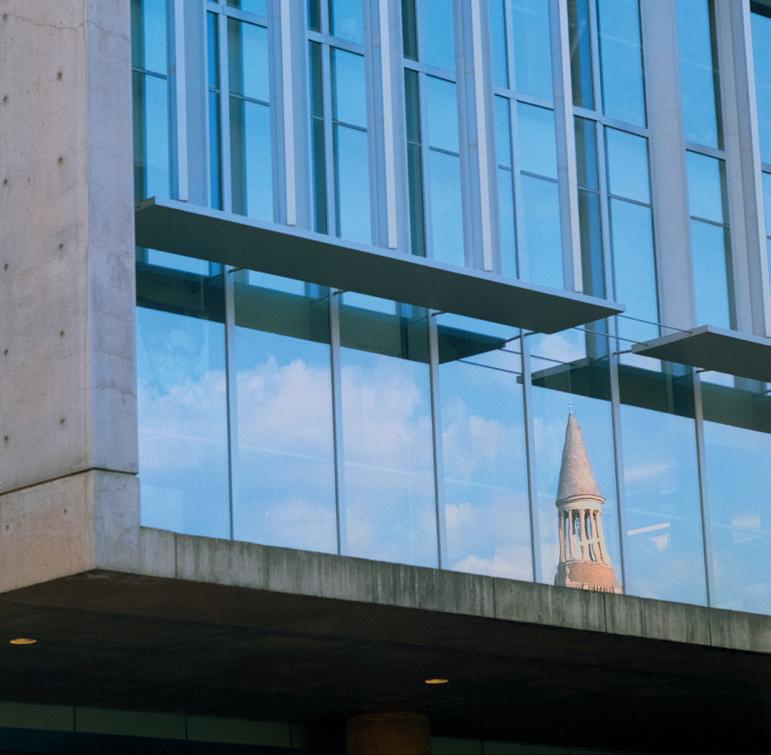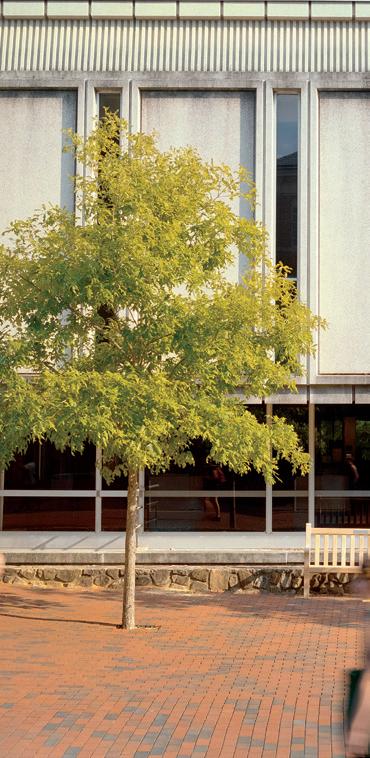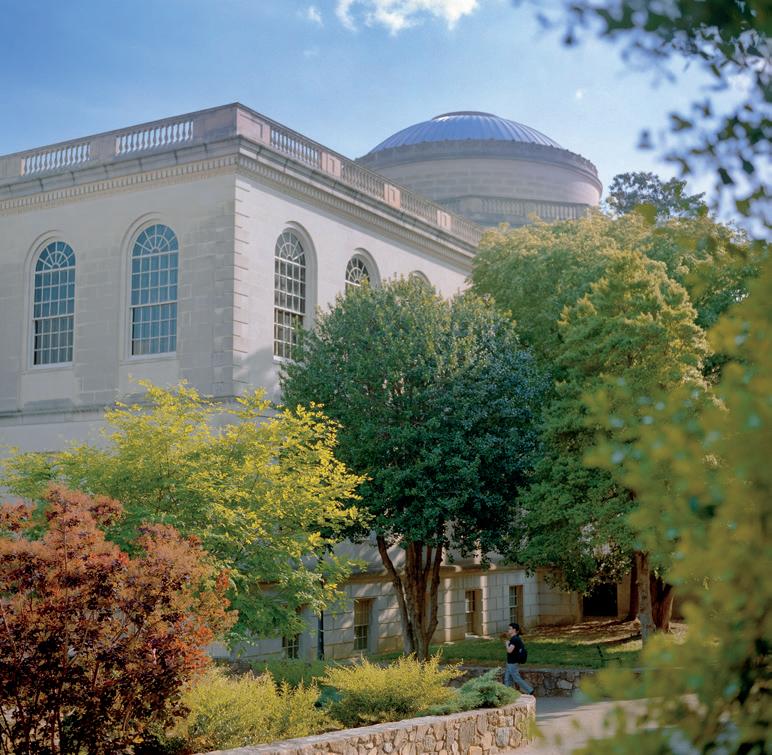
















Because of your generosity, the Campaign for Carolina raised more than $5 billion for students, faculty, research and patient care at the University of North Carolina at Chapel Hill. Explore the impact of the campaign and the ways your gifts are changing lives on campus and around the world. The stories ahead offer just a glimpse of the University’s extraordinary future.

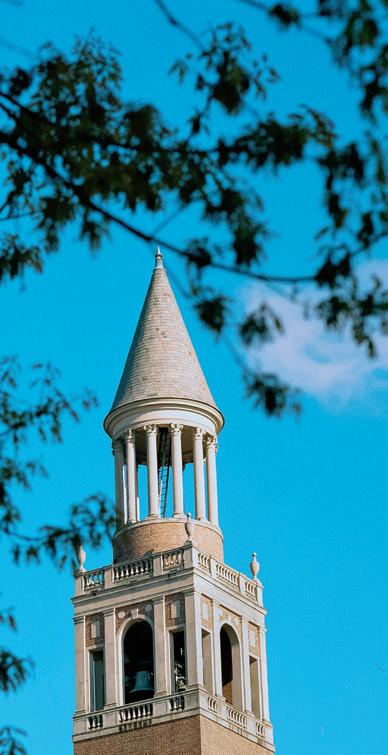
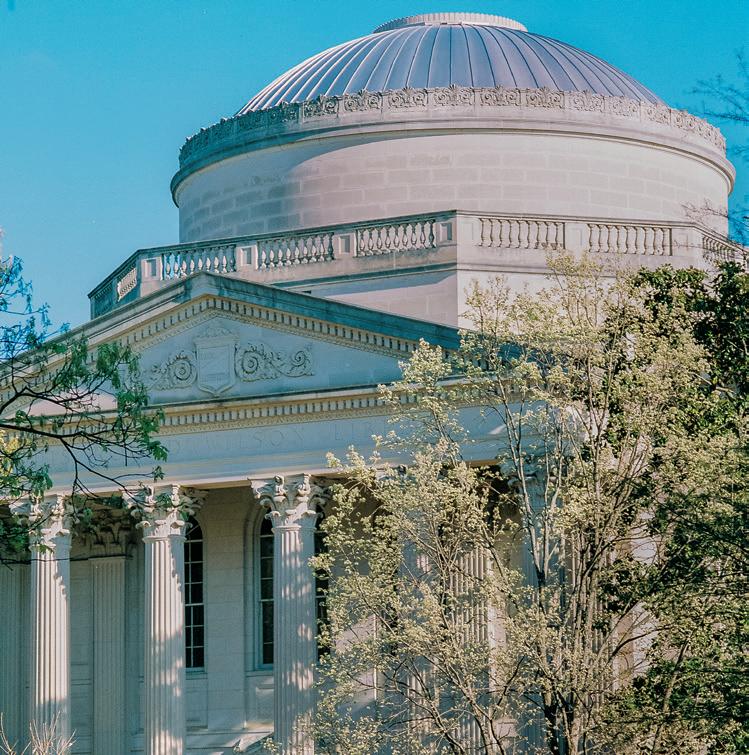

A stronger future 8
Almost 20 years on, the Carolina Covenant continues to have a dramatic impact on campus and beyond.
Lessons beyond the field 42 A stadium bears her name, but Karen Shelton’s most important legacy is the women she coached.
New and improved places and spaces 54
See how Carolina’s historic campus is being infused with state-of-the-art buildings and facilities.
Meet the faculty 66
From advances in drug discovery to the study of authoritarian regimes, Carolina faculty are driving discovery and innovation.
Cell by cell 76
A Carolina researcher explores stopping viruses — but with a catch. By not focusing on a specific virus, he hopes to stop any virus.
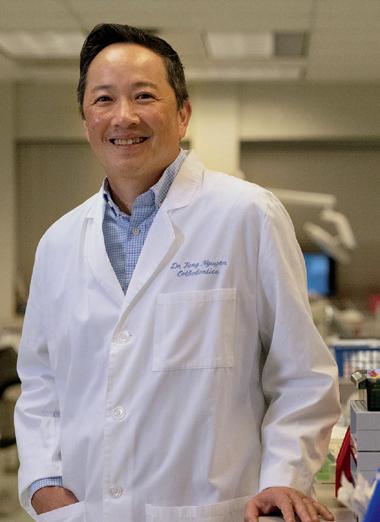
Power Hour 84
Muscles expand, hearts swell and a community thrives — and it’s all happening at this fitness class for young adults with autism.
The new drug of choice 94
Disrupted sleep, lack of concentration, altered social behavior and a decreased desire to exercise: Are smartphones rewiring teenagers’ brains?
Helping veterans THRIVE 122
Veterans share how a new program at Carolina is giving them the answers — and the hope — they need to heal.
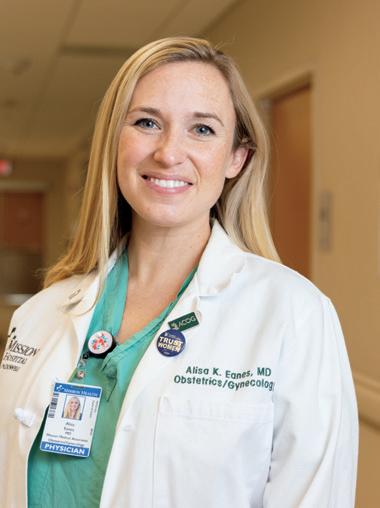
10 things we love about Arts Everywhere 142
Short story dispensers, murals, live music and more — the arts are truly everywhere at Carolina.


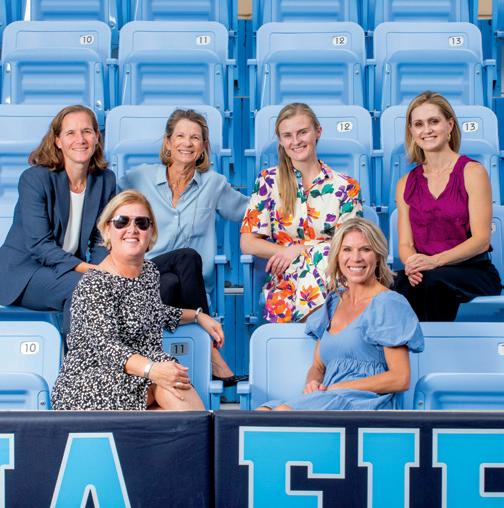
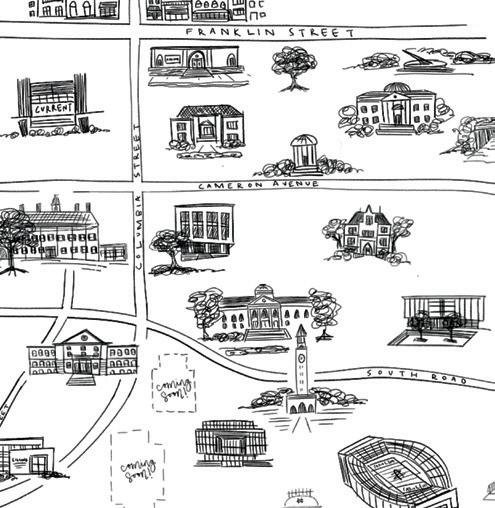
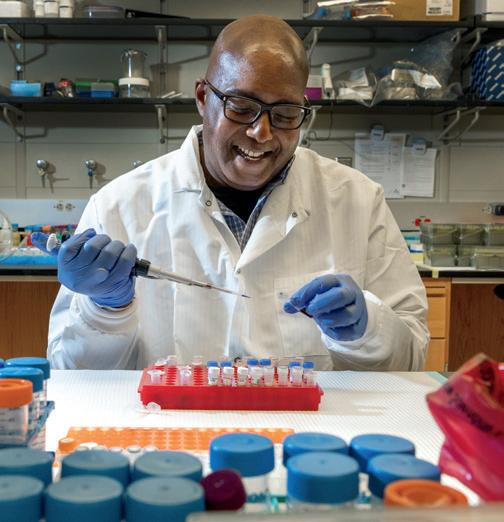


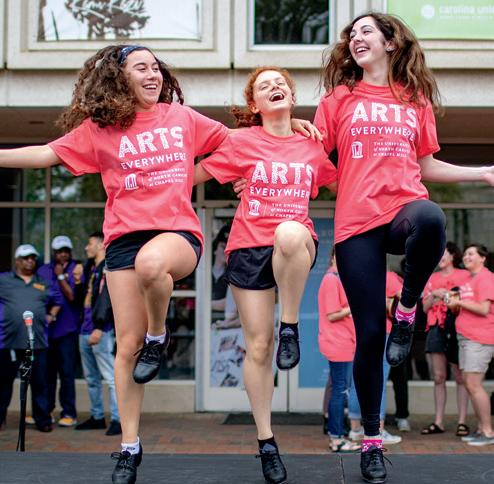
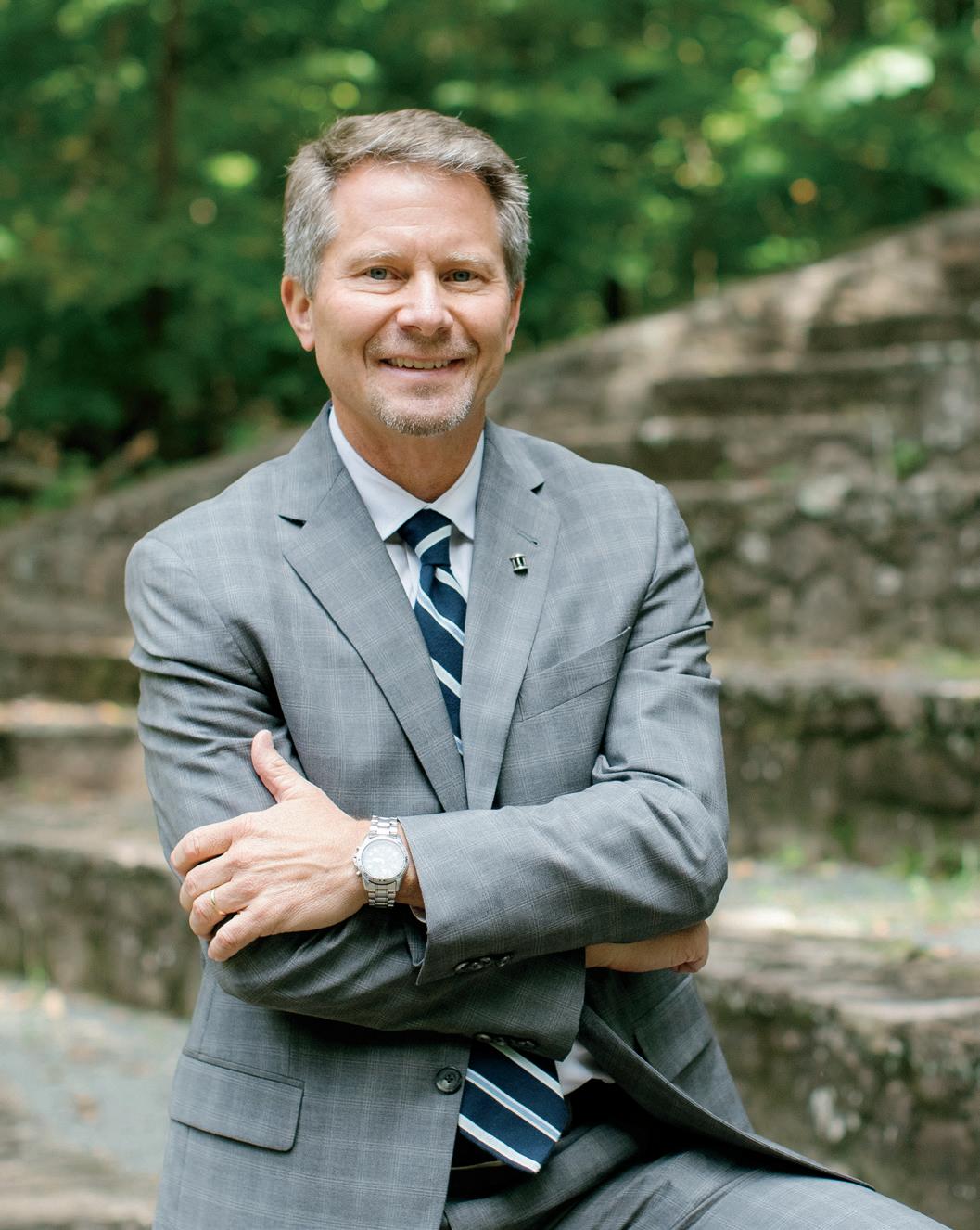
Thank you for your support of the Campaign for Carolina, which concluded at the end of 2022 as the most successful fundraising campaign ever at the University of North Carolina at Chapel Hill. This campaign has shown how Carolina has a selfless community that cares deeply about the University’s future.
Your generosity helped raise more than $5 billion for Carolina and has shattered fundraising records at our University and in higher education. We are one of just six public universities in the country to hit this milestone during a completed fundraising campaign, and we are the only university — public or private — in the South to do so.
The sheer numbers are staggering, but an even more important measure is the impact you have had on the lives of people in North Carolina and around the world. This magazine is a celebration of the difference your generosity, alongside public funding from the state of North Carolina, is making for talented students, world-class faculty and the people who benefit from having brilliant innovators and problem-solvers tackling the biggest challenges our world faces.
The images and stories that follow in these pages are possible because of you. They are the perfect illustrations of the profound and transformational impact of your support for Carolina. You have helped create a brighter future for this University and the brilliant minds who come here with tremendous potential and aspirations to make the world a better place.
Thank you,
 Kevin M. Guskiewicz Chancellor, UNC-Chapel Hill
Kevin M. Guskiewicz Chancellor, UNC-Chapel Hill
Established during the Campaign for Carolina, the Blue Sky Scholars Program opens opportunities for Carolina students from middle-income families.
The Blue Sky Scholars Program started as the vision of Erskine Bowles ’67, who recalled meeting with hardworking, middle-income parents during his tenure as UNC System president. Many felt that college was out of reach for their children because of cost.
“What they couldn’t live with is that they felt their own children were going to miss their shot at the American dream, that they weren’t going to be able to afford to go to college,” Bowles said. “So I decided to do something about this.”
Established in 2018 with an initial gift from Bowles and expanded through gifts from hundreds of donors, the Blue Sky Scholars Program gives Carolina students
from middle-income, North Carolina families scholarship support, work-study employment opportunities, an enrichment award to support internship or study abroad opportunities, and access to academic, personal and career support. As of the start of the 2022–23 academic year, 40 Carolina students had received Blue Sky Scholarships.
Brenda Palacios Rodriguez ’24 said her Mayan heritage instilled an appreciation for nature and its ability to foster reflection and mental wellness. As a first-generation student, she discovered that majoring in environmental studies and art would blend her passion for green spaces and creativity that speaks to people. She plans to pursue a career in landscape architecture, focusing on outdoor spaces and greenways that help people find connection with nature, especially during unique or challenging times. The Blue Sky Scholars Program is helping her follow those passions and partake in career-enhancing experiences such as studying abroad in northern Spain, where she took art classes and hiked the ancient Camino de Santiago.

“It was a life-opening opportunity,” Palacios Rodriguez said. “I was able to understand more about myself and think about how I can have an impact. It helped me understand what lies ahead, and it wouldn’t have been possible without my scholarship.”
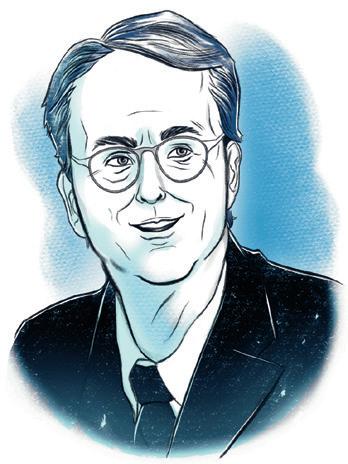
As one of the very first students to be awarded a Blue Sky Scholarship, Delancy Allred ’20 knew she wanted to pursue a career that would help students and teachers. Having grown up in a family of teachers in Jamestown, North Carolina, Allred had always placed a high value on education.

The Blue Sky Scholars Program helped her participate in an honors seminar in Washington, D.C., where she also interned at the Autism Society of America (ASA). After graduating, Allred served as a special education teacher in Baltimore Public Schools and then returned to ASA as a policy coordinator.
“The internship led to a full-time position in an organization where I can make a difference,” Allred said. “The way my life has turned out wouldn’t have been possible without the Blue Sky Scholars Program.”
By Drew Guiteras ’00The Blue Sky Scholars Program helped Delancy Allred ’20 land an internship — which later turned into a full-time job.
“What they couldn’t live with is that they felt their own children were going to miss their shot at the American dream, that they weren’t going to be able to afford to go to college. So I decided to do something about this.”
— Erskine Bowles ’67
THE CAROLINA COVENANT EXPANDS SCOPE AS THE PROGRAM APPROACHES 20 YEARS OF SUCCESS.
By Angela Harwood • Photos by Jen Hughey • Illustrations by DeCarlos Hickson ’20Alisa Eanes
went from not knowing any doctors to becoming one.

Alisa Eanes ’08, ’15 (MD) wanted her career to serve a need. “The Carolina Covenant made such a big difference in my life,” said Eanes, an obstetrician-gynecologist in Marion, North Carolina. “I wanted to give that back. I felt like the people of North Carolina had contributed that safety net for me, and there are so few rural physicians and very few rural OB-GYNs. Marion felt like a place where I could pursue my passion but also provide a big service to the state.”
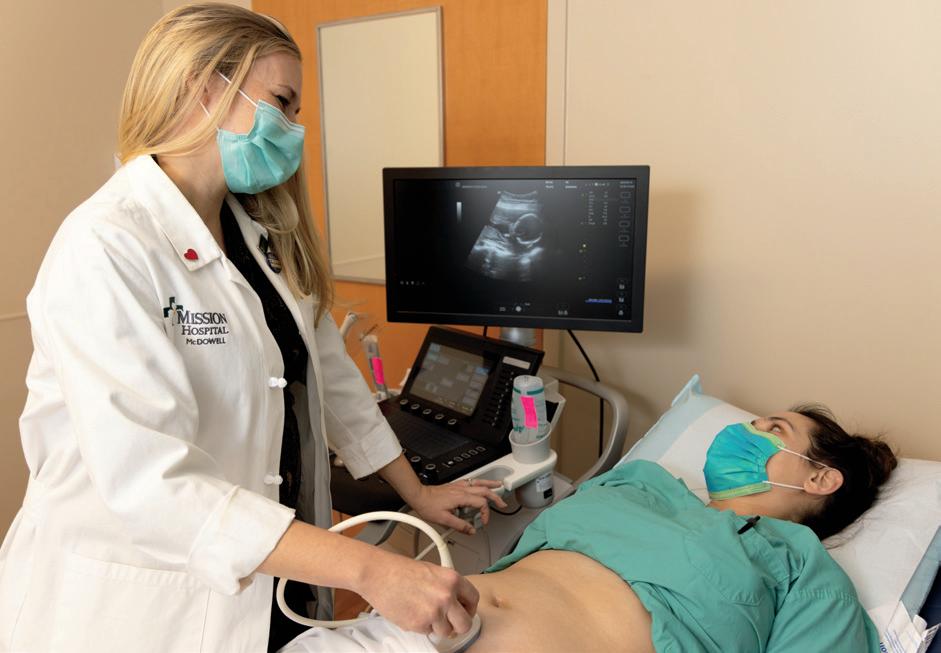
Eanes was born in California but moved to North Carolina at age 11. Both of her parents were from the Appalachian Mountains in Tennessee. She went to high school outside of Charlotte and had begun applying to colleges when she hit a roadblock.
“That was a particularly rough time in my family,” she recalled. “My parents had just gotten divorced, and neither had much income. Combined they made ends meet, but separately they weren’t able to financially support me. So I became a bit of a nomad. I stayed with my dad part of the time and otherwise with friends while I continued to apply for colleges.”
Eanes started her college studies at UNC Wilmington, “because it was the cheapest place I was accepted,” she said. She soon made the decision to transfer to UNC-Chapel Hill.
“I thought, ‘If I get accepted, I don’t know how I will afford the extra tuition.’ I’d been working my whole time at UNC Wilmington, waiting tables and working full-time in the summers to pay for college, and I had taken on some debt already. But then I got a letter from Carolina saying I had been accepted into the Carolina Covenant and my tuition would be free. I was totally overwhelmed.”
At the time, Eanes knew nothing about the Carolina Covenant, which had only just launched in 2004. The program offers outstanding low-income students a debt-free path to graduation through a combination of grants, scholarships and work-study.
“I experienced college both when I was financially responsible for everything myself and when I had the support of the Covenant,” recalled Eanes. “I went from being constantly stressed about financial planning and dedicating all my time to making enough money to pay for my needs to being able to actually engage in campus life.”
Perhaps it was fate: Eanes’ work-study position was in the Department of Obstetrics and Gynecology at UNC Hospitals. “I was filing paperwork and answering phones, and then I started participating in some of the research studies,” she said. “It ended up being my first job after graduation, doing research there.”
Eanes said she hadn’t considered medicine as a career path until she came to Chapel Hill. “No one in my family was a doctor or is a doctor, and I had never even met a doctor,” she laughed. Covenant Scholars have access to mentoring, academic and personal support services. The late Charlie van der Horst, former professor of medicine and internationally renowned HIV researcher, was one of Eanes’ mentors.
“He was active in the Covenant when I was coming through school, and I got a lot of encouragement from him that I could do it — become a doctor — which I really needed. Having someone in the field look at me and tell me that I was capable gave me the confidence to pursue medicine. He helped me navigate the MCAT, the pre-requisites, the volunteering — all the important steps that are hard to figure out without inside knowledge.”
Eanes kept up with her science classes to make sure her options remained open. She volunteered at the local rape crisis center and became a doula (a birth support coach). She even found time to start a student organization to support transfer students in their transition to Chapel Hill.
“All of those things helped me formulate my interest in helping others and in gynecology and medicine,” said Eanes.
After double-majoring in women’s studies and psychology and minoring in chemistry, Eanes enrolled in medical school at Carolina. Her OB-GYN rotations solidified her career path.

“I felt like I could be an advocate for women in a space that is deeply personal and private,” she said.
“Helping them navigate some of the best and worst days of their lives — that connection felt intimate, and I was very interested in rural health care and access in North Carolina.”
Today, Eanes works with two other ob-gyns and three midwives at Mission Hospital McDowell. She sees patients for routine prenatal and gynecological care, and she’s on call every three days, delivering babies.
“Most of my patients are born and raised and stay right here in McDowell County,” she said. “It’s a tight-knit community that’s been here a long time, and it feels really cool to be able to provide excellent care within my rural practice setting. Rural hospitals around the country have been closing, mostly due to financial issues, but ours is thriving. To be part of that feels like an exception, and it’s exciting.”
“At Chapel Hill, I was able to grow and blossom as a student, and that left me the space to figure out what I wanted to do with my life.”
Since Eanes’ time in the Covenant, the program has steadily expanded — from an initial class of 233 students to approximately 10% of Carolina’s entire undergraduate population. The program is also evolving to meet the needs of current students.
When Eanes was a student, its primary focus was to help students financially and provide them with the support and mentorship to graduate on time.
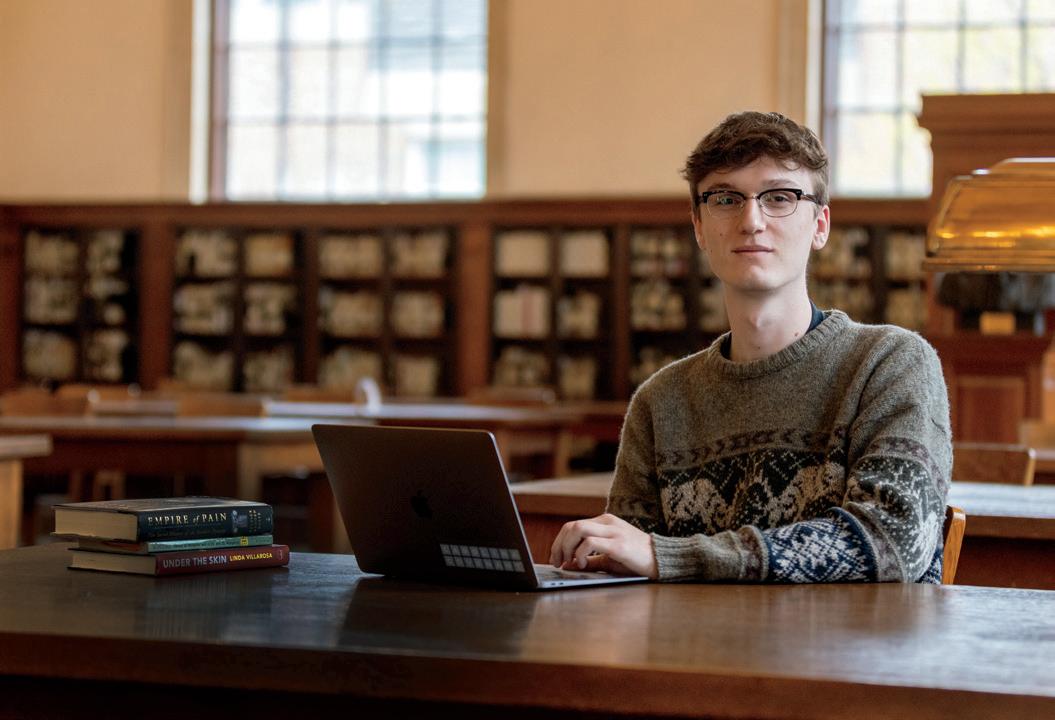
“The Covenant was a groundbreaking initiative to ensure that Carolina could recruit and retain talented students, no matter their income,” said Candice Powell ’06, ’21 (PhD), director of the Carolina Covenant. “In founding the Covenant, Carolina became a national model for low-income student success — those quantitative outcomes are evident. We have demonstrated the dramatic increase in student retention and graduation rates for this population of students.
“But the Covenant program isn’t static,” Powell continued. “It is now our responsibility to help students thrive beyond degree completion. We are building on the network of the thousands of Covenant alumni, like Alisa, who can provide that full-circle investment to connect with one another and help new Covenant Scholars make the most of their careers.”
With support from the University, senior administration and many campus partners, Powell has spearheaded the Connecting Carolina Covenant Scholars initiative, a robust system of professional development for students that includes career mentors and liaisons at all of Carolina’s professional schools.
For example, with the help of the Carolina Covenant’s Rural Medicine Pathway Program, Kainat Aslam ’21, ’25 (MD) is now a medical student fulfilling her dreams to become a doctor. The program is a collaboration
between the Covenant and the UNC School of Medicine that supports Covenant Scholars as they pursue health careers in rural areas.
Much like Eanes, Aslam is already thinking of ways to give back. While in medical school, she hopes to mentor undergraduates in the Rural Medicine Pathway Program. “I’m proud of where I am and of the work that has gotten me to this point,” she said. “I’m still at the first step but also want to remember to give back and to help other people on that journey as well.”
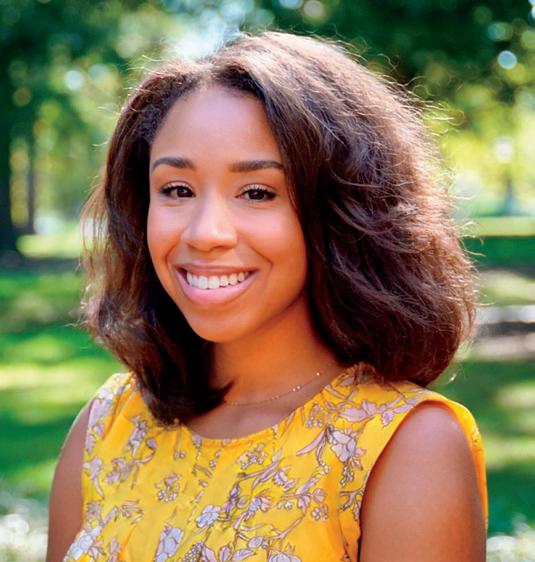
Sonny Griffith ’23 also has his sights set on medical school with the eventual goal of working in rural family medicine. He spent the summer of 2022 taking part in the Covenant’s Career Accelerator Program, thanks to a grant from Strada Education Network. The program makes internships, research, service- and globallearning opportunities more accessible to Covenant students over the summer months when less financial aid is available, a situation that causes many students to forgo career-enhancing experiences in favor of less meaningful jobs to cover expenses.
Griffith used the funding to support himself while he researched historic treatments for opioid addiction. “It gave me the opportunity to travel and network that I wouldn’t have had otherwise,” he said.
Of course, not all Covenant students pursue medical degrees, and mentorship plays just as important a role in other career fields. Of currently enrolled Covenant students, the top five majors are biology, psychology, computer science, exercise and sport science, and business administration.
Carolina Covenant alumni, who boast significant academic and professional achievements, are part of the story of the Covenant’s success. They’re also great mentors. That’s why another new aspect of the Covenant is the Carolina Covenant Alumni Advisory Board.
“Alumni engagement is critical to the continued momentum, interest and investment in the Covenant and to sustaining our current and future scholars,” said Powell.
– CANDICE POWELL
“The benefit of the Covenant is that it is not just financial aid. It’s a facilitator of highimpact opportunities and connections that help students apply their talents and gifts in a way that will help them fulfill their purpose in the wider world that we all share.”


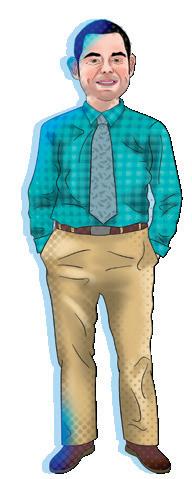
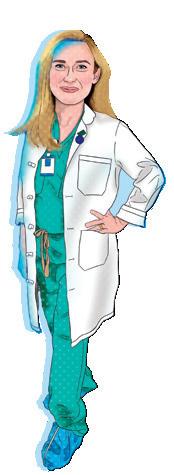 BRIAN WOODARD ’09 Assistant Director for Admissions Chapel Hill, NC
ALISA EANES ’08, ’15 (MD) Obstetrician-Gynecologist Marion, NC
CHARLES W. HANDS III ’14 Attorney Charlotte, NC
MARIBEL BORGER ’14 (CHAIR) Chemistry Instructor Chapel Hill, NC
BRIAN WOODARD ’09 Assistant Director for Admissions Chapel Hill, NC
ALISA EANES ’08, ’15 (MD) Obstetrician-Gynecologist Marion, NC
CHARLES W. HANDS III ’14 Attorney Charlotte, NC
MARIBEL BORGER ’14 (CHAIR) Chemistry Instructor Chapel Hill, NC
The Carolina Covenant Alumni Advisory Board helps guide strategies to help current and former Covenant Scholars succeed in their careers. The Covenant’s alumni engagement efforts, including the work of the board, are led by Associate Director Ann Trollinger, who has provided support for the program from its earliest years to the present day.
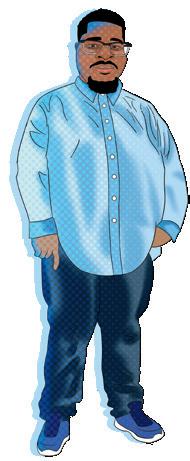


Carolina Covenant alum and advisory board member DeCarlos Hickson ’20 went from working as a security guard while attending community college to a career in animation at a global entertainment company. Scan the QR code to learn more about Hickson’s Carolina Story.
 DECARLOS HICKSON ’20 Junior Designer Los Angeles, CA
AMAYA MARTINEZ MESA ’17 Medical Student Chapel Hill, NC
DECARLOS HICKSON ’20 Junior Designer Los Angeles, CA
AMAYA MARTINEZ MESA ’17 Medical Student Chapel Hill, NC
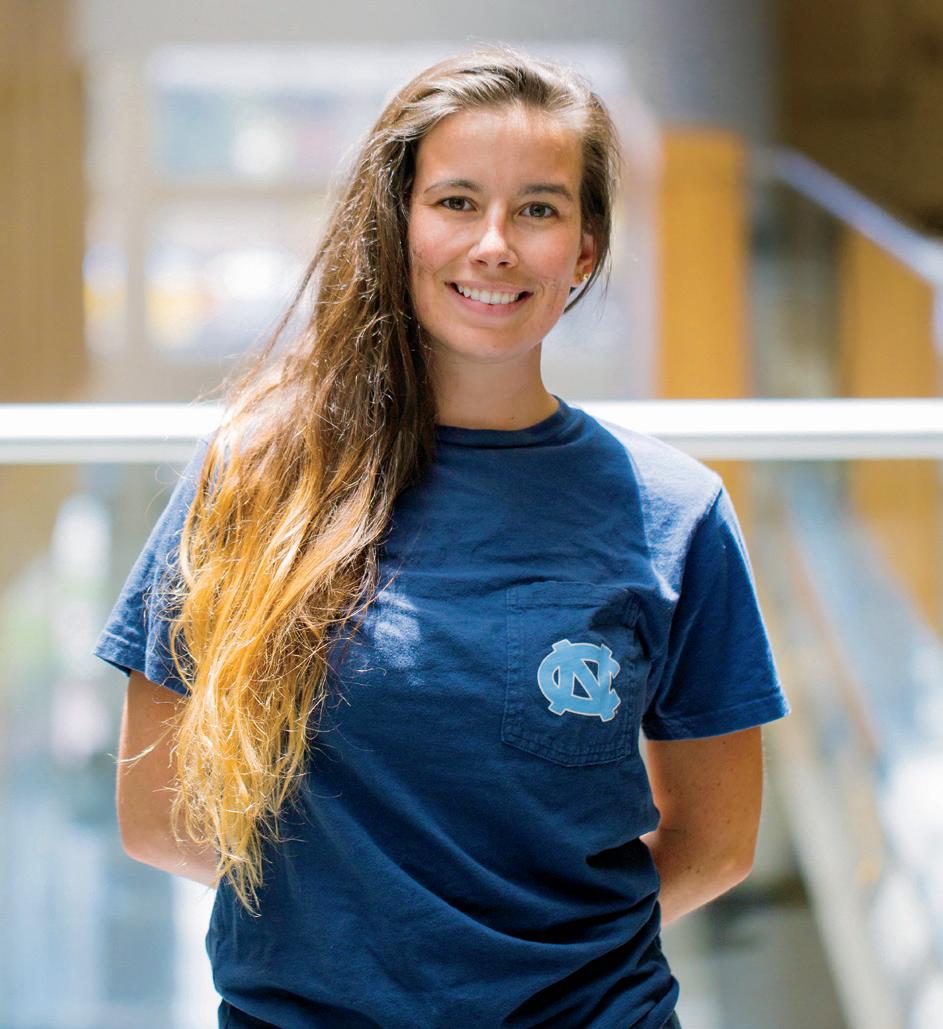 Corinne Light ’20, daughter of a former Navy SEAL, is the first in her family to graduate from a fouryear university.
Corinne Light ’20, daughter of a former Navy SEAL, is the first in her family to graduate from a fouryear university.
Steve and Debbie Vetter grew up in Marine Corps families, went to the base high school at Camp Lejeune, North Carolina, and then Carolina, graduating together in 1978. They understand the sacrifices that service members and their families make, both in serving their country and providing for their children’s educations. To help open Carolina’s doors to new generations of military dependents, the Vetters committed $20 million to endow a scholarship fund for students from military families who qualify for the Carolina Covenant, the University’s signature program that gives exceptional low-income students the opportunity to graduate debt-free.
The fund, which will provide scholarships in perpetuity, supported 199 Steve and Debbie Vetter Carolina Covenant for Military Families Scholars in 2022–23. The Vetters’ gift also launched the Red, White and Carolina Blue Challenge, which inspired other donors to create additional scholarships for students from similar backgrounds; in 2022–23, these supported 43 students.
“As military dependents ourselves, we are excited to be able to honor our fathers and our families by establishing this program to benefit the loved ones of military service members,” Debbie said. “Too often, we forget the many sacrifices made by the families of the military, and we hope this program will, in some small way, say thank you to those families.”
It certainly did for Corinne Light ’20 and her family — in a very big way.
Corinne almost wasn’t a Tar Heel, but it wasn’t for lack of talent or initiative. Unlike many of her classmates in Elizabeth City, North Carolina, Corinne knew she wanted to go to college. Carolina wasn’t a traditional choice for high school seniors in her area; many felt they either wouldn’t or couldn’t get in, or it was too much of a financial stretch for them or their families. Corinne saw things differently.
Though she applied to a dozen colleges and universities, earning admission to all of them,
Corinne will tell you Carolina was her “reach” university. The daughter of a former Navy SEAL and the middle child of five, she was a first-generation college student and the first in her family to attend a four-year university. She was over the moon when she learned she’d been accepted to Carolina but feared she didn’t have the money to realize her dream. Carolina put her fears to rest.
She arrived in Chapel Hill as a Carolina Covenant Scholar; a Vetter Carolina Covenant for Military Families Scholarship secured her place in the program and the opportunities it made possible.
“We were elated when Corinne was accepted to Carolina, and we were determined to do all we could to help her go,” her father Andrew said. “The Covenant relieved a lot of pressure and enabled us to also encourage Corinne’s younger siblings to set and reach for their goals, too. For her to be named a new Vetter Scholar for her efforts, and mine, is deeply rewarding.”
As a Covenant Scholar, Corinne received work-study funding, and she got a job at the UNC Adams School of Dentistry, where she trained as a dental assistant and worked alongside dental students, graduate fellows and faculty practitioners in patient care.
That experience helped Corinne land a dental assistant position at a practice in Cary, North Carolina. She’ll start dental school at East Carolina University in August 2023.
“I’m incredibly grateful for the scholarship I received because I will be going into dental school with no debt from UNC, and it is such a huge relief,” Corinne said. “This scholarship really enabled me to follow my dreams without a financial burden.”
To help cover the cost of dental school, Corinne plans to apply for a scholarship from the National Health Service Corps, which supports primary health care clinicians who want to serve people in the United States with limited access to health care.
“I am so proud of my parents for their hard work in and out of the service, and I want to give back some of what I have been given,” Corinne said. “It’s just the right thing for me to do.”


Major: Chemistry
Major: Biology
Participated in the MD/PhD summer program and studied malaria alongside Assistant Professor Jessica Lin in the UNC School of Medicine’s Infectious Disease Epidemiology and Ecology Lab
Researched environmental toxicology in Professor Rebecca Fry’s lab, studied molecular genetics in Patrick Sullivan’s lab and worked with a postdoctoral researcher in the Eating Disorders Genetics Initiative
Served as vice president of the UNC chapter of Health Occupations Students of America and adult advisor to youth leadership council
Conducted behavioral analyses in mice that had undergone a genetic mutation found in patients with autism during a summer program at Johns Hopkins University
“I always want to know what I’m getting myself into. After experiencing how labs are run, after experiencing countless times of my assays not working the way they’re supposed to and troubleshooting them, I would say I fell in love with it.”
“It has been interesting for me to see successful individuals who look like me. They are my role models, showing me I can get there too — I just have to work for it.”
Housed in the UNC College of Arts and Sciences, the Chancellor’s Science Scholars program offers academic scholarships to encourage talented students to explore their interests in science, technology, engineering and math, ultimately strengthening the STEM workforce through diversity. Scholars — past and present — excel academically and contribute to cutting-edge research with professors at Carolina and beyond.
Helped Associate Professor Mohit Bansal create tools to detect Alzheimer’s disease by using natural language processing
Participated in Helping Hands Projects, which builds prosthetic hands for disabled children
Interned at Facebook, Yelp and Disney, where she improved the chatbot on their app so visitors to the Magic Kingdom could have a better stay
Wrestled for UNC, belonged to the Carolina Table Tennis Club and served as youth leader and Sunday School teacher at a Coptic church

“The Chancellor’s Science Scholars program helped me explore everything I wanted to. The flexibility and support they offered absolutely helped me with all the different projects I worked on. I have CSS and UNC to thank for building that foundation.”
“I saw a lot of injuries going to wrestling competitions, and there are injuries you can’t fix. Giving people restoration of a function would forever change their life. I could give this person a better life. That is a pretty big drive.”
 Sweta Karlekar ’20 Ashburn, Virginia Major: Computer Science
Alex Mina ’19 Baltimore, Maryland Major: Biomedical Engineering
Sweta Karlekar ’20 Ashburn, Virginia Major: Computer Science
Alex Mina ’19 Baltimore, Maryland Major: Biomedical Engineering
Broad support from its community of alumni and friends has helped Morehead-Cain, the first merit scholarship program in the United States, increase the number of scholarships awarded each year. Two matching challenges, Give for Good and Give Together, drew gifts from thousands of donors. Over the last decade, the number of Morehead-Cain Scholars in each incoming class has increased by approximately 50%, from about 50 to about 75 each year.
More scholars in each class means more talented students — such as Kendall Leigh ’25 — come to Carolina and have
an impact from the moment they step onto campus. Before completing her first semester at Carolina, Leigh founded MaxCalKen, a club that gathers over a meal to support students seeking positive associations with food and body image.
Morehead-Cain Scholars also excel academically. In 2020 and 2021, four Morehead-Cains were selected for the prestigious Rhodes Scholarship at Oxford University: Sarah Mackenzie ’20, Kimathi Muiruri ’21, Justin Hadad ’21 and Takhona Hlatshwako ’22.
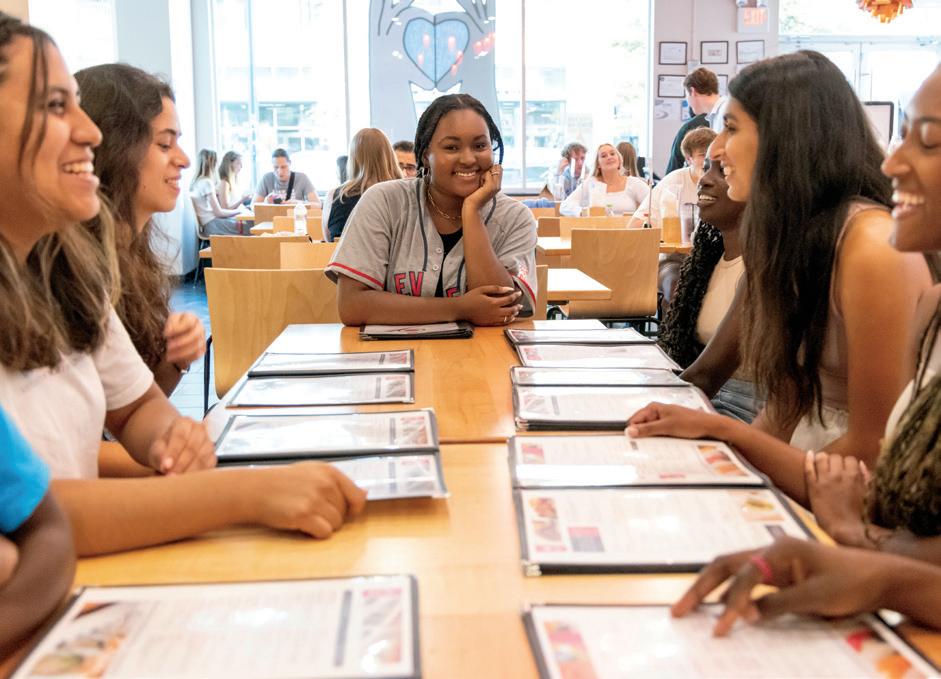
After Richard ’84 and Peggy Batchelder’s two sons, Teddy ’20 and Will ’21, got into Carolina and were thriving in the Honors Carolina program, the Batchelders had an idea.
“We thought, well, we’ve got two sons who are fortunate to go to Carolina. Why don’t we make an opportunity to have two other students go to Carolina without having to worry about paying for it?” recalled Richard Batchelder. The Massachusetts couple created the Batchelder Family Honors Carolina Scholarship to benefit two Carolina students who — like Teddy and Will and the Batchelders themselves — share an interest in business, history or drama.
Richard, a longtime attorney who spent years as the recruiting partner for his law firm, also spent four years as a member of Carolina’s Board of Visitors. That experience showed him the ongoing challenge of recruiting top students to Carolina and the need for additional merit scholarships as one way to help those students choose the best school for them — not just the best school they can afford.
The Batchelders’ decision had an immediate impact. The first two Batchelder Scholars were enrolled as members of the Class of 2022. “It was very rewarding for us,” Richard said. “We felt like we had four kids who went to Carolina.”
One of those “kids” was Sam Hackett ’22, who graduated with a double major in business and sport administration and a minor in history. He also received assured admission to UNC Kenan-Flagler’s Undergraduate Business Program, an accolade given to a small group of high-achieving prospective students each year.
“I was fortunate enough to receive both,” said Hackett, who grew up in a small North Carolina town near Topsail Beach. “I vividly remember getting that news. I delivered pizzas while I was in high school. I had just gotten home from a shift and I read my email. I sat in my car in my driveway crying.”
A lifetime sports fan and high school soccer player, Hackett did his best to avail himself of all the opportunities Carolina — and Honors Carolina — provided. He contributed to UNCUT, a student-led
The Batchelders’ two sons graduated from Carolina. So they doubled down and created a scholarship to benefit two more Carolina students, including Sam Hackett ’22, pictured here.
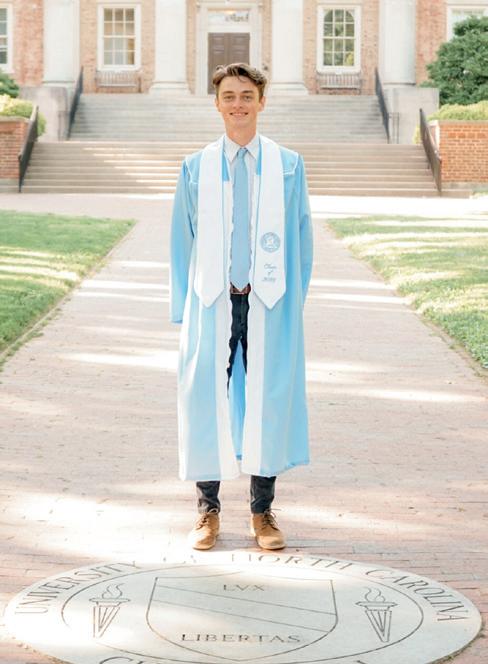
and athlete-driven storytelling platform. He went on a global immersion trip to South Africa over spring break during his first year. And he co-ran the Carolina Sports Business Club and played sand volleyball during the pandemic. He credits Honors Carolina and the Batchelder Scholarship for giving him the freedom to branch out and make the most of his four years in Chapel Hill.
Hackett took the skills he learned studying business and sport administration at Carolina to his new career in tech integration in San Francisco.
By Claire Cusick ’21 (MA)From sciences to the humanities, doctoral students at Carolina engage in groundbreaking research that generates knowledge and advances understanding of our world. Gifts to The Graduate School support Summer Research Fellowships that help them spend a summer focused exclusively on their dissertation research.
FIELD: Music
RESEARCH FOCUS: Social and political definitions of national music
LOCATION: Brazil
IN THEIR WORDS: “My research is about writing histories that I find in archives situated across borders. I try to find a balance between a history of Brazilian music written in Brazil and the way in which this history is received abroad.”
FIELD: Biology
RESEARCH FOCUS: Birdsong of the Lincoln’s sparrow
LOCATION: San Juan Mountains in Colorado
IN THEIR WORDS: “[Investigating] birdsong will elevate our understanding of the myriad ways in which non-human animals communicate and may even have implications in demystifying the evolution of language in humans.”

FIELD: Physics and Astronomy
RESEARCH FOCUS: The quantum many-body problem
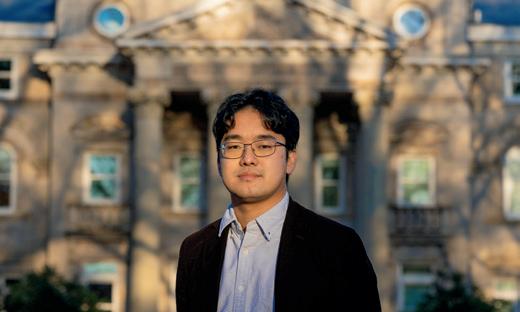
LOCATION: Chapel Hill
IN THEIR WORDS: “I develop methods for teaching computers to analyze what’s called the quantum many-body problem, which is the goal of understanding systems of numerous quantum particles. Those systems occur throughout nature anywhere from everyday materials to inside stars in outer space.”
FIELD: English and Comparative Literature
RESEARCH FOCUS: 19th-century American authors’ depictions of aristocracy
LOCATION: Chapel Hill
IN THEIR WORDS: “I’m looking at the way we conceptualize democracy in America and how that often incorporates elements of the aristocracy that we believe we’ve overcome.”

FIELD: Religious Studies

RESEARCH FOCUS: Ancient Christian cemeteries and martyr graves

LOCATION: Greece, North Macedonia and Croatia
IN THEIR WORDS: “I hope to demonstrate a cooperative negotiation of ritual space and practice between Christian preachers and their audiences in these extra-mural cemeteries.”
3. 4. 5.Wilson White ’06 (JD) created the Essie Mae Wilson Scholarship in 2014, and increased its reach during the Campaign for Carolina. White named the scholarship for his maternal grandmother. Born in 1927 in rural South Carolina, Essie Mae Wilson spent her early years working as a sharecropper. She ended her formal education after sixth grade to help her parents provide for their family. White said, “She was the wisest person I knew.”
The fourth of six siblings, White lived with his grandmother from fifth to 10th grade before leaving to attend the South Carolina Governor’s School for Science & Mathematics. “She did well in terms of raising me,” he said. He now works at Google as vice president of government affairs and public policy and serves as vice president of the Law Foundation at Carolina.

The Essie Mae Wilson Scholarship is awarded to law students with a science, technology, engineering or mathematics background who have an interest in combining law with STEM careers, as White has. Anderson Tran ’17, ’21 (JD), a recipient, has held a fellowship at NOAA (National Oceanic and Atmospheric Administration) Sea Grant, where he had the opportunity to advise two members of Congress on fisheries and coastal resource policy. “There aren’t a ton of STEM students in law school, so receiving the Essie Mae Wilson Scholarship
gave me the confidence that there really was a market for combining science and the law.”
Though Essie Mae Wilson died in 2020, she knew what her grandson did to honor her and the lessons she embodied. White credits her with instilling in him the values of hard work, integrity, humility and a spirit of giving back. “I soaked up all of her knowledge and wisdom.”

The UNC School of Law’s strong ethos of public service really helped him in his career journey, he said. “It was really simpatico with the principle of giving back and the values that were instilled in me as a child. It’s a special place.”
By Claire Cusick ’21 (MA)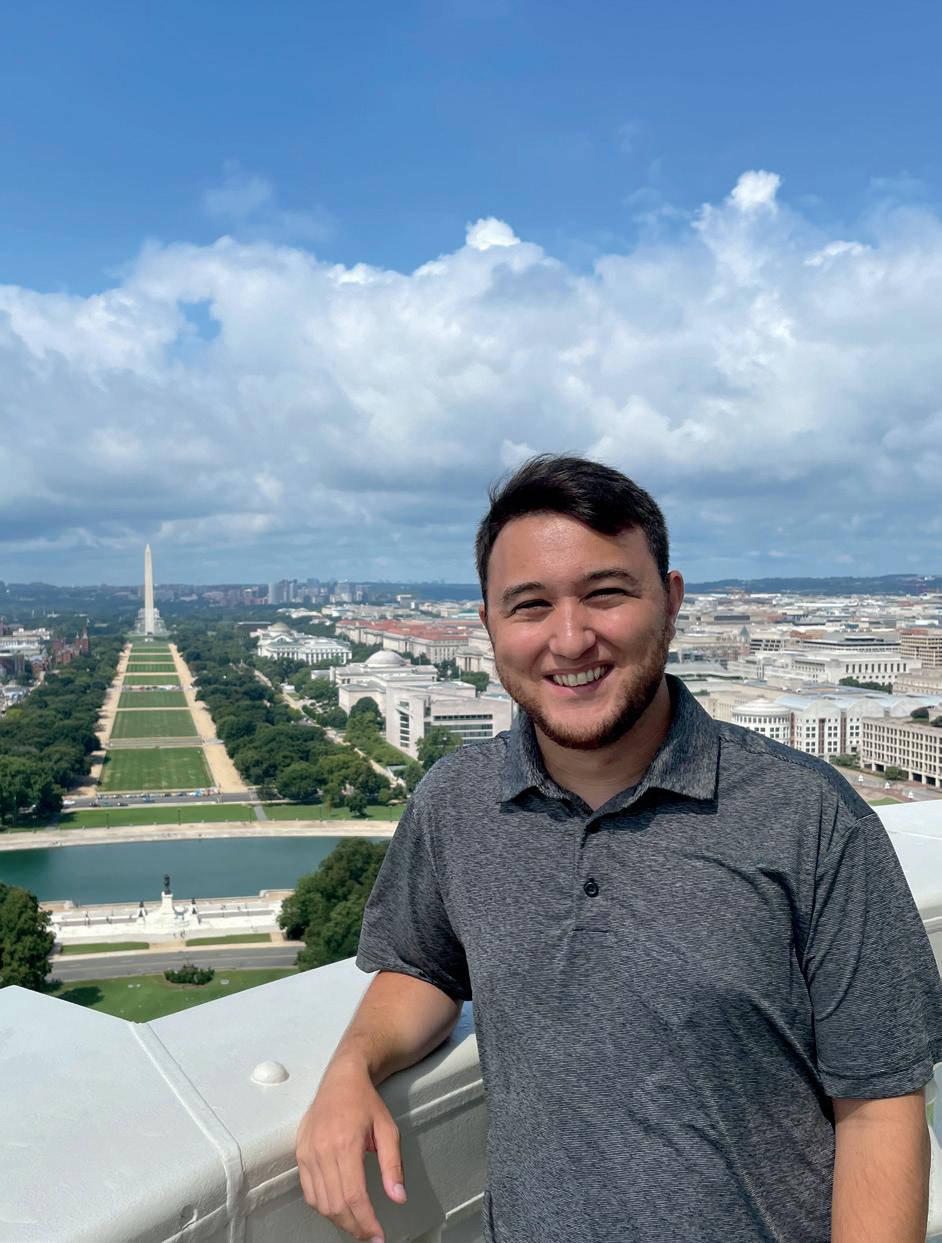
The Campaign for Carolina raised more than $1 billion for scholarships at Carolina, increasing support for graduate and professional students, as well as undergraduates.
Alex Kresovich earned Billboard #1 recognition for his work as a record producer with pop rock band Panic! at the Disco. He moved to Los Angeles to further a career in the music business but eventually “realized that life wasn’t for me” and decided to change direction. On a whim, he applied to the PhD program at the UNC Hussman School of Journalism and Media. He came to campus for interviews and left impressed, describing everyone he met as “amazing.” He returned as a Roy H. Park Fellow.
The fellowship program, which expanded thanks to the Campaign for Carolina, enables UNC Hussman to recruit exceptionally bright, dedicated doctoral students by providing the financial support they need to focus fulltime on their academic and professional development.
“The Park Fellowship was a great support during my time at UNC,” Kresovich said. “It gave me confidence that I was supported in pursuing the types of research questions and ideas I wanted to pursue here at UNC. It showed they cared about UNC being a world-class research institution.”
Kresovich, who graduated in 2022, researched how popular music with references to mental health affects populations with mental health disorders. He now works as a research scientist focusing on health communication at the nonpartisan and objective research organization NORC at the University of Chicago.

A former record producer with Panic! at the Disco, Alex Kresovich ’22 (PhD) came to Carolina as a Park Fellow.
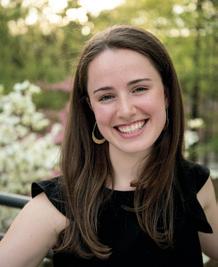
Before pursuing a Master of Arts in Educational Innovation, Technology, and Entrepreneurship (MEITE) at the UNC School of Education, Daisy Magnus-Aryitey worked as a full-time software developer — a career path illuminated by Code the Dream, a nonprofit that teaches students from diverse backgrounds the technical skills needed to launch a career in coding.
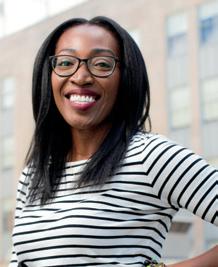
Her time in the MEITE program — made possible by the Moise A. Khayrallah Innovation Fund — provided her the tools and flexibility to increase much-needed diversity in the technology fields’ workforces. After graduating, she returned to Code the Dream as its co-executive director, applying practices in innovation to achieve personal and professional missions.
“People think that innovation is just magical thinking, a fever dream, or a great idea that springs out of nowhere, but the MEITE program proves innovation is actionable,” Magnus-Aryitey said. “Innovation exists everywhere, and we need only tap into it to better our society.”
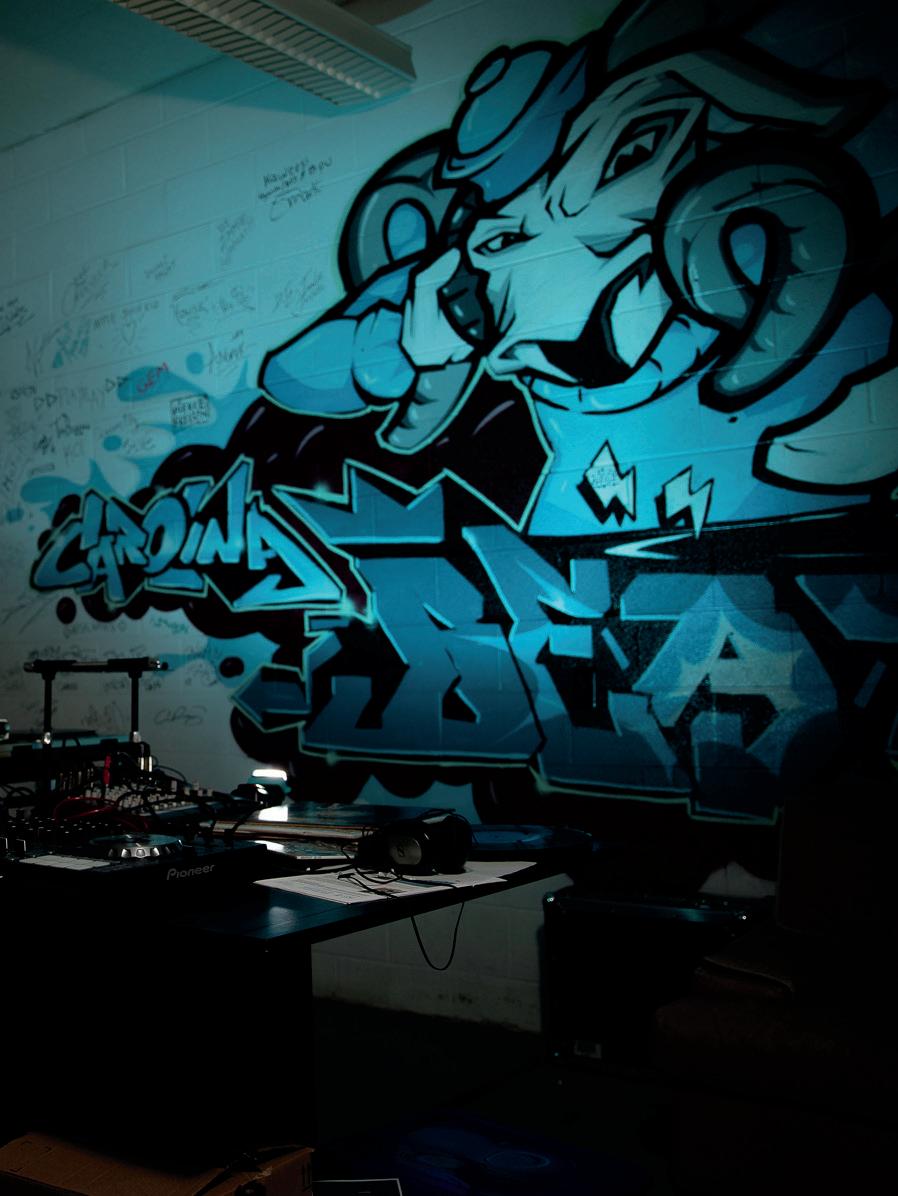
Lucius Blanchard Carolina Family Scholar
The rigors of medical school are difficult enough under normal circumstances, and those challenges were only compounded for medical students forced into virtual classes in 2020 at the onset of the COVID-19 pandemic. Celia Mizelle, a Lucius Blanchard Carolina Family Loyalty Fund Scholar, found connection and support from all directions, whether it was directly through the school’s town hall meetings, from the Blanchard Scholars administrators or through fellow students.
“Everyone was so impressed by how the school transitioned to virtual learning,” Mizelle said. “I felt really confident and happy that I had chosen UNC. I never felt like there was an absence of communication.”
Mizelle continued to thrive as medical school returned to a more normal format. She was selected to lead the school’s Clinical Ethics Discussion Group and co-led a student seminar that explored medical ethics at UNC.
The Blanchard Scholarship provides four years of in-state tuition, an interest-free loan of $20,000 a year for four years and an enrichment fund to enhance students’ educational experience.
Tara Jordan’s research illuminates the role that music played in the cultural life of the Monastirli Jewish community from 1912 until 1943. To aid her work, Jordan — a doctoral student in musicology — received two research grants from the Carolina Center for Jewish Studies.
Jews had lived in Monastir, in present-day North Macedonia, since Roman times. The area’s Jewish population increased in the 1500s when many Jews fled the Spanish Inquisition. Beginning in 1941, Bulgaria — on behalf of the Nazi regime — occupied Monastir. In 1943, Bulgaria deported all Monastirli Jews to Treblinka, a concentration camp.
“Monastir was absolutely decimated,” Jordan said. “Percentage-wise, 99 percent of the community was killed. Then the Bulgarian army destroyed the physical location. They bombed the synagogues; they tore down neighborhoods. Pictures and stories are really all that’s left of Monastir. And these songs. I feel a responsibility to document them. These people have touched my life.”
Before World War II, some Monastirli Jews had immigrated to the United States and Jerusalem. It is only because of these communities that there are any memories left of Monastirli culture.
In the summer of 2021, thanks to a Carolina Center for Jewish Studies Graduate Student Research and Writing Grant, Jordan took an extended research trip to Seattle, Washington, and spent time among two Sephardic Jewish communities there. “I’m not Jewish, and I’d never been to a synagogue,” said Jordan, whose PhD research focuses on Judeo-Spanish music. She interviewed community
members and attended services. “That research was foundational and set me up for success,” she added.
In the summer of 2022, Jordan was again helped by a research grant, the Carolina Center for Jewish Studies Christopher Browning Holocaust Studies Research and Travel Grant. She traveled to Indianapolis, Indiana, where a cluster of Monastirli had started a synagogue, Etz Chaim. Jordan attended services, visited congregants and looked through the synagogue’s archives. She found photos from 1910, when two families founded Etz Chaim, and more recent ones showing congregants dancing traditional dances and participating in talent shows.
Alan Cohen, the president of Etz Chaim, identified people in the photos, described the events and even sang some of the Judeo-Spanish songs he grew up hearing. This gave Jordan “huge insight into what kinds of things Monastirlis were singing after they came to the U.S.”
The grant also funded a trip to Washington, D.C., to the Holocaust Museum archives, and to New York City for a week. “These grants did so much for me,” Jordan said. “They have been a huge part of my dissertation research. I have partial drafts of two chapters already, and I would not be that far yet without these grants.”
By Claire Cusick ’21 (MA)Right: The founders’ wall at Etz Chaim synagogue (stained-glass section illustrated here) serves as a constant reminder of the congregation’s Monastirli roots.

Fellowships at the UNC Adams School of Dentistry support dental students and residents who represent the next generation of practitioners and researchers. Many fellowships, including these, are established through generous gifts from Carolina alumni, showing the deep commitment the Adams School community has for fostering future leaders in the field.
A Cobb Fellow in Pediatric Dentistry, Selin Soyupak is also completing a master’s degree at the UNC Gillings School of Global Public Health. In addition to seeing patients in the clinic, Soyupak studies data from NC Medicaid to understand how to eliminate barriers to dental care for children.

“I was a babysitter; I was a 4–H coach; and I’ve always loved working with kids,” said Sarah Morgan ’22 (DDS), a Congleton Fellow in Pediatric Dentistry.
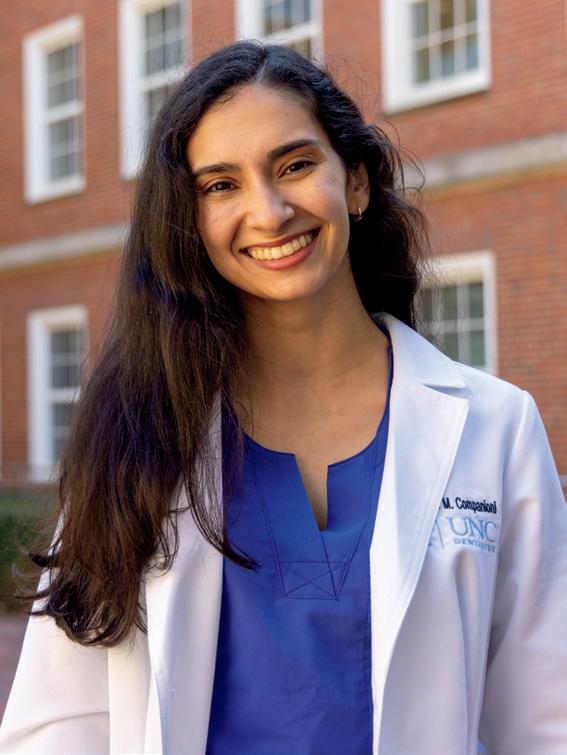
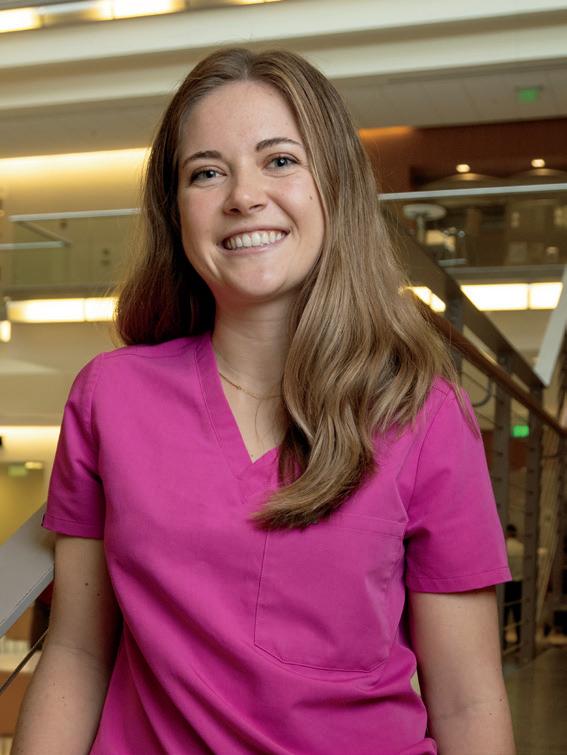
“There is so much hope in pediatric dentistry, and that’s what drew me to it. You can help kids and their parents take better care of teeth and show them how to be healthier.”
A meeting with the team dentist for the NBA’s Miami Heat sparked an interest in sports and trauma dentistry for Stephanie Companioni ’20 (DDS), a Smiley Fellow at the Adams School, where she founded the UNC Sports Dentistry Club. A resident in orthodontics, Companioni coordinates UNC’s Dental Trauma Team, a multi-specialty group that provides consultation and treatment to patients throughout the state.
A few of the values that make the UNC Gillings School of Global Public Health so special are its strong sense of community, its focus on training the next generation of public health leaders and its steadfast commitment to service. For these three longtime faculty members, those values also serve as inspiration to give back.
“I wanted to support students who want to become leaders in biostatistics. One of my goals in creating this fund was to connect with alumni and with people who have worked with me over the years, in hopes that they might think of doing something like this too.”
— Lisa LaVange, professor and chair of biostatistics, The Lisa Morrisey LaVange Scholarship in Biostatistics
“I am so grateful for the many years of being a student and then working with students and communities in North Carolina. The communities have been like my co-instructors. They are just so key to what our students are producing, and I wanted to recognize their contributions to training the future workforce in public health.”
— Geni Eng, professor of health behavior (ret.), The Geni Eng Community Equity Award and Lecture

“As we train the next generation of public health leaders, I’m particularly interested in ensuring some of them are from North Carolina and will use those skills in their home state — because we could and should do better. And because we think that’s really important, Jim [Schenck’s husband] and I wanted to step up to the plate.”
— Anna Schenck, director of the Public Health Leadership Program, The Carolina Home State Public Health Scholars Program
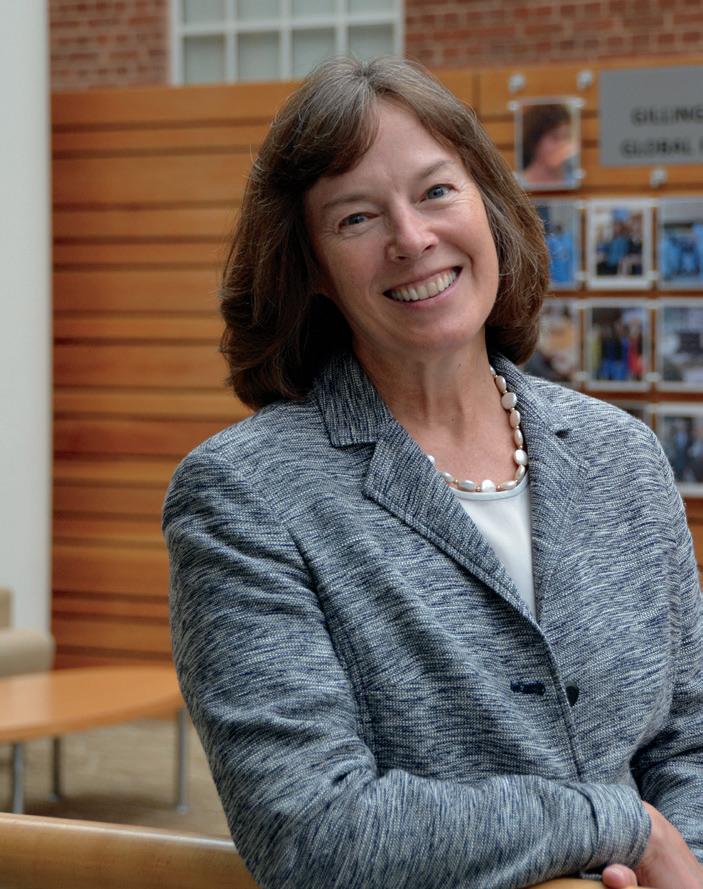
Carolina’s array of programs, internships and educational opportunities prepare students for life and success in an interconnected world. These examples are just a few of the ways Carolina is preparing tomorrow's leaders.
Shadoe Stewart ’22 (DDS), Adams Rural Oral Health and Wellness Scholar, provided care in rural western North Carolina during his dentistry training at MAHEC.
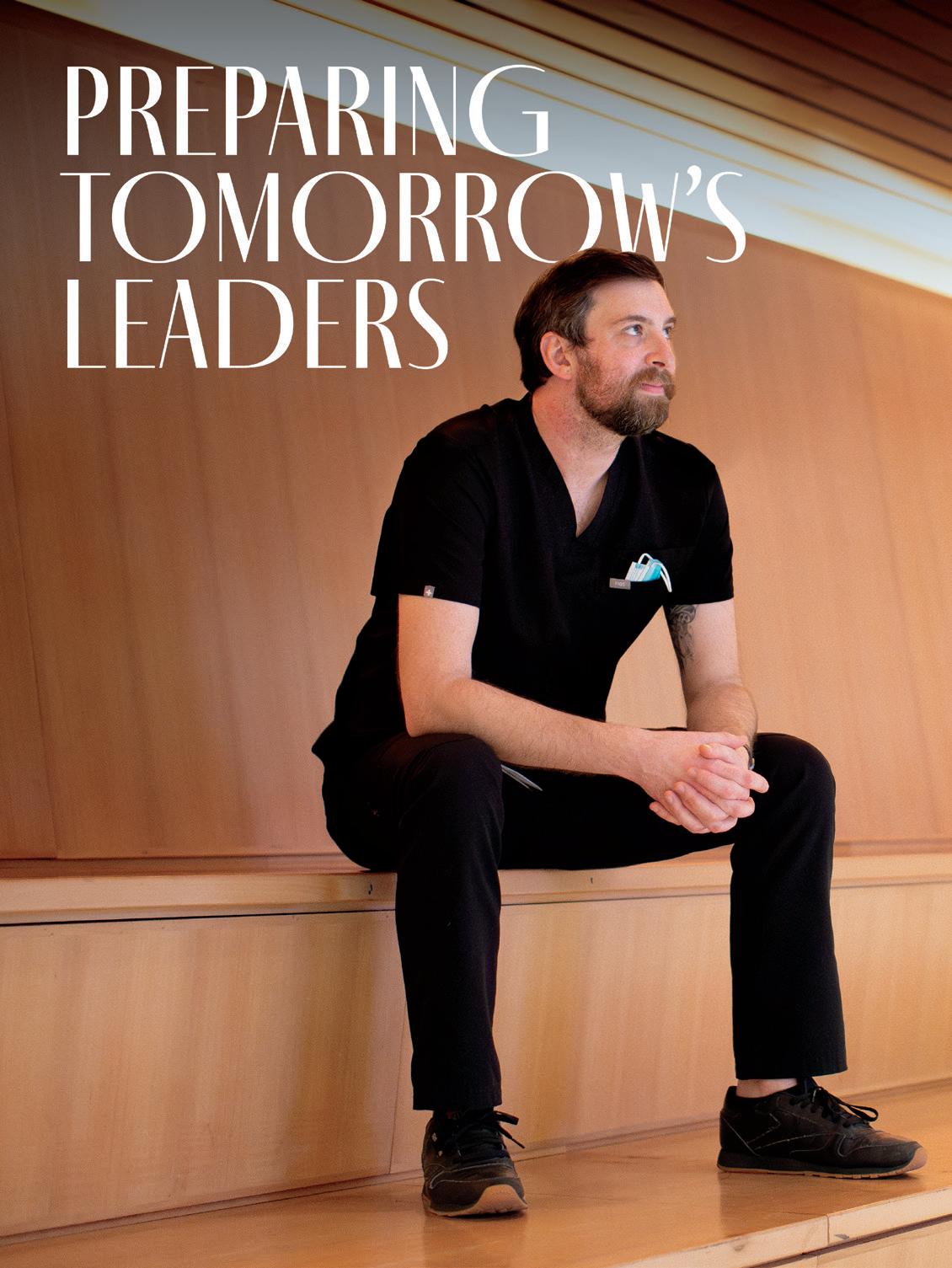

As an Adams Rural Oral Health and Wellness Scholar, Shadoe Stewart ’22 (DDS) completed a six-month residency at the Mountain Area Health Education Center (MAHEC) clinics in Asheville and Columbus, North Carolina. The program, a partnership between the UNC Adams School of Dentistry and MAHEC, enables dental students interested in rural practice to provide care in underserved areas of western North Carolina. It was funded by a gift from Dr. Claude A. Adams III, who also named the dental school in memory of his parents, Dr. Claude A. Adams Jr. and Mrs. Grace P. Adams.
“At MAHEC, it was common to see seven or eight patients a day,” Stewart said. “It was amazing to be at MAHEC in Asheville, which serves as a hub for a lot
of western North Carolina, and then at Columbus, which is a truly rural community.”
UNC Health Sciences at MAHEC provides paths to rural practice by training students and residents from UNC’s schools of dentistry, public health, pharmacy, nursing and medicine in rural settings while sustaining rural providers and transforming rural health. As a Kenan Primary Care Medical Scholar based at UNC Health Sciences at MAHEC, Travis Williams ’20 (MD) spent four months in clinical practice at a hospital and eight months in outpatient clinics. He developed strong relationships with his preceptors — or teaching physicians — solidifying his picture for the future.
“I knew that I wanted to do family medicine, and I knew that I wanted to do rural,” said Williams. “Everything I needed was at MAHEC.”
Fiorela Villegas ’24 is on a mission to give back to her community by bringing resources and opportunities to the Latinx population of North Carolina. She worked with nonprofit AMEXCAN in the summer of 2022 through the State Employees’ Credit Union (SECU) Public Fellows Internship program. She knew she didn’t want to leave her work behind at the start of the 2022 fall semester and stayed on as AMEXCAN’s advocacy and civic engagement coordinator.

Launched in 2020 through the Carolina Center for Public Service, the SECU Public Fellows Intern program pairs students with local leadership for paid internships in rural communities across the state.
“I think if my parents had access to these resources when I was young, it really would have been helpful,” said Villegas. “Oftentimes, people in my community can be shy or too proud to accept resources. Part of our work is breaking that stigma and making it clear that if anyone needs help, we’re available, and we’re willing to help anybody in the community.”
SECU Public Fellows Intern Fiorela Villegas ’24 worked with AMEXCAN.Innovate Carolina’s Dreamers-Who-Do program enables students to transform academic knowledge into tangible, real-world results. Among other ways, students gain practical experience by participating in internships with UNC start-up companies and launching new ventures of their own — often in collaboration with UNC faculty and entrepreneurial experts.
Available to undergraduate, graduate and post-doctoral students, the program also provides support to attend events such as the Ignite Retreat, hosted by the Sullivan Foundation. It connects students with a community of changemakers from all across the American southeast.
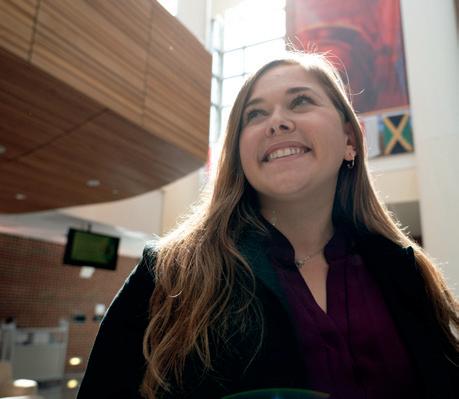
Rachel Ram (pictured top, right) was one of four Carolina students to attend an Ignite Retreat in Staunton, Virginia, as part of Innovate Carolina.
“Attending the retreat allowed me the opportunity to meet other students and young professionals passionate about creating social change,” she said.
Ram, a graduate student in the UNC Gillings School of Global Public Health, said the experience also confirmed her interest in the innovation space. That led her to apply for — and get — a graduate research assistantship at the school’s Office of Research, Innovation and Global Solutions. Ultimately, she aims to advance technology that improves people’s health, as well as reduces costs and enhances access.
The Diplomacy Initiative, created and led by the UNC Office of the Vice Provost for Global Affairs, prepares Carolina students to break down complex issues, identify partners and create effective paths toward solutions. During Carolina’s Diplomacy Week in April 2022, through a policy brief competition, students received expert feedback from Carolina alumni working in international affairs.

Christina Oh ’22 was a member of the competition’s winning team. “The most important thing I learned from the experience was how to be critical of programs and entities that I had previously thought were
uncontested authorities,” said Oh. “It requires a certain level of confidence … to look at an established intergovernmental organization like NATO and be critical of their policies.”
A priority for Vice Provost for Global Affairs Barbara Stephenson, the initiative builds on Carolina’s unique strengths in area and language studies as well as curricula in Global Studies and Peace, War and Defense. Programs like the Diplomacy Initiative have been supported by campaign gifts, including a $10 million gift from Bill ’66 and Anne ’78 Harrison that endowed two senior leadership positions at the Office of the Vice Provost for Global Affairs and strengthened Carolina’s global presence.
Thanks to an $8 million endowment gift from Nancy ’74 and Doug Abbey, the Abbey Speaker Series in the Program for Public Discourse brings to campus experts from different disciplines and fields to foster productive dialogue on timely issues across a range of perspectives. Occurring four times each year, these free and open-tothe-public events have covered topics from the ruralurban divide to the role of social media in politics, from affirmative action to abortion.
“Our events on campus regularly draw 500 people,” said Sarah Treul Roberts, associate professor in the Department of Political Science in the UNC College of Arts and Sciences. “Students are coming — are yearning for this. They want to know how to interact, how to engage and work with people who are different from themselves. They can see people who have very different values and ideas on these contentious topics
have a civil conversation and challenge each other, but also offer respect for one another.”
“Doug and I believe in public education, and that there is no better place than Carolina to model this behavior and develop a Program for Public Discourse that has the potential to impact global decision-making for the better,” said Nancy Abbey.

“Students are coming — are yearning for this. They want to know how to interact, how to engage and work with people who are different from themselves. They can see people who have very different values and ideas on these contentious topics have a civil conversation and challenge each other, but also offer respect for one another.”
— SARAH TREUL ROBERTSCarolina’s nationally recognized undergraduate entrepreneurship program was named the Shuford Program in Entrepreneurship in honor of the Shuford family, who made an $18 million gift to endow the program. Part of the UNC College of Arts and Sciences, it supports students in interdisciplinary academic and applied entrepreneurship experiences, with focused courses in a variety of areas and local and global internships.
“The program is all about opening minds, building confidence, making sure folks can spot opportunity, making sure they understand how to validate that opportunity, scale it and hopefully do something with it that can change the world,” said Bernard Bell ’82, ’91 (MBA), executive director of the program.

Each year, a cohort of Carolina alumni who are industry subject matter experts come to campus as part of the Shuford Innovators-in-Residence Program. The innovators-in-residence speak in classes, hold open office hours and advise students.
“I have never had a class where speakers were so honest and open,” said Vivian Karamitros ’22, a Carolina Innovation Scholar who majored in statistics and analytics and minored in entrepreneurship. “The Shuford Innovators-in-Residence Program gave me the opportunity to speak with high-achieving and personable people about topics I’m interested in. They were so helpful in office hours, sharing their knowledge and helping me with my resume.”
Bernard Bell (third from right) and Shuford Innovators-in-Residence connect with entrepreneurship students after a day of classes.Located on the second floor of the Ackland Art Museum, Ackland Upstairs is a dynamic space where staff collaborate with faculty to support their courses by creating installations that draw from the thousands of artworks stored in the museum’s vaults. For faculty and students, Ackland Upstairs is an extension of the classroom.
“I love teaching in the museum,” said Hérica Valladares, associate professor of classics. “The immediate presence of objects makes the concepts and ideas discussed in the classroom come alive for students. Having a bay [in Ackland Upstairs] dedicated to a specific course makes the students feel very special. It gives them a sense of ownership over these objects and makes the museum their home.”
Throughout the Campaign for Carolina, many donors gifted works of art to the permanent collection or
Elizabeth Manekin ’04, head of University programs and academic projects, instructs students in Ackland Upstairs.
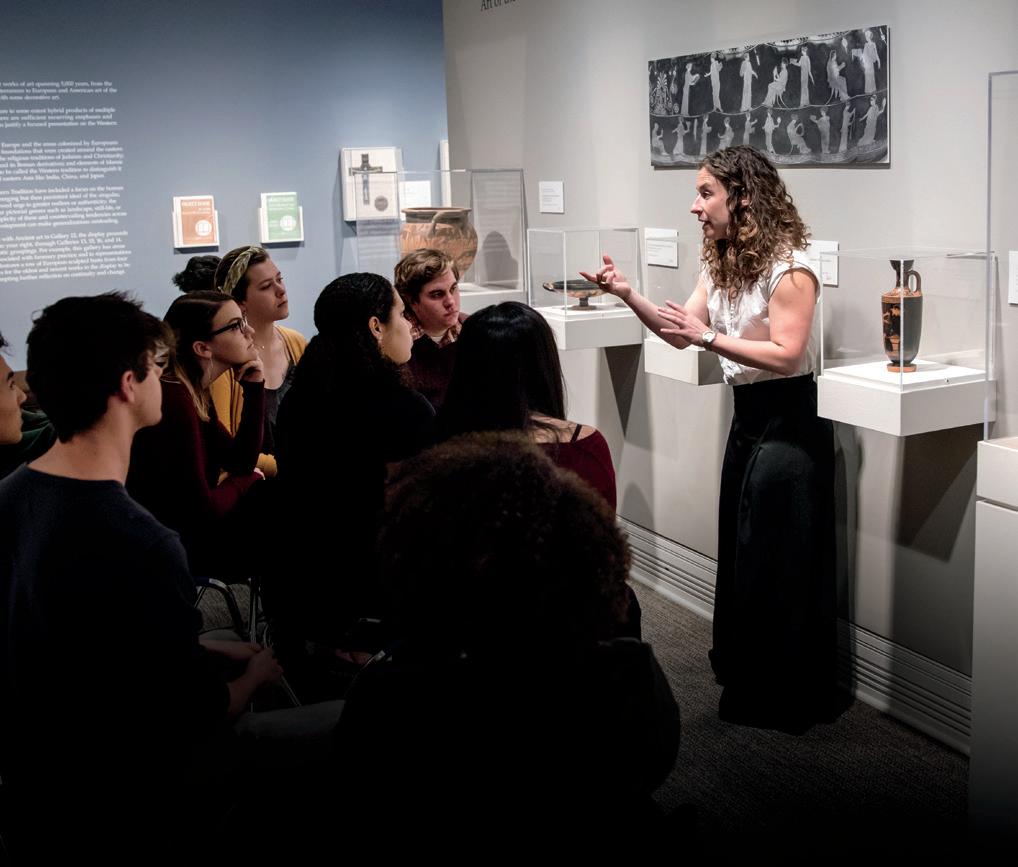
helped the Ackland acquire new works. In September 2018, in honor of these donors and the Ackland’s 60th birthday, the exhibition Birthday Presents featured roughly 60 works of art from 30 different donors, including 13 Carolina alumni. These gifts and others add exciting opportunities for teaching and display within the permanent collection.
“The exhibition for my class in Ackland Upstairs was invaluable to the course,” said Lyneise Williams, associate professor of art history, referring to her art and sports lecture. “I had 120 students in this class and each one made at least three trips to the Ackland for various assignments pertaining to the class exhibition. The immediate access I have to the Ackland combined with the ability to have an exhibition catering to the class is an ideal situation for teaching.”
Joshua Dickens ’18 made a bold choice to change his major from biomedical engineering to environmental studies in the second semester of his junior year.
A class with professors Jaye Cable and Greg Gangi opened Dickens’ eyes to the unique course offerings in environmental studies and the research being conducted at field sites across North Carolina. He knew that handson experience would be critical to his future success, so he made the tough decision to change majors, and he applied to study at the UNC Institute of Marine Sciences Morehead City Field Site the following fall.
Dickens faced an additional roadblock as he planned to change course — at the time, his funding as a Carolina Covenant Scholar did not cover his expenses for studying off-campus.
Dickens reflected that as a first-generation student of color from the small town of Battleboro, North Carolina, he was grateful to receive additional funding from the Betsy Steele and Geo. Watts Carr Environmental
Support Fund. The fund covers students’ living expenses while they gain experience at the Institute for the Environment’s field sites. For students like Dickens, this support makes all the difference.
“Scholarships have been a huge thing for me,” he said. “Opportunities like the ones I have been so fortunate to share are not common for people like me. Even with academic merit, the resources and potential breaks are not plentiful.”
Before his 12 weeks in Morehead City, Dickens had never been on a boat, walked in a salt marsh or conducted research in an actual lab. He certainly had never caught a shark in a boat and held onto its jaw and fins so it could be tagged with a tracking device.
The highlight of Dickens’ time in Morehead City was working on his personal research project with Rachel Noble, environmental sciences and engineering professor and former director of the Morehead City Field Site. Dickens and Noble researched the effects

of Vibrio vulnificus, a water pathogen that can be detrimental to humans through consumption of shellfish. Through his research project, Dickens learned how to use quantitative polymerase chain reaction testing to detect the pathogen in waterways, but — more importantly — he discovered a true friend and lifelong mentor in Noble.

He described her as “a true nurturer in higher education.”
“The experiences and challenges that I encountered, especially academically, were foreign to my family,” he said. “This burden is not simply inherent to the college experience, it’s specific to those, like myself, who are charting new paths with obstacles unbeknownst to their household. Dr. Noble was a welcome guiding hand through the process, and I never felt that I would fall through the cracks. She was there for me and is still there for me today.”
Dickens also interned with the FDA, and since graduating, he has worked as a biotechnology teacher
at a STEM high school and served as a regulatory compliance coordinator for the City of Rocky Mount in North Carolina. He is pursuing a master’s in the urban and environmental planning and policy program at Tufts University and is fascinated by the “intersection between law and the environment.” He ultimately hopes to obtain a law degree.
He has achieved a lot in his four years since graduation, but Dickens credits his time at the Morehead City Field Site for his success.
“It was not until I was selected as one of the students to participate in the Morehead City Field Site that doors began to open and opportunities that were not previously available to me began to present themselves,” he said. “Dr. Noble, Dr. Cable, Dr. Gangi and my field site experience really set the path and were the catalyst for everything else that I was able to accomplish.”
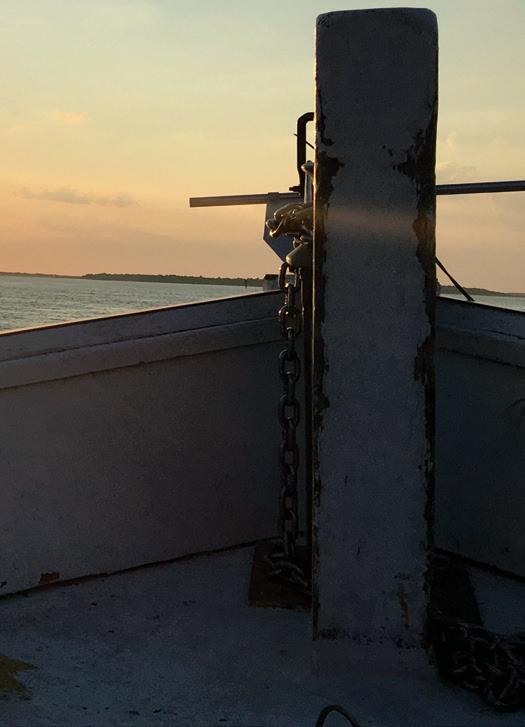 By Felicia Carey
Dickens helped catch and tag sharks for tracking.
By Felicia Carey
Dickens helped catch and tag sharks for tracking.
Field hockey alumnae say that playing for Karen Shelton, and being student-athletes during their undergraduate years, carved lasting legacies in their personal and professional lives.
by Claire Cusick ’21 (MA) and Drew Guiteras ’00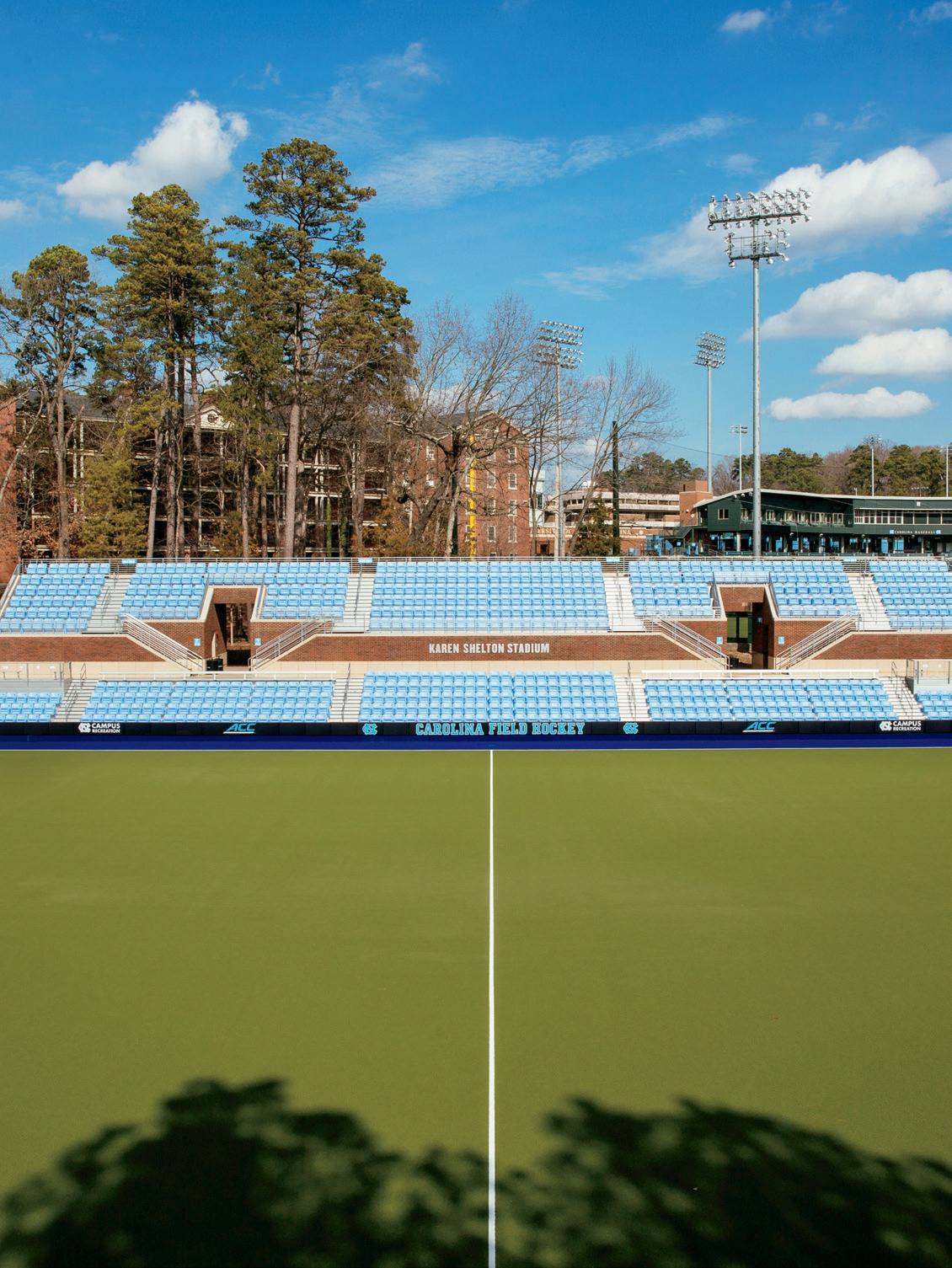
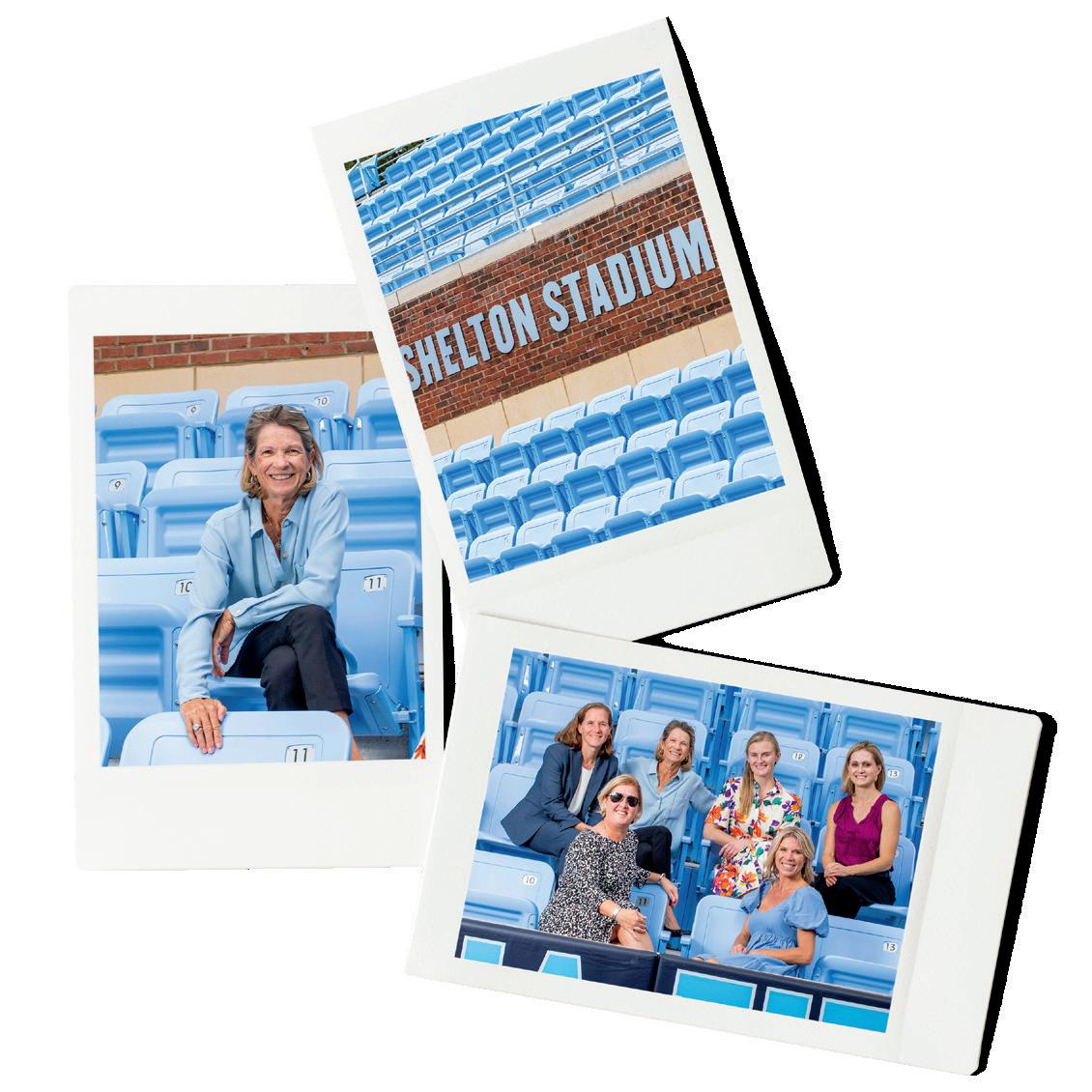



In describing the impact of Karen Shelton, the Hall of Fame coach who steered the Carolina field hockey program for 42 seasons before announcing her retirement in December 2022, there almost aren’t enough superlatives.
Shelton led UNC to 39 NCAA tournament appearances and 10 NCAA championships. With 40 winning seasons and a record of 745-172-9, she retired as the winningest coach in the sport’s history. The Tar Heels went 21-0 in 2022 — the program’s fifth undefeated season — and earned a 10th national championship, the most in Division I field hockey and the fourth in the past five years.
Teams coached by Shelton won more national titles than any other Division I field hockey program has won in its entire history. The 2022 Tar Heel squad ranked among the best to play any sport at Carolina, joining an elite group of 11 UNC women’s teams that have won national championships after undefeated, untied seasons.
On January 31, 2023, UNC-Chapel Hill announced that former Tar Heel field hockey player Erin Matson ’22 would take over as head coach. A three-time team captain and the most decorated player in program history, Matson said that Shelton understood how to motivate and bring the best out of every player. Rather than taking a rigid approach to player development, Shelton would adapt to the needs of the individual.
“She knew I thrived when I was being challenged, so she could be as hard and as harsh as she wanted to on me,” Matson said. “Others might respond more to encouragement or positive reinforcement, so that’s the coaching style she would take with them.”
As Matson takes the reins of the field hockey program, another of Shelton’s ideas that resonates with her is not being constrained by precedent or past accomplishments.
“Never let precedent dictate what you think you can do,” Matson said. “We’ve proven time and time again that we can do things other people cannot. Coach Shelton made sure we understood that in our hearts and were ready to embrace new challenges.”
Karen Shelton Stadium, which opened in 2018, is perhaps the physical embodiment of that healthy disregard for precedent. It is the first UNC athletic playing facility to be named in honor of a woman. It is the only UNC facility named for a female coach, and Shelton became just the second coach in UNC history to coach in a stadium that bears their name.
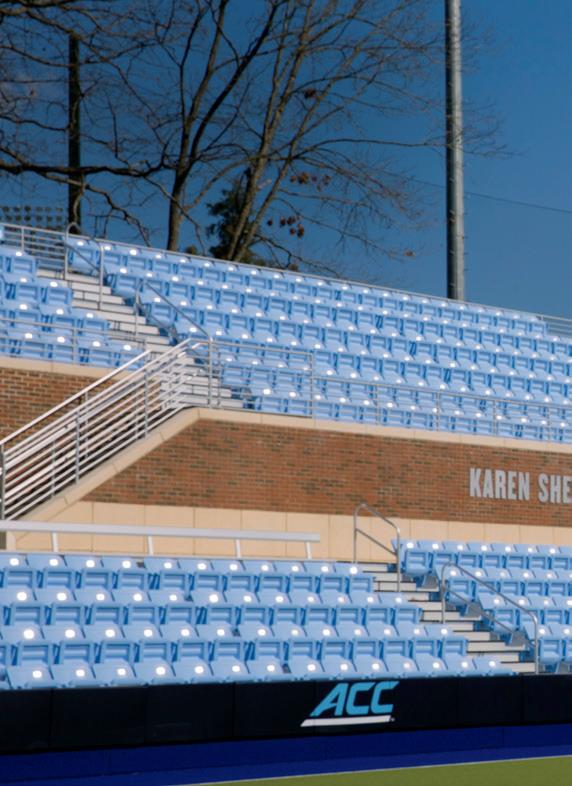
The 900-seat stadium features LED sport lighting and a video scoreboard, along with sports medicine facilities, a players’ lounge, meeting space and coaches’ offices. In Matson’s words: “It’s the best facility in the country.”
Matson occupies the unique position of both having played and coached at Shelton Stadium. When asked what having a high-caliber stadium means to players and coaches, she points to all the ways the facility supports the hard work and the camaraderie that fuel a team’s success: intense film study sessions, impromptu team dance parties with music blaring in the locker room, and joyful family gatherings on the patio after games.
“It helps with recruiting, it helps the players, and it helps the coaches,” Matson said. “I know there were supporters who made building it possible. I want them to know that I’m thankful and that my team understands how remarkable it is that we call this place our home.”
For Shelton, the stadium served as the perfect home for her to instill lessons that her players will carry with them through and beyond their time at Carolina.
“The stadium, I think and hope, reflects the work I do on a day-in-and-day-out basis: Training beautiful, strong, powerful women,” Shelton said soon after the new facility opened.

Field hockey alumnae say that playing for Shelton, and being student-athletes during their undergraduate years, carved lasting legacies in their personal and professional lives.
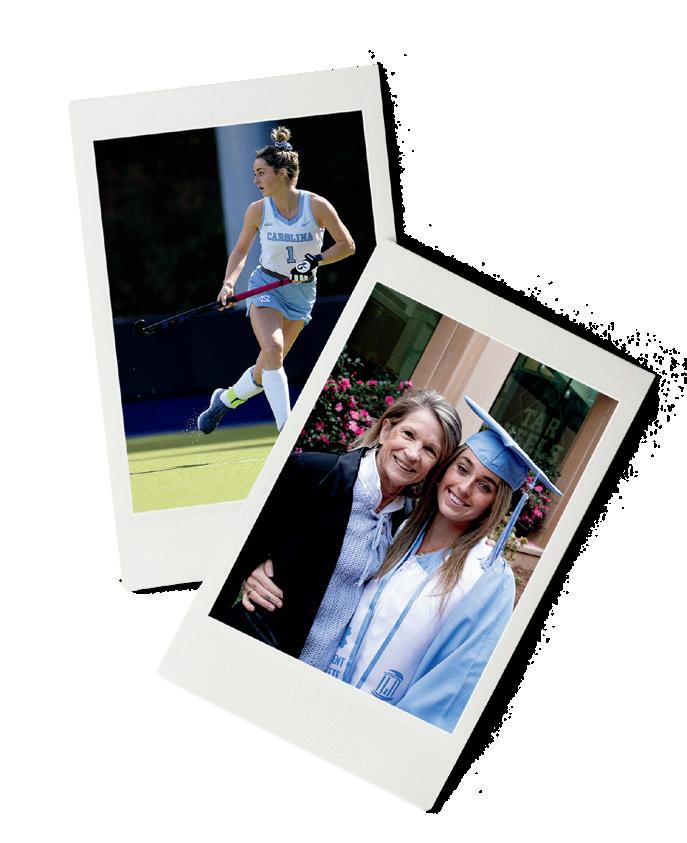
Louise Hines ’87 said there are countless ways in which she benefited from being a collegiate athlete and “playing under a coach who demanded 100 percent at practice and at games.” She said that accountability, which is one aspect of teamwork, has been embedded in her ever since she started playing team sports.
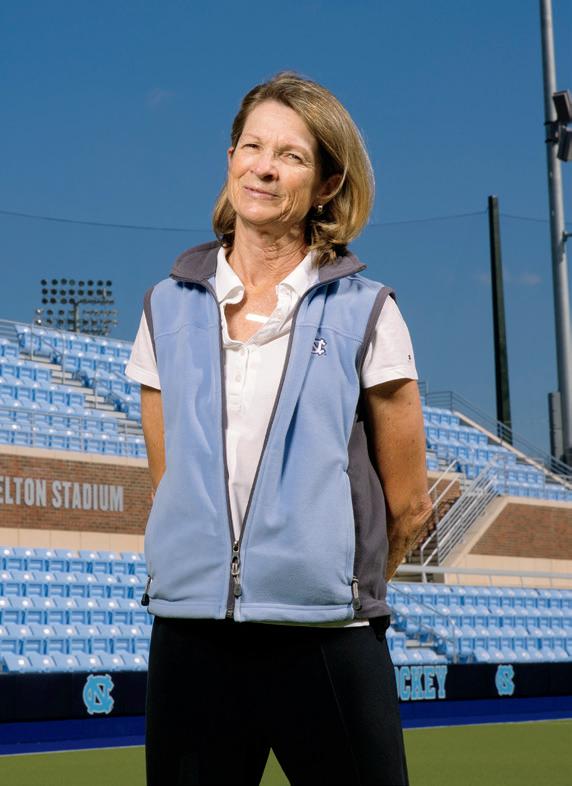
“Accountability now serves me well in life as well as the business world,” said Hines, a marketing executive at MassMutual. “A team’s dynamic works best if every
member knows what their role is and how the individual roles contribute to the common good. We’re each a cog in the machine. As an athlete, you learn to show up, be present and focus on the task at hand. Others are depending on you.”

When Hines played for Shelton, Shelton was new to coaching. So growth and change were other lessons she learned from that experience.
“We, as a team, and as individual players, grew in lockstep with her growth as a coach,” Hines said. “We were her first teams early in her career. Our goals were different back then. The program was in its infancy. I know my teammates would agree with me on this: It was fun laying the foundation of the UNC Field Hockey program, and it has been fun watching it grow over time. Winning was fun, and we improved each year, but at the core, it was the journey that made the experience so fulfilling — being connected to and being a part of something bigger than ourselves.”

These five field hockey alumnae attribute much of their success to lessons learned on the field. Back row, from left: Leslie Lyness ’90 is a neurosurgeon; Casey (Burns) White ’10 is a lawyer; and Riley (Foster) Gaines ’10 is a nurse anesthetist. Front row, from left: Louise Hines ’87 is a marketing executive; and Ali (Stewart) Cleveland ’03, ’14 (MEd) is a high school principal.
Back then, the teams didn’t record perfect seasons. Hines said losses on the field helped her learn resilience and perseverance. “I learned early on how to deal with tough situations and adversity,” she said. “In life, we confront all types of challenges — disappointment, illness, job loss, etcetera. How we respond to these circumstances defines our character. Sports provided me with the toolkit that prepared me for life’s inevitable challenges both personally and professionally.”


Riley (Foster) Gaines ’10 said playing field hockey for Shelton shaped her life as a young woman. “I learned the importance of consistency and hard work, or as
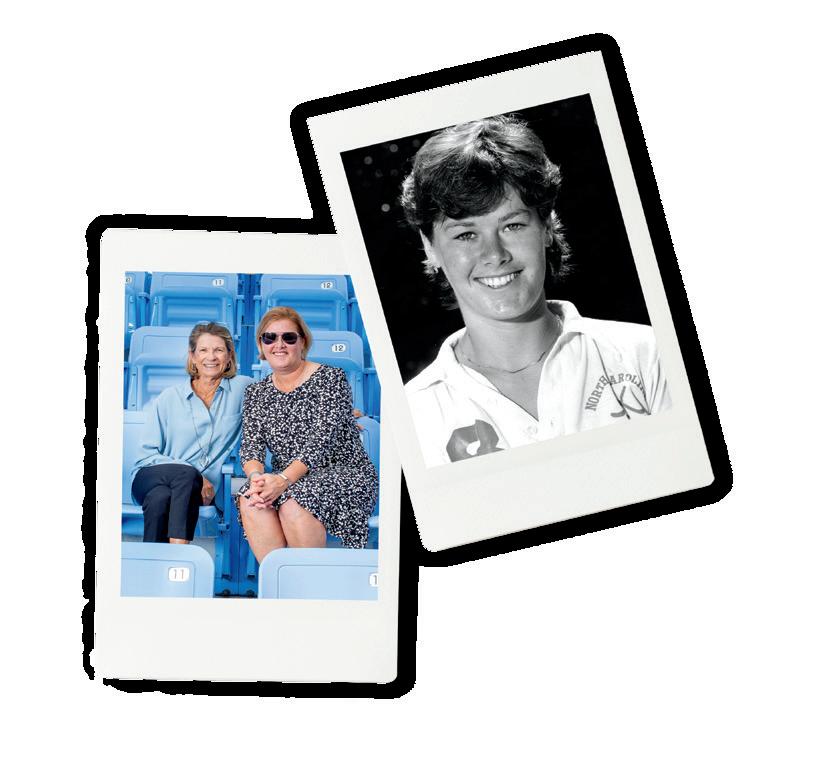

One of Shelton’s signature quotes, Hines said, is “Dare to be brilliant.”
It means to take risks, exhibit selfconfidence, nurture your passions and confront your fears. “I often apply this mantra to life as well as my professional career.”
Coach [Shelton] always said, ‘keep showing up,’” Gaines said. A four-time All-ACC Academic Team member and two-time NCAA champion, Gaines said that mantra stayed ingrained in her while studying nursing during her undergraduate years, and afterwards in graduate school for nurse anesthesia at Duke.
“Accountability was a pillar of our success as a team,” Gaines said. “Holding myself to a high standard of excellence is how I strive to make a difference in my career and home life as a mother and wife. I am grateful for the impact that field hockey had on my life as a collegiate athlete, now as a mother, and hopefully on my daughters as they grow.”
Gaines is currently a nurse anesthetist in the UNC School of Medicine’s Department of Anesthesiology.
Leslie Lyness ’90 remembers three lasting lessons from playing field hockey at Carolina. “When you play for Karen, it was all about preparing and executing, whether it was the skill or the game plan, and then learning from your mistakes,” Lyness said. “I still do that today. I’m a neurosurgeon, so I prepare for surgery. I know what I’m going to do. I’ve got plan A, plan B and plan C.”


The second thing is execution, whether it was in practice or a game. “We’d practice, for example, corner shots. We’d try to execute corners or whichever skill or game

plan,” she said. “Now, for you, for me, and all of us in our life, we have to execute whatever plan we’ve put in place, whether we’re running a meeting or taking a brain tumor out. We execute the plan.”
Execution also means doing your job, but not trying to do someone else’s job or everyone’s job. And appreciating others for doing their job. “I’ve tried to take that into my life, and not take anyone for granted,” Lyness said. “In my work, this means I appreciate the nurses for what they do. I appreciate the people who transport the patients and the people who clean the rooms. If there isn’t a clean room, I can’t do the surgery.”
Lyness said playing for Shelton taught her to learn from her mistakes. “We all make mistakes,” she said. “That’s the beauty of playing sports, no matter what level. You have to learn from your mistakes and try not to make the same mistake again.” She remembers Shelton emphasizing that.
“I think she stresses it for the entire team. I think probably every single player would tell you that.”
Lyness considers herself fortunate to remain connected to Shelton, the program and the University. “I can see what she’s done for all of these girls, and I’m just so, so proud to be a Tar Heel,” she said.

Shelton’s work as a coach, to foster and develop “beautiful, strong, powerful women” has also served as an inspiration for all of UNC Athletics. In 2019, Carolina Athletics and The Rams Club launched FORevHER Tar Heels, an initiative with a mission to build and inspire a Carolina community that champions women student-athletes through financial support of 15 teams, scholarships, facilities and a mentor program.
FORevHER Tar Heels provides Carolina women student-athletes resources for continued academic and athletic excellence. The initiative is one of the first of its kind in the country, building upon Carolina’s legacy as a pioneer in women’s athletics and emphasizing its longtime continued commitment to create and enhance opportunities for female student-athletes.
Through mentorship support, supported professional leadership programming and development opportunities, the FORevHER Tar Heels initiative is continuing Shelton’s legacy of empowering and championing the success of women throughout their careers.
A few weeks before Coach Roy Williams ’72, ’73 (MAT) announced his retirement, he and his wife Wanda ’72 made their largest gift to Carolina: $3 million to support scholarships for student-athletes, Carolina Covenant Scholars and Chancellor’s Science Scholars. Their investment stemmed from their desire to ensure a high-quality education at Carolina remains in students’ reach, especially in challenging times such as those brought on by the COVID-19 pandemic.
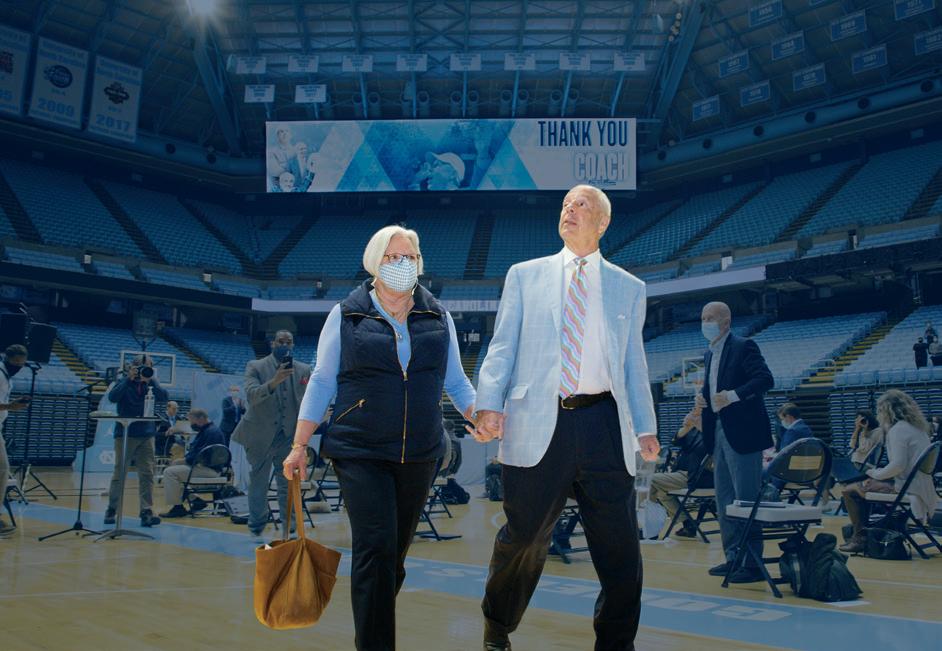
Coach Williams urged others to join his team and follow suit: “If you have the means, this is a great time to not only be involved but to have the kinds of feelings that we do and get emotionally involved in the University.”
Carolina legend Danny Green ’09 was the first to answer the call. Moved by the Williamses’ generosity, Green committed $1 million to endow a basketball scholarship for Tar Heels. Then, between May 1 and June 30, 2021, Tar Heels everywhere celebrated and amplified the Williamses’ gift through the Playing It Forward initiative, collectively contributing a total of $3.65 million in scholarship funding for the three programs that benefited from the couple’s gift.
Jim Koman ’86 and his family made a gift to honor Jim Koman’s late father, Bill Koman Sr. ’56, in two ways important to the family: 1) The Bill Koman Game Plan for Success is a comprehensive development program that prepares Carolina football players for life after graduation; and 2) the Bill Koman Practice Complex gives Tar Heel football players and coaches a world-class indoor and outdoor facility.
“Part of our mission as a football program is to ensure that we’re giving our young men the tools to go on and be productive husbands, fathers and citizens when their time in college comes to an end,” football head coach Mack Brown said of the Bill Koman Game Plan for Success. “With this program, we’ll be able to take that commitment to another level, and it will be of great benefit to our current and future student-athletes. I’m thrilled that Jim and Jennifer have so generously chosen to recognize Bill by creating a program that will impact our young men for the rest of their lives.”
Brown often describes the Carolina football program as a “40-year decision, not a fouryear decision.” In that spirit, the Bill Koman Game Plan for Success prepares Carolina football players for life after graduation. Programming centers on academic assessment, study and learning skills preparation, leadership development, community involvement and career opportunities.
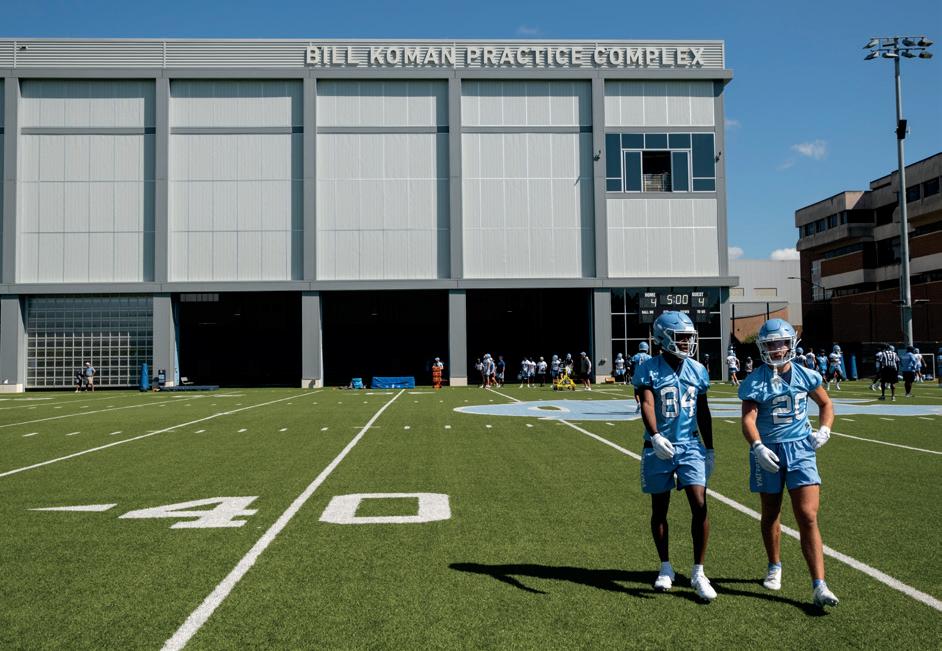
When Sierra Foster ’23 graduated from UNC-Chapel Hill in May 2023, she celebrated more than just her chemistry degree. Foster was among the first group of undergraduate students to earn a Certificate in Applied Data Science (CADS), a curriculum in the UNC School of Information and Library Science (SILS) designed to prepare graduates for a data-driven future.
“Data are becoming a central part of almost any job,” said McColl Term Professor David Gotz ’01 (MS), director of CADS. “A lot of training that people receive in their formal degrees doesn’t cover the latest technology and approaches for dealing with data in the way that is becoming more and more common. The CADS program provides people a foundation on which they can bring these new skills into the workplace and upscale themselves as professionals.”

The CADS curriculum provides an understanding of data science tools, methods and best practices, as well as the complex ethical and societal issues associated with data-driven approaches. CADS is open to non-degree seeking graduate students and undergraduate students, like Foster, who is now pursuing her master’s in accounting from UNC Kenan-Flagler Business School. Foster recognized that as more professional roles become data driven, certification in applied data science would give her an edge in a competitive field.
“The CADS program taught me valuable skills to enhance my career,” Foster said. “It is a wonderful asynchronous program for learning the basics of data science — an essential skill in the business sector. I believe the program will aid me in obtaining a job because it provides valuable skills that employers need.”
SILS was able to explore and launch the CADS program thanks, in part, to forward-thinking alumni — including Joyce Ogburn ’82 (MSLS) — who made gifts in support of innovation at the school.
“Everything people do in life depends on the gathering, analysis and flow of information,” said Ogburn. “This demands new approaches and fresh perspectives in research and teaching.”

Each year, the UNC School of Education graduates some of North Carolina’s most highly effective new teachers through its Master of Arts in Teaching (MAT) program. Onesty McMillian ’21, ’22 (MAT) is one of those new teachers, leading her own elementary school special education classroom in Durham Public Schools.
In 2020, thanks to the generosity of Alice Robbins Howard ’66 (MAT), the School of Education provided each MAT graduate with a box filled with classroom supplies, including construction paper, pens, pencils, markers and Carolina swag that says, “I’m a Tar Heel teacher.”
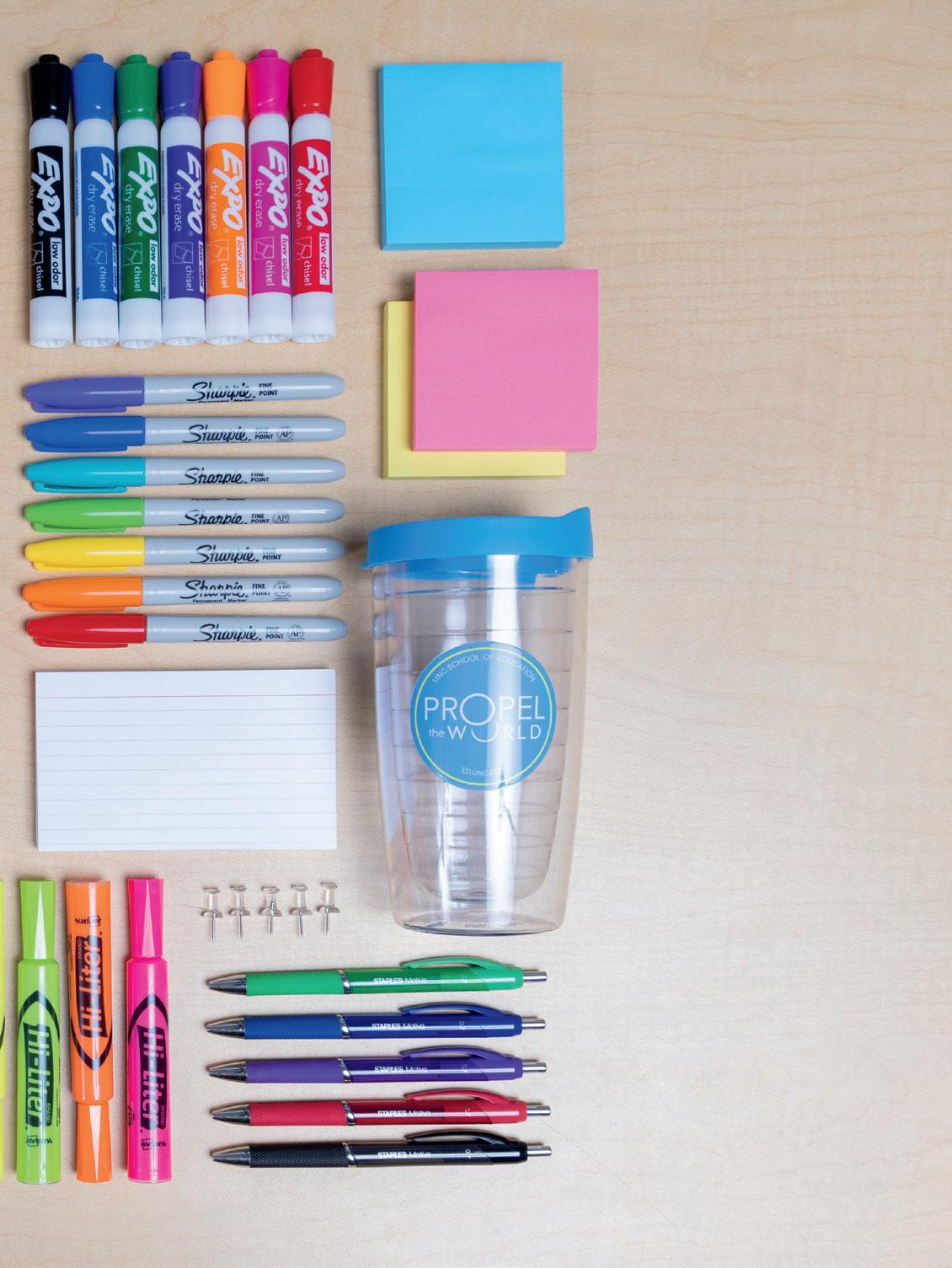
Since then, the school has crowdfunded these “teacher boxes” through the generosity of Tar Heel educators, who are proud to send the next generation of teachers, including McMillian, into the classroom with supplies they can use and some added Carolina Blue encouragement.

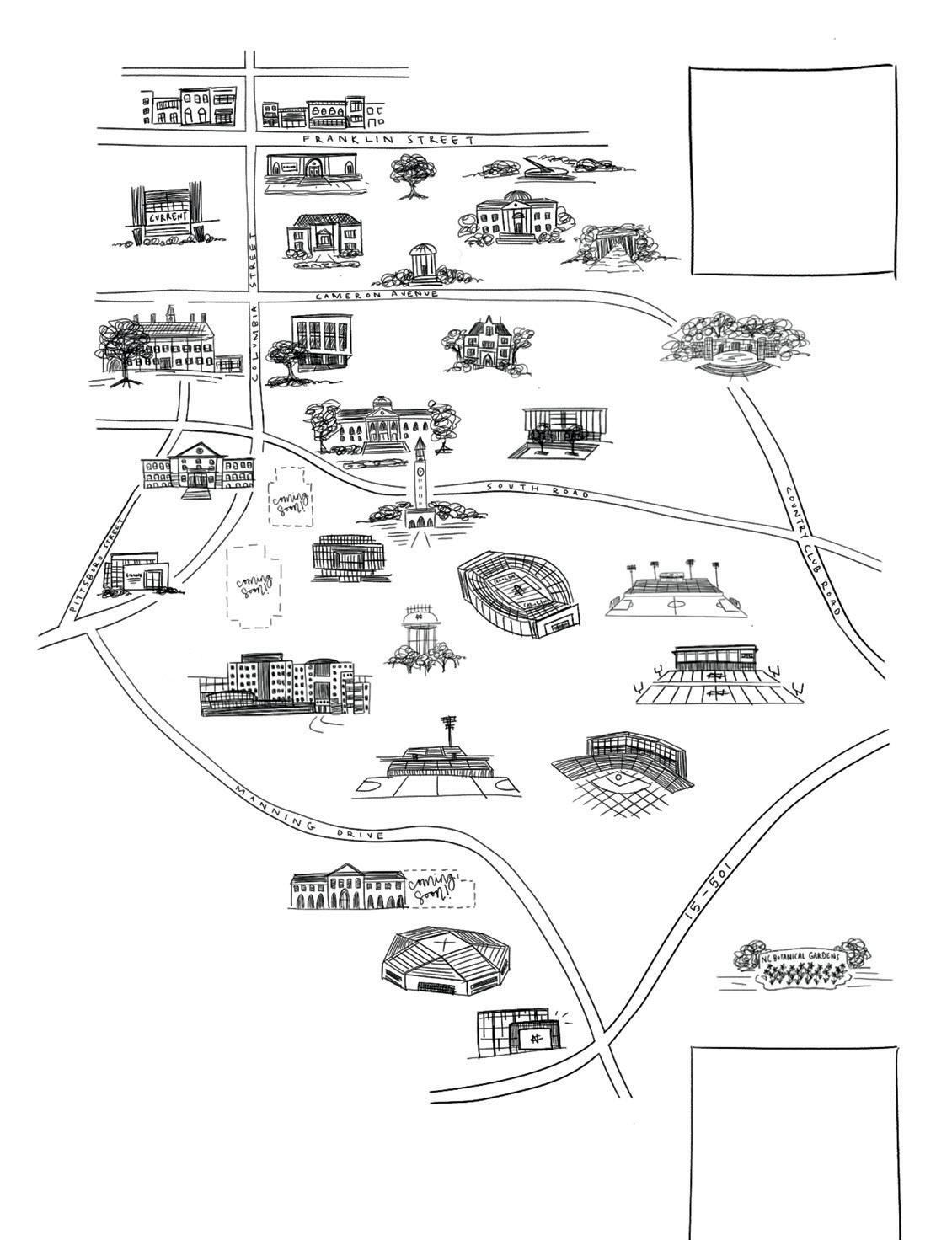




Many donors to the Campaign for Carolina made gifts to support new and improved buildings and spaces to optimize student success in academics and athletics, enhance faculty teaching and research, and bridge campus and community. This map depicts the major* building and renovation projects that are complete or in the works thanks, in part, to private giving.
*Major building and renovation projects are physical spaces that are entirely new or significantly renovated. This list is not exhaustive.
11.
12.
13.
14.
15.
16.
**These projects are the result of philanthropic support and generous, specific state appropriations. Other projects may have benefited from state funds in some way.
 1. Hill Hall
2. Curtis Media Center
3. Beard Hall
4. Carrington Hall **
5. Roper Hall **
6. Paul J. Rizzo Conference Center
7. Steven D. Bell Hall **
8. Dorrance Field
9. Bill Koman Practice Complex
10. Karen Shelton Stadium
Woody Durham Media and Communications Center
Finley North Athletics Complex
Cone-Kenfield Tennis Center
CURRENT ArtSpace + Studio
Morehead Planetarium and Science Center
North Carolina Botanical Garden
1. Hill Hall
2. Curtis Media Center
3. Beard Hall
4. Carrington Hall **
5. Roper Hall **
6. Paul J. Rizzo Conference Center
7. Steven D. Bell Hall **
8. Dorrance Field
9. Bill Koman Practice Complex
10. Karen Shelton Stadium
Woody Durham Media and Communications Center
Finley North Athletics Complex
Cone-Kenfield Tennis Center
CURRENT ArtSpace + Studio
Morehead Planetarium and Science Center
North Carolina Botanical Garden
The renovation of Hill Hall, the historic heart of the Department of Music in the UNC College of Arts and Sciences, was kickstarted with a $5 million gift from the William R. Kenan, Jr. Charitable Trust. Renovations centered on improvements to Hill Hall’s rotunda and 450-seat auditorium in the centuryold building that served as the University’s first library. Upgrades to Hill Hall included state-of-the-art acoustical treatments, a professional-grade stage, an enhanced backstage area with updated dressing rooms and storage, modernized administrative and teaching spaces, and more.
The performance space was named the James and Susan Moeser Auditorium in honor of the former chancellor and his wife. In 2022, Moeser Auditorium hosted 150 events, plus numerous master classes, rehearsals and recording sessions. “The auditorium is almost used on a daily basis throughout the semester,” said Jesse Moorefield, production manager for the music department.
Located adjacent to Carroll Hall at the campus gateway facing Cameron Avenue, Carolina’s newest building features a hightech broadcast studio, a podcast studio, a makerspace and four state-of-the-art classrooms. The James F. Goodmon Studio serves as a learning space for UNC Hussman School of Journalism and Media broadcast students and boasts a 16-by-9-foot highdefinition LED screen, green screen and production facilities. The studio also has a direct connection to UNC Athletics’ facilities and enables Carolina faculty members to share their expertise on television broadcasts.
(See p. 62 for more about the Curtis Media Center.)
Updates and renovations to Beard Hall — home to the UNC Eshelman School of Pharmacy — include a new active learning space, additional patient simulation rooms and small group meeting rooms, technology updates, improved accessibility, connection points between Beard and Kerr halls, and an open office space for the UNC Eshelman
Institute for Innovation. The total project cost about $10 million and reshaped most of the second floor, as well as portions of the first and third floors of Beard Hall.
“I’m so proud of these contemporary spaces that are now conducive to working, learning and collaborating,” said Angela Kashuba, dean of the pharmacy school.
A new nursing education building will enable the UNC School of Nursing to help meet North Carolina’s projected demand for nurses, with larger class sizes resulting in more Carolina nurses providing quality, compassionate care around the state.
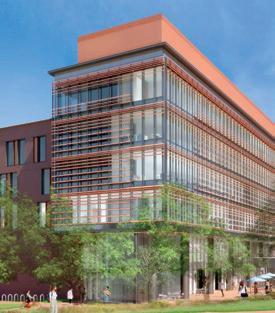

The building will include a stateof-the-art simulated clinical environment, enabling the school to train at least 30% more students with simulation technology. From practicing IV insertions to learning how to work in interprofessional care teams, nursing students will be better prepared to care for patients thanks to the Helene Fuld Health Trust Quality and Safety Education Center.
“Our clinical simulation faculty rank among the world’s best,” said Valerie Howard, dean of the nursing school. “The Fuld Center
will give them the tools to be even more effective in training future generations of nurses, who will be even better prepared to care for their patients.”
UNC Kenan-Flagler Business School completed the third phase of renovations to the Paul J. Rizzo Conference Center, an executive education campus set in a 28-acre wooded environment one mile from campus. The retreat-like setting underscores the University’s commitment to delivering quality executive programs to support meaningful reflection and lasting learning.
Delivering a 21st-century medical education demands not only a medical school like no other but a medical education campus to match. Roper Hall, built on the historic site of Berryhill Hall, will enhance and expand the capabilities of where students, staff and faculty learn, teach and practice, as well as help attract the health care leaders of the future. Named in honor of Dr. Bill Roper, former dean of the UNC School of Medicine, CEO of UNC Health and vice chancellor for medical affairs, the 172,000-square-foot building will enable the school to prepare more students for tomorrow’s practice.
The eight-story building will include:
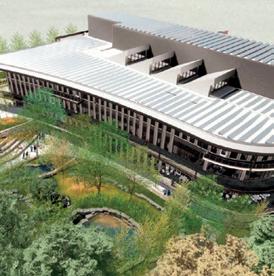
• A 400-seat active learning theater
• Two floors dedicated to clinical skills and simulated learning
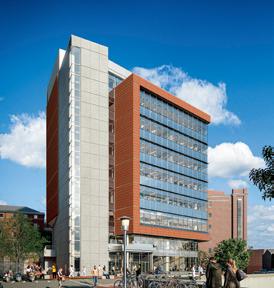
• Flexible lab, classroom, study and collaboration spaces
These most recent renovations added more than 99,000 square feet to McLean Hall and other amenities that, combined, create the ideal environment for visitors to both work and unwind.
The new building will enable UNC Kenan-Flagler to grow enrollment in the Undergraduate Business Program by 50%. More talented students means more graduates prepared to become leaders and innovators, spurring economic growth in North Carolina and beyond.
• Undergraduate Business Program admissions: +50%
• Facility square footage: +140,000
• Teaching and class space: +100%
• Student life and activity space: +48%
• Meets LEED Gold standards
• 255+ donors
Steven D. Bell Hall is a stateof-the-art facility designed for the teaching, learning and collaboration that represents the highest standard for a 21stcentury business education. The expansion of the UNC Kenan-Flagler Business School campus will bring additional class and conference rooms, media and production facilities, interview space and event galleries. Public spaces will feature artwork on permanent display and works borrowed from the Ackland Art Museum.
Named for Anson Dorrance ’74, legendary UNC women’s soccer head coach, Dorrance Field is home to the men and women’s soccer teams and the men and women’s lacrosse teams. Each team has won multiple NCAA championships. A member of the National Soccer Hall of Fame, Dorrance has led his soccer teams to 21 NCAA championships.
The facility features:
• A natural grass playing field
• Offices and team meeting areas and locker rooms
• A new Hall of Honor to celebrate the four programs
• 4,200 individual chair back seats
• New concessions and restrooms
• New LED scoreboard/ video board
The Bill Koman Practice Complex gives Tar Heel football players and coaches a world-class facility, with full-length synthetic fields, an observation deck and film editing center, as well as training and sports medicine areas. The facility was named following a campaign gift from Jim Koman ’86 in honor of his father, the late William J. “Bill” Koman Sr. ’56, who played linebacker for Carolina in the 1950s.
“In my opinion, the Bill Koman Practice Complex is the best in the country,” said Mack Brown, UNC football head coach. “It has been a huge addition to our program in regard to onfield preparation, offseason training and recruiting. We have a wonderful indoor area that allows us to do whatever we need to do regardless of weather, and the two outdoor fields give us ample space to maximize our practice sessions. It’s really been a game changer for us.”
(See p. 50 for more about the Komans’ gift.)
The first Carolina athletic playing facility named for a woman, Karen Shelton Stadium honors the legendary field hockey coach who led the program to a record 10 national championships. Shelton retired following her team’s NCAA title season in 2022.
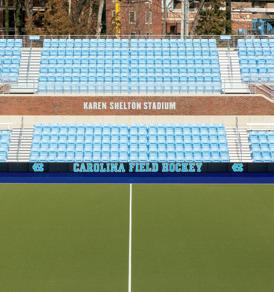
“This facility is unmatched in our sport, which is such an advantage for our players and staff,” Shelton said. “It also speaks to recruits by assuring them that field hockey matters at the University of North Carolina.”
Karen Shelton Stadium, which was supported with a campaign gift from Ken ’70 (MS), ’76 (PhD) and Cheryl Williams, features:
• 900-seat capacity with fan amenities, including concessions and restrooms
• Press and scorers box
• LED sport lighting and LED video scoreboard
• Team building with locker rooms, team room, sports medicine space, players’ lounge, meeting space and coaches’ offices
(See pp. 42–48 for more about Karen Shelton Stadium.)
The Woody Durham Media and Communications Center serves as a central hub that relays the latest Tar Heel athletics content across a variety of platforms to Carolina fans around the world, with students pitching in and gaining hands-on experience.
The center honors the late legendary Tar Heel sports broadcaster, a 1963 Carolina graduate who was the play-byplay voice of Carolina football and men’s basketball from 1971 to 2011. He called 23 Tar Heel bowl games, 13 Final Fours and six NCAA championship games, including NCAA title-winning seasons in 1982, 1993, 2005 and 2009.
The new home of Carolina’s track and field programs, the Finley North Athletics Complex is equipped with running surfaces and throwing fields that optimize student-athlete performance. The facility features a 400-meter, eight-lane track, a one-kilometer warm-up track, an LED video scoreboard and 500 seats for meet viewing. The facility is

also home to synthetic practice fields for Carolina’s soccer and lacrosse teams.
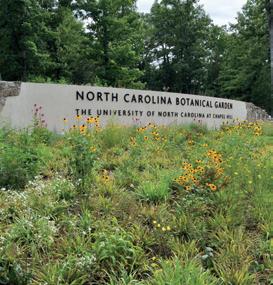
Renovations to the ConeKenfield Tennis Center include championship courts, seating and amenities that reflect the University’s status as a leader in collegiate tennis. The facility will be sought after by the ACC and the NCAA for hosting competitions and events.
“There’s a lot of excitement around both [the women’s and men’s] programs, and with this new facility, it’s going to add the opportunity for growth and accomplishing things we’ve never done before,” said Brian Kalbas, who has coached the women’s team since 2003.
CURRENT ArtSpace + Studio is a 4,000-square-foot black box theater — but that’s only the beginning. Since opening, this unconventional, multifaceted arts venue in the heart of Chapel
Hill has hosted more than 200 presentations and twice as many events and has sold more than 6,800 tickets. CURRENT is also available to rent for the University and local arts community.
“CURRENT is a porous, permeable space visible and accessible to anybody walking by,” said Alison M. Friedman, the James and Susan Moeser Executive and Artistic Director at Carolina Performing Arts. “It’s part of our vision to knit the campus with the downtown, with community groups, with locally based artists.”
public health, environmental science, life science and biomedical engineering. The renovation also enhanced the planetarium’s science education programming with a new STEM tinker space and updates to the Science LIVE! stage.

The Morehead Planetarium and Science Center completed a transformational renovation thanks to $7.4 million in private support, including almost 150 gifts ranging from $5 (dollars) to $2 million. The renovation opened 5,000 square feet of space, quadrupling the visitor and exhibit footprint. Exhibits in the rotunda focus on the history of Morehead and its roots in space exploration. On the lower level, the Breakthrough Hub features interactive displays that demonstrate research from UNC scientists working in astronomy,
Updates to the North Carolina Botanical Garden included the James & Delight Allen Education Center, a LEED Platinum visitor facility that attests to the shared conservation values of the garden and the Allens. A LEED Platinum rating is the highest level of certification a building can receive from the U.S. Green Building Council. Improvements also include a new entry sign, front entrance and the Bob and Molly Broad “Broadway,” a stone and paved walkway edged with new plantings and low stone walls for seating.
Carolina’s highly regarded journalism program began as a department in the UNC College of Arts and Sciences in 1924, 15 years after Edward Kidder Graham taught the University’s first journalism course.

It became a professional school in 1950, and today it proudly boasts numerous North Carolina Media and Journalism Hall of Famers and Pulitzer Prize winners among its alumni and faculty. The school has also claimed seven of the last eight collegiate journalism national championships in the prestigious Hearst Journalism Awards competition — and 11 all time.
The school is not one to rest on its laurels. While the outside observer might assume it’s reached the pinnacle and will remain there, those within the UNC Hussman School of Journalism and Media community will tell you they’re far from done and are always looking forward, pursuing innovation and exploring new ideas. Indeed, they want nothing less than to lead the transformations in their field, with nothing less than American democracy at stake.
Gifts to the Campaign for Carolina are fueling those aspirations at a level unlike any the school has experienced in its long and illustrious history.
Susan King, dean when Walter Hussman Jr. ’68 made a $25 million endowment gift to the school in 2019, described it as “transformative … not just for now, but for the future — for not one generation, but for generations to come.”

The gift, which renamed the school in Hussman’s honor, was unrestricted. Such gifts are particularly powerful because of the flexibility they provide administrators to meet strategic priorities and seize unforeseen opportunities. As King pointed out, the endowed funds will enable UNC Hussman “to build for the future and invest in the people who have made this school a national leader — our professors, our staff, our students and all of the promise they represent.”
King’s successor, Dean Raul Reis, will now reap the gift’s rewards — to the benefit of the entire school and, ultimately, society.
“This gift ensures that UNC Hussman will continue to empower our faculty and staff to innovate as we provide immersive learning experiences for students that prepare them for careers at the center of the public square,” he said. “Our graduates become leaders in industry and academia who understand the vital role of communication in fostering democracy and who embrace the opportunities of a changing media landscape.”
Already, Reis has been able to use the unrestricted funds to enhance the student experience and attract and retain top-notch faculty.
“This gift ensures that UNC Hussman will continue to empower our faculty and staff to innovate as we provide immersive learning experiences for students that prepare them for careers at the center of the public square.”
— DEAN RAUL REIS
Gifts from Don Curtis ’63 and his family combined with others to fund a facility that Chancellor Kevin M. Guskiewicz described as home to “the true magic of discovery, creativity and the training of the next generation” of journalists, media professionals and scholars.
The Curtis Media Center, which opened for classes in fall 2022, is located adjacent to Carroll Hall at the campus gateway facing Cameron Avenue. The nearly 13,000-square-foot, three-story building features a high-tech broadcast studio, a podcast studio, a makerspace and four state-of-the-art classrooms.
Like the Hussman gift, the impact of the gifts creating the Curtis Media Center will be as much about the future as the present.
“This is something that will serve students for dozens and dozens of years, and there will be hundreds and hundreds of students who will be able to come through here now in a totally different way,” King said.
The James F. Goodmon Studio attests to that sentiment. Occupying the building’s ground floor,
the studio serves as the center’s crown jewel, a glass-encased learning space for UNC Hussman’s students that enables media production with emerging technologies. The studio also provides more opportunities for Carolina faculty to share their expertise on television broadcasts. It boasts a 16-by-9-foot high-definition LED screen, green screen and production facilities, as well as a direct connection to UNC Athletics’ facilities.
Student productions include newscasts and two sports shows each week. The studio’s technology, which enables students to create advanced effects such as diagramming football plays on screen, puts UNC Hussman “ahead of the curve,” said Charlie Tuggle, senior associate dean for undergraduate studies and John H. Stembler Jr. Distinguished Professor.

“It’s as good as you would see on ESPN,” he said. “We cover every sport, and we do it well thanks to the technology at our fingertips and the way our students have embraced that technology in their storytelling.”
By Scott Ragland ’87The Curtis Media Center includes a new makerspace for Workroom: FashionMash, a product and experiential design incubator centered around fashion and lifestyle products.
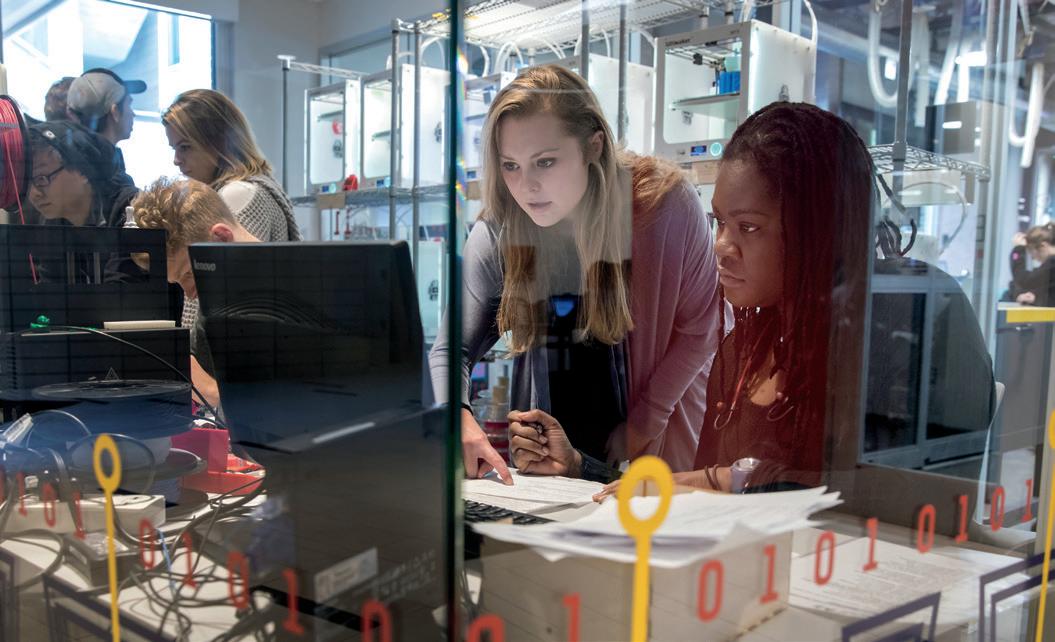
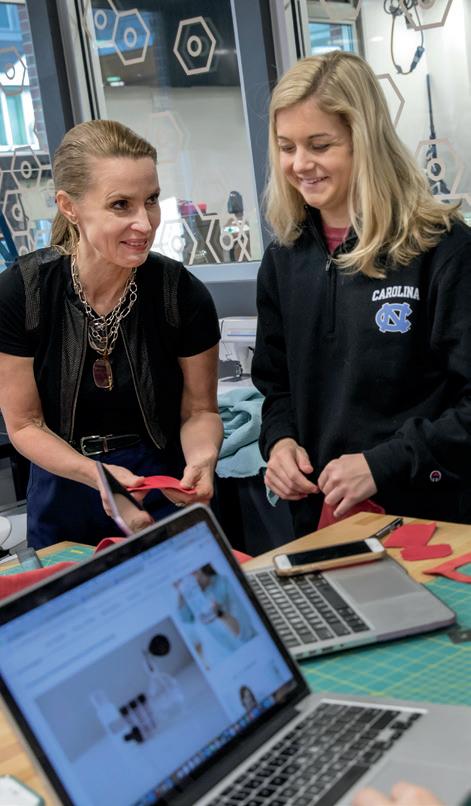
Dana McMahan, a professor of the practice at UNC Hussman, founded the program with the goal of getting students’ creative energy “out of everybody’s head and into the physical world.”
In 2016, a $1 million grant from the Goodwyn Family Foundation secured her vision’s financial future. Now the Curtis Media Center has given it a physical home.
Workroom: FashionMash uses an off-campus studio and makerspaces in Murray Hall and Hanes Hall (pictured here), but the new space in the Curtis Media Center now provides direct access to the state-of-the-art technology in the Hussman School.
“The new Curtis Workroom Space expands the number of teams that can be working at one time and streamlines the process of design and production,” McMahan said. “We are right downstairs from large digital display areas for our exhibitions, as well as flexible, open-concept floors to stage our fashion shows.”
From implementing novel ideas to bringing long-standing causes to fruition, this campaign has provided spaces for cultural belonging, recognition and togetherness that enhance engagement with the local community and enrich campus diversity and dialogue.
The UNC National Pan-Hellenic Council Legacy Plaza honors the nine historically African American fraternities and sororities governed by the UNC-Chapel Hill chapter of the National Pan-Hellenic Council. Since 1973, these organizations have made a tremendous impact on the Carolina campus with their commitment to civic engagement, leadership, academic achievement and community.
In the plaza, each organization is represented by a 10-foot-tall monument featuring the organization’s crest, national and University charter date and motto. The pillars are organized in chronological date of the founding of each organization, and the brick floor can accommodate 125 people.
The project was organized by UNC Student Affairs with funding from dozens of alumni. Now, the plaza serves as an outdoor space where NPHC organizations can come together, promote their fraternities and sororities, and educate students about the history of these organizations.
“As an undergraduate, we dreamed of this type of installation on campus honoring NPHC member organizations like those found on many other campuses,” said Barry Brinkley ’01, member of the Mu Zeta Chapter of Alpha Phi Alpha Fraternity Inc.
The American Indian Center was established in 2006 to serve as a resource to connect faculty, staff and students to Native communities. Through events that include an annual Welcome Xtravaganza and programs such as Elder-in-Residence and the Michael D. Green
Lecture in American Indian Studies, the center has been a regional hub for Native culture, community and knowledge.
The center has another tool in its arsenal with the groundbreaking of the American Indian Cultural Garden. It will serve a range of purposes, from hosting events held by the center — such as educational programming and Native cultural activities — to providing quiet spaces for small group and individual healing.
Artistic elements in the garden, including a medicine wheel and graphics, were designed by Native students and community members from across North Carolina. The garden will feature native, traditional medicinal and other culturally relevant plants.
The Carolina Latinx Center was founded in the fall of 2019, succeeding the Carolina Latino/a Collaborative as a designated cultural center with a physical location in Abernathy Hall. Since opening, the center has expanded programming and provides Carolina’s Latinx students with study spaces, cultural events and leadership, and academic programs.
“The mission and vision of the center is to serve as a connector, a piece of community building,” said Josmell Pérez, center director. “We have a big commitment to the greater community and the academic landscape of the University.”
The Carolina Latinx Center hosts programming throughout the month of November for Latinx Heritage Month, holds an annual conference on Latinx identity (La Conferencia) and is a home for Latinx student organizations.
One of the newest programs in the center is LÍDER, the Carolina Leadership Institute, a year-long fellowship program that serves Latinx undergraduate students across North Carolina, centering on the values of Latinx identity within leadership roles. A collaboration between the Carolina Latinx Center and the UNC Kenan-Flagler Business School, LÍDER was initially piloted as a daylong development seminar. Support from an alumnus enabled the program to become a year-round fellowship.
A student-led group campaigned and raised money to establish a dedicated space for Asian Americans on campus. The UNC Asian American Center opened virtually in September 2020, and a physical space soon followed in August 2021.
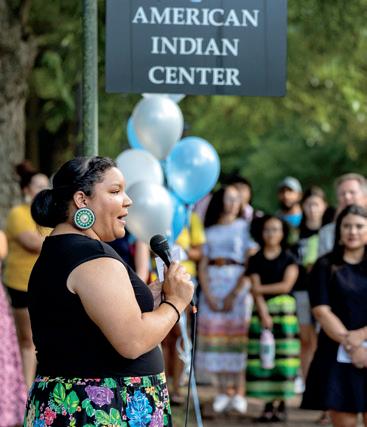
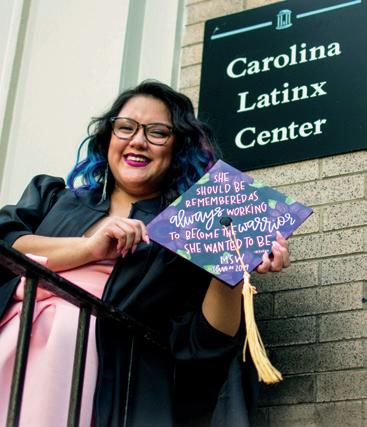
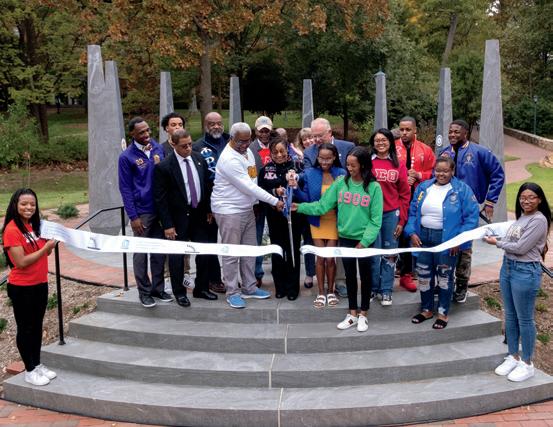
The center now occupies an 1800s carriage house on the corner of Cameron Avenue and Wilson Street. “This center means something different for each student,” said Selina Shi ’23, a Morehead-Cain Scholar and director of the Asian American Center Campaign Committee. “For me, it’s a place where I can be myself — where I know that every aspect of my identity is accepted and celebrated.”

The center’s programming includes the Asian American Center Fellows Program, the first of its kind in the nation. The program brings scholars, artists and community leaders from across the nation to lead workshops and events that engage with Asian American studies.
Student engagement with the center remains high, even though the Asian American Center Campaign Committee has met its goal. In 2022, for example, the Asian/Pacific American Heritage Month@UNC Student Art Exhibit ran as part of Arts Everywhere Day. Students showcased art related to their Asian American identities and received funds to support their work.
By Kay Langley ’22, ’24 (MA)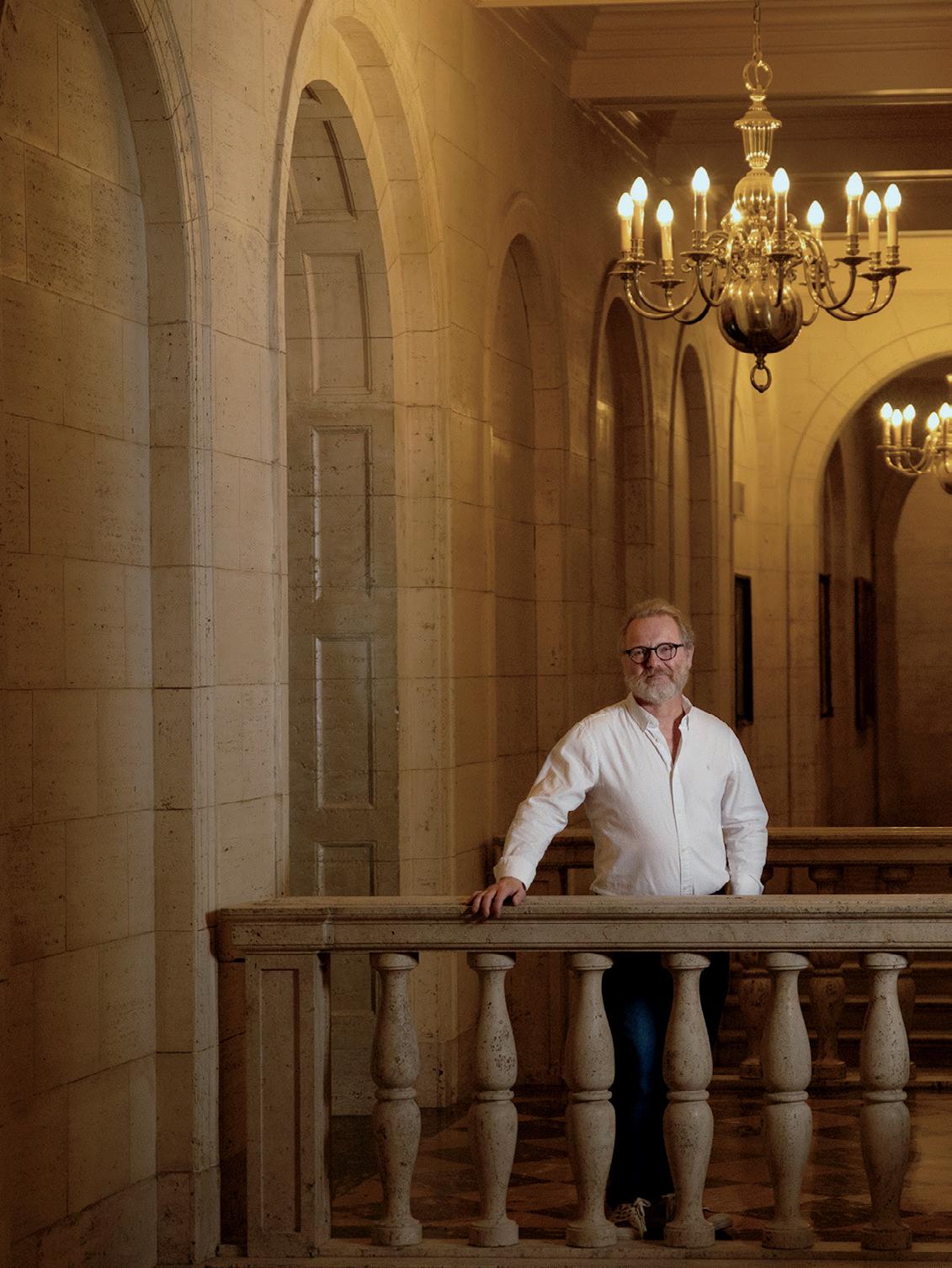

The work of Carolina’s faculty has advanced humankind for more than two centuries. New and bolstered professorships enable administrators to recruit and retain world-class faculty, to reward innovative teaching, and to target and support high-potential, high-reward research and scholarship. From advances in drug discovery, orthodontics and the treatment of complex immunological diseases to the study of authoritarian regimes and the epigenetic effects of prenatal exposure to toxic metals, meet a few of the Carolina faculty making a difference thanks to support from the Campaign for Carolina.
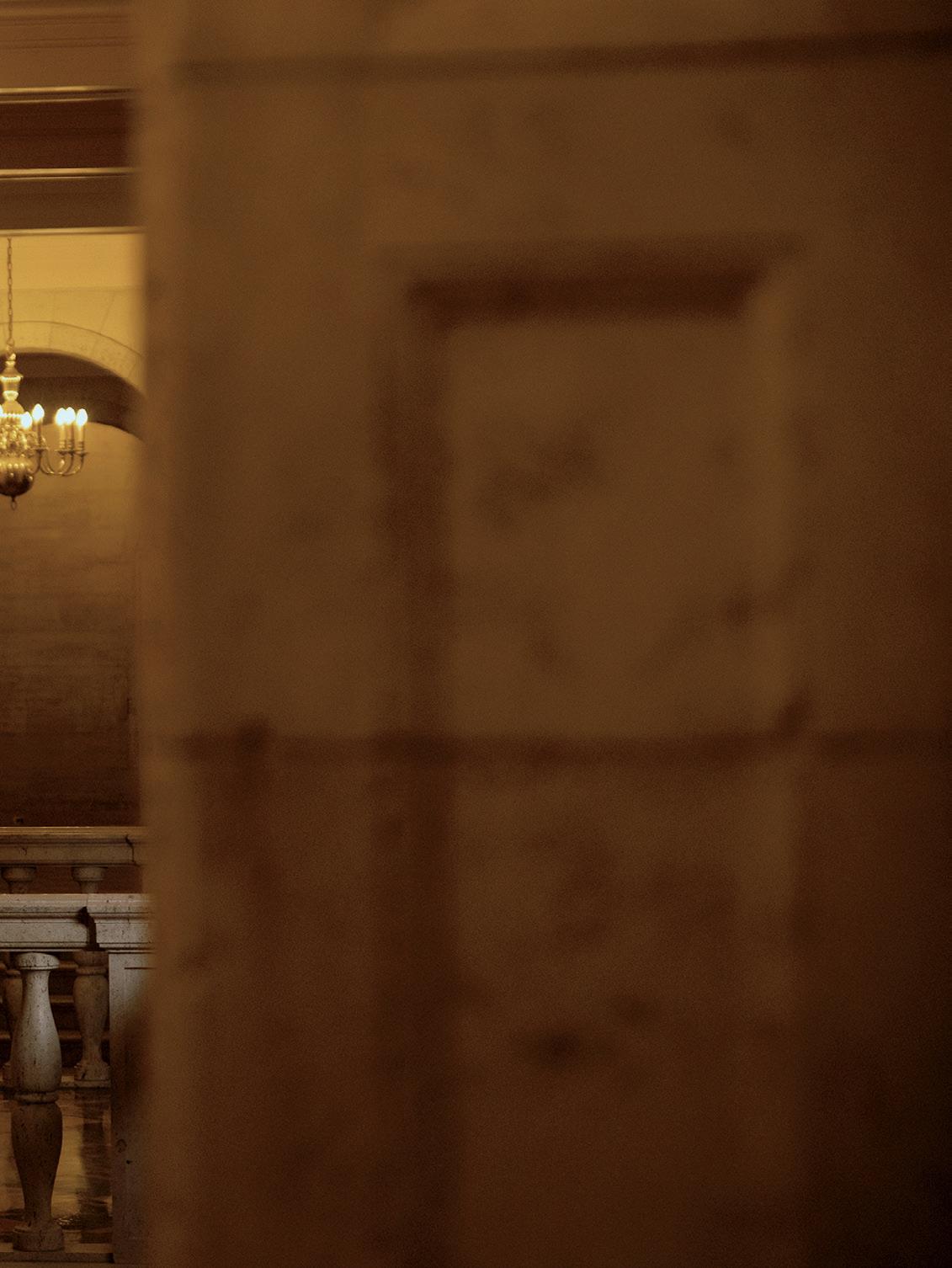 photos by Megan May
photos by Megan May
A Q&A with Tim Willson, the inaugural Harold Kohn Distinguished Professor in Open Science Drug Discovery
We call the proteins encoded by the human genome that are not currently being studied — like 80 percent of them — the dark proteome, and we use chemical biology to set up screens and find molecules that locate and inhibit members of that dark proteome. When we find a potent selective inhibitor, we study the role of that protein in cells and animals to try and figure out if it is involved in an important disease process. If it is, then we make that information available to the public domain to stimulate more research in the future, help people find more targets for drug discovery and ultimately find new medicines.
At the beginning of the pandemic, we pivoted to look for drug targets to treat COVID-19 and started collaborating with the virologists here. We found a couple of interesting enzymes — which when we inhibit them with our molecules, they actually shut down the replication of the virus. We published that information and made it available to the world. I’m quite proud of how rapidly we made progress on that one.

Whatever we discover in my lab, we have committed not to file for patents — that’s almost unique in biomedical research. And the University has agreed and is supporting us in that mission, recognizing that this is something that will benefit the entire field of drug discovery. The most exciting thing about this professorship is that it embeds open science in the UNC Eshelman School of Pharmacy, so the University will always have a focal point to continue this mission of using open science to move forward the field of drug discovery.

Rebecca Fry’s lab is one of the first to study the effects of prenatal exposure to toxic metals as it relates to the epigenome — how behaviors and environment can cause changes that affect the way genes function.
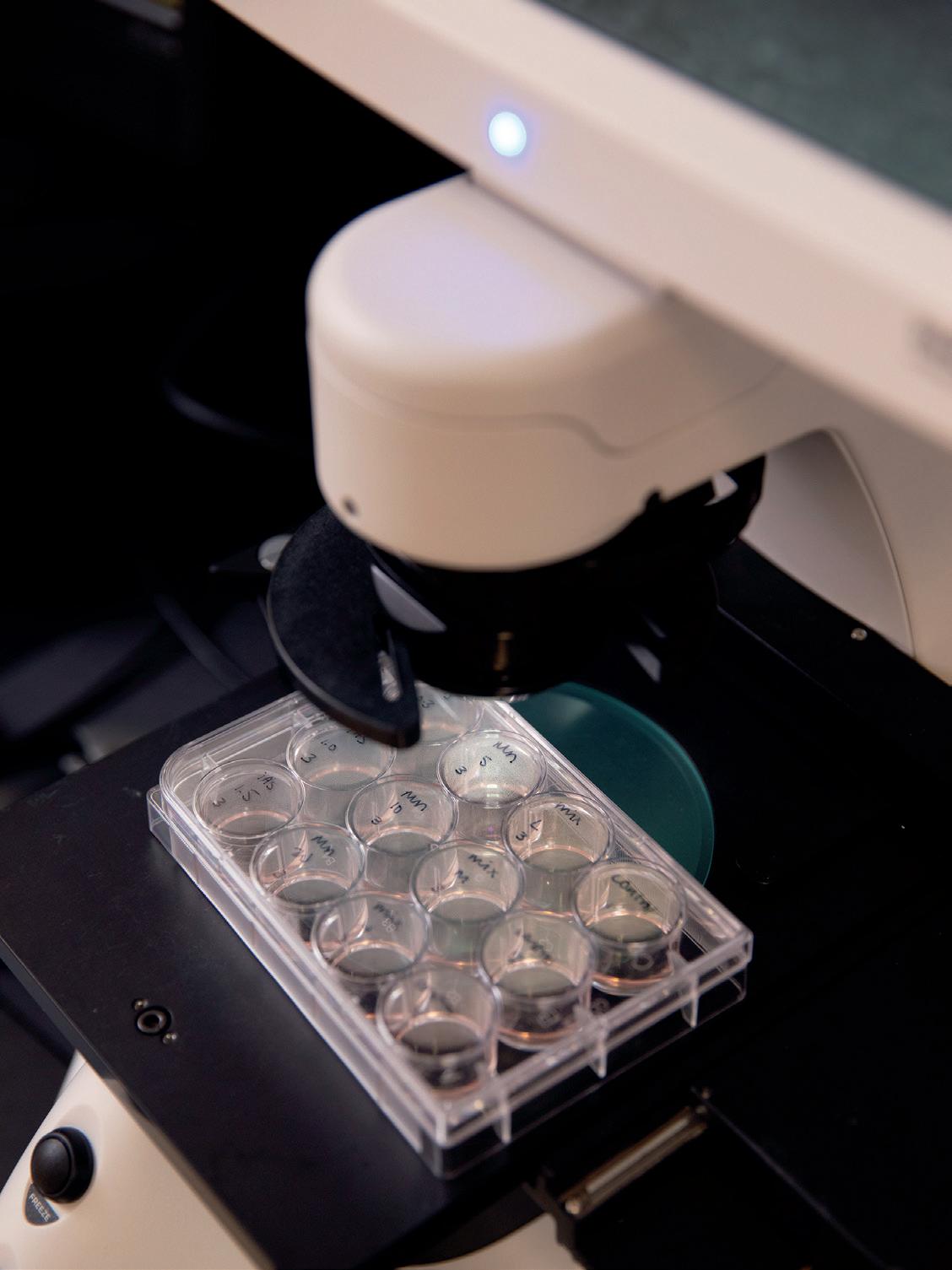
“This method highlights a way that we can understand how chemicals can have very long lasting and even transgenerational impacts,” said Fry, the Carol Remmer Angle Distinguished Professor in Children’s Environmental Health at the UNC Gillings School of Global Public Health. In other words, environmental hazards can change a person’s genes and those changes can be passed to future generations.

Thankfully, Fry’s lab is focused on solutions. “One of the things I love about working at Gillings is having opportunities to translate our work to something meaningful to communities and populations,” Fry said. “And we do that from many different angles.”
One of those angles is a project Fry is piloting with clinicians in maternal fetal medicine at UNC Hospitals, where more than 3,000 women give birth each year. The research team collects information on whether those women are on public or private drinking water at their homes. They then collect samples and test the patients’ drinking water. “If a subject’s test shows toxic metal levels to be high, we provide filters at no cost,” Fry said, noting that she would like to see these tests and services become standard practice for pregnant patients.
“I’m most excited about the solution-oriented research,” Fry continued. “One of the other reasons I love being at UNC is that it’s such a collaborative environment.”

A conversation with Tung Nguyen, DMD, the Dr. Henry S. Zaytoun Sr. and Mrs. Martha N. Zaytoun Term Professor
Tung Nguyen’s research at the UNC Adams School of Dentistry explores 3D imaging and printing to give orthodontists more efficient and effective ways to treat patients. He has also led award-winning research into skeletal anchorage Class III malocclusion (underbites) to reduce the need for surgery.

One formative lesson:
My father would tell me and my brother never to come to him with a problem unless we had thought about a solution first. That has stayed with me. In my research and my teaching, I try to teach my students to problem-solve rather than follow a recipe.
How a friend would describe him:
A friend once told me that I could never be content with a push lawn mower because then I would want a power mower. If I had a power mower, I would want a riding mower. If I had a riding mower, I would want a mower with artificial intelligence. I don’t love technology. I love technology that leads to better outcomes or more efficiency.
Why he chose academia:
I hope my legacy will be that I changed the future of orthodontics, whether it’s the way students learn or the way patients get treatment. It’s why I think many of us are in academics. We want to find things that help make the next generation better than us.
On gratitude:
I’m appreciative of the opportunity I have to teach my students. I’m appreciative of the opportunity to advance a profession. I’m most appreciative of the generosity of donors like the Zaytouns. It can be hard to recruit and retain faculty. They make it possible for people like me to stay and develop things that are going to help society and help the public.
Dr. Saira Sheikh is a nationally renowned physician, researcher and educator. She is trained and board certified in internal medicine, rheumatology and allergy/immunology, and specializes in the diagnosis and management of complex immunological diseases, particularly lupus and Sjögren’s syndrome. Sheikh, the Linda Coley Sewell Distinguished Professor in the UNC School of Medicine, shared what she loves most about her work at Carolina.

“I love being a physician and taking care of humans,” she said. “I love listening to my patients and providing cutting-edge treatments to improve their lives. I love being a researcher, because it allows me to ask and test scientific questions. I love dreaming up and developing ideas and innovative therapeutic approaches that have the ability to impact patients on a much larger scale — throughout the state of North Carolina and beyond. And I love being an educator and contributing to the training of the next generation of physicians. My role here at Carolina brings together all the facets of my professional identity and allows me to come to work every day and do the things that I love!
“I feel humbled and grateful to hold the Linda Coley Sewell Distinguished Professorship. It is an incredible honor to be recognized for my work through such generosity and support. This professorship empowers me and our team to develop and implement groundbreaking ideas for our patients and inspires our community of doctors, researchers, scientists, patients and caregivers, all of whom are working together to advance health and healing.”
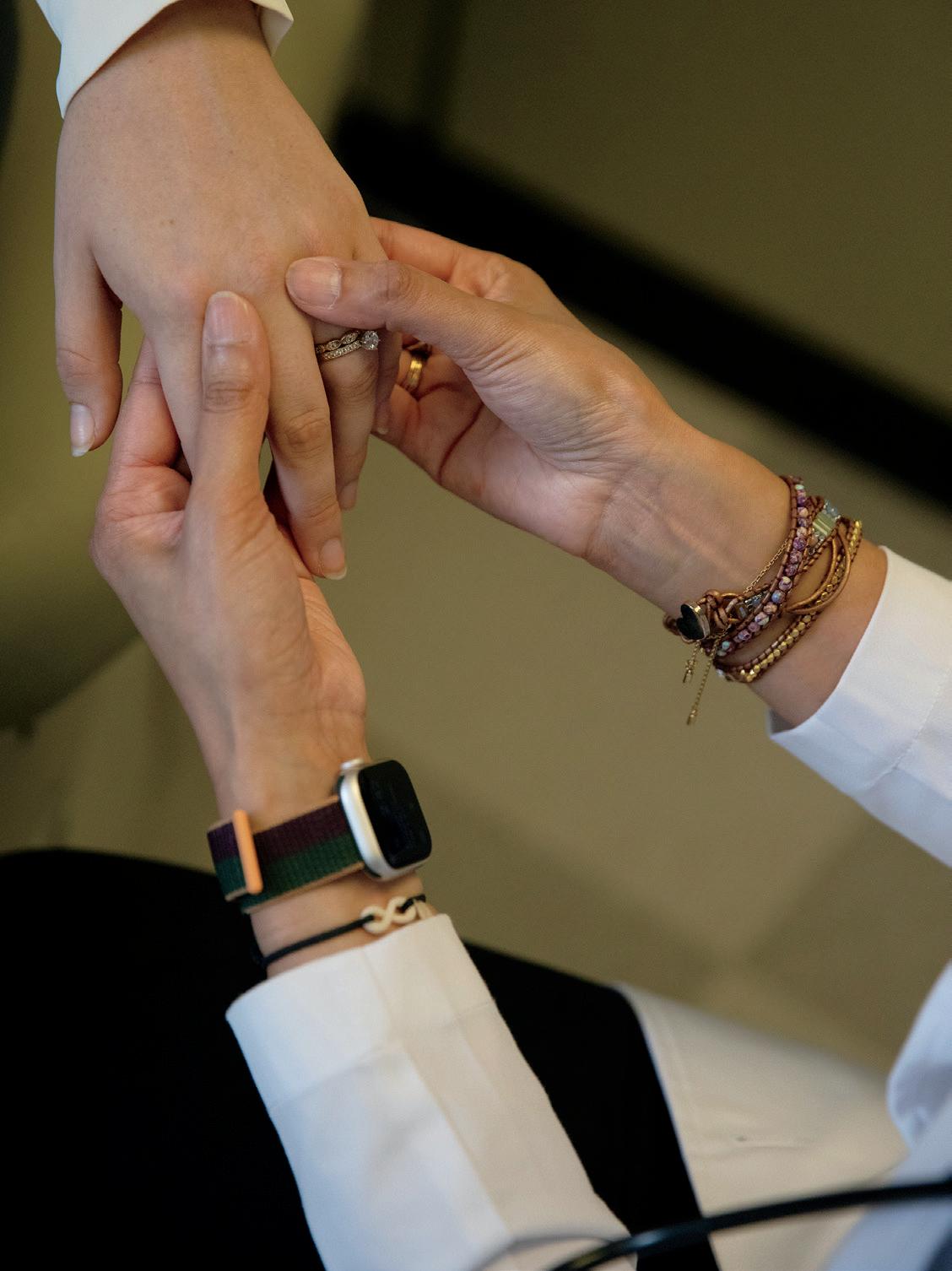
Graeme Robertson, director of the UNC Center for Slavic, Eurasian and East European Studies and professor of political science, studies influence, support and opposition within authoritarian regimes. His research efforts have been supported by the Harold J. Glass USAF Distinguished Term Professorship awarded through The Graduate School.

Growing up just outside of Glasgow, Scotland, in the early 1980s during the Cold War, Robertson took a train to school and would often meet U.S. military members stationed at a nearby nuclear base. Local rumor had it that this base was high on the list of USSR bombing targets should war break out.

“Like lots of teenagers at that time, I had a sense that Armageddon was near,” Robertson said. “The superpower conflict was the most important thing in my world, and I was really interested in trying to understand different political systems.”
Soon after college, Robertson served as a peace negotiator at the United Nations, working to broker resolutions among warring parties in the Yugoslav Wars. He described his younger self as “too naive” to believe that the peace process was doomed, and the experience impressed upon him the importance of studying the region’s history, culture and languages.
Since the onset of war in Ukraine, Robertson has shared his expertise and insight, while ensuring that people hear directly from Ukranians in the midst of conflict.
“I can bring Ukrainian voices to the table and help them be heard,” Robertson said. “When the conflict began, the mantra for our center was to magnify Ukrainian voices. Everything we’ve done has been an attempt to accomplish that.”
Rhonda Lanning’s passion for service has permeated her time at Carolina. Lanning revitalized the UNC Birth Partners program to make it one of the biggest in the country; she received the Office of the Provost Engaged Scholarship Award for Engaged Teaching in 2016; and she received support from the Carolina Center for Public Service to create a doula training course.
Now Lanning, a clinical associate professor in the UNC School of Nursing, is continuing to bridge campus and the local community with her project as a 2021–23 Thorp Faculty Engaged Scholar — a program that was expanded during the Campaign for Carolina.
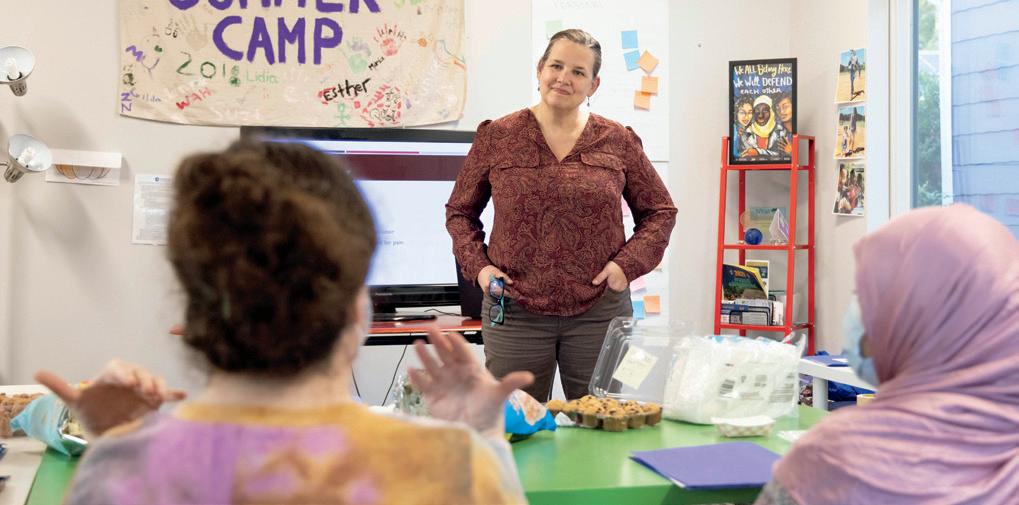
The Thorp Scholars program brings together selected faculty from across campus to engage in a two-year experiential curriculum designed to advance their engaged scholarship. Scholars participate in sessions throughout the two years in community settings to learn from both Carolina faculty and community partners. While developing individual projects, each class of scholars forms a learning community to support one another’s projects and benefit from a series of workshops and panels addressing issues of engaged scholarship. Lanning’s project as a Thorp Scholar furthers her collaboration with the Refugee Community Partnership in Carrboro, North Carolina. RCP helps migrants and refugees settle into their new environment and community. Lanning’s project provides training and experience to RCP community members interested in becoming doulas to help
their fellow community members navigate the health care system.
Doulas provide support and act as a caring presence in the room when a patient is giving birth or in the immediate postpartum. They do not act as medical professionals, but instead help make the birthing process a positive experience and help support the family, whether that be emotional, physical or informational support.
“As you can imagine, there are many, many barriers in terms of language, finances and new systems,” said Lanning.
Through her two years working with RCP, Lanning is strengthening community networks and providing regular doula training. Doulas will be able to support community members in their birth experiences and help with language interpretation and navigating unfamiliar health systems.
Ultimately, this experience builds on Lanning’s wealth of experience in bringing birth care to the greater community.
“There are a lot of amazing people in this community doing important work. I think the more we can develop relationships across campus with one another, but also with our community members in the greater area, the better.”
By Kay Langley ’22, ’24 (MA)F or almost 40 years, the Carolina Postdoctoral Program for Faculty Diversity (CPPFD) has been preparing scholars from different backgrounds for faculty careers and the tenure process. Of the more than 200 scholars who have participated in the program, almost 70 were hired into tenure-track faculty positions at UNC-Chapel Hill. Others joined faculty in more than 50 colleges and universities across the nation.
The program supports an average of three scholars per year. Thanks to the unrestricted funds provided by members of the Regents Society, Chancellor Kevin M. Guskiewicz was able to help the program expand with two additional scholars per cohort.
“These funds have been instrumental in allowing us to build a more expansive cohort from a broader range of disciplines,” said Associate Professor Joyce Tan, chief of research strategy at the UNC School of Medicine.
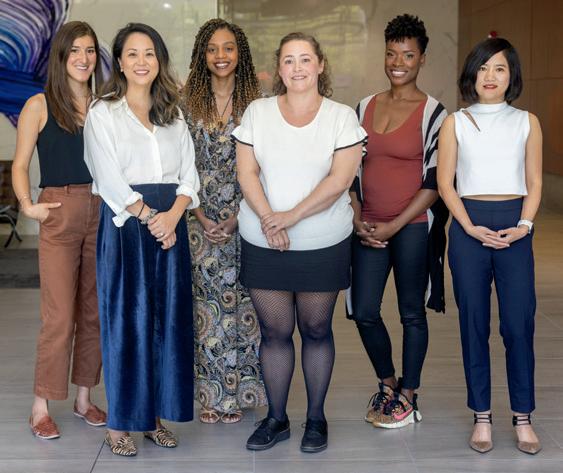
Hugo Méndez, a member of the 2016–18 CPPFD cohort who was hired into a tenure track position out of the program, said the list of benefits “goes on and on” for him years later. Méndez is now an assistant professor in the Department of Religious Studies in the UNC College of Arts and Sciences. “So much was packed into that program. I felt so dramatically prepared to enter into a faculty role.”

“It’s a program that is so profoundly worth the investment. It’s part of what gives our faculty the vitality and dynamism that it has, and I think it just ripples across the University.”
— Hugo Méndez2022–24 Carolina Postdoctoral Program for Faculty Diversity Fellows. From left: Anna Fetter, Julia Yi, Millicent Robinson, Raquel Escobar, Rebekah Cross and Ling Zhang
AT THE UNC SCHOOL OF MEDICINE, CRAIG CAMERON STUDIES HOW VIRAL ENZYMES CAN IMPROVE TREATMENTS FOR DISEASE.
It was April 1983 when Craig Cameron recalled seeing the cover of Newsweek that changed the course of his life. “EPIDEMIC” spanned the cover in huge block letters above a vial of blood marked “CAUTION KS/AIDS.”
Cameron was a senior in high school at the time and hadn’t really thought much about viruses and vaccines. Chickenpox and mononucleosis all seemed like rites of passage, something everyone got at some point and recovered from in a few days.
“It wasn’t until I read this particular issue of Newsweek that it became clear to me that a viral infection could be a death sentence,” Cameron said.
In 1994 — after graduating with his undergraduate degree from Howard University and earning his PhD from Case Western Reserve University — Cameron became a postdoctoral fellow at Pennsylvania State University, where he eventually taught biochemistry and molecular biology. He was driven to explore lab-based research rather than pursue medical school because he had a desire to provide a solution to the suffering he witnessed while volunteering in clinics working with AIDS patients. For most of his career, he has studied how viral enzymes can improve treatments for disease.
Cameron, the Jeffrey Houpt Distinguished Investigator and professor and chair of microbiology and immunology at the UNC School of Medicine, came to Carolina in 2019 and is trying to develop antiviral therapeutics and strategies for vaccine development. But there’s a catch: He wants to do so without knowledge of the specific virus that’s being targeted.
To effectively create antiviral drugs and vaccines that stop infection, it’s important to understand how viruses work. The goal of any organism is to reproduce itself, Cameron explains, and the same is true of viruses.
When the viruses Cameron studies enter a cell, they deliver their genetic information in the form of RNA, a complex molecule that has been getting a lot more attention lately thanks to COVID-19 vaccines. The viral RNA is then translated by ribosomes, the tiny machines in our cells that “read” RNA to create the proteins we need. The virus hijacks this protein-making process to replicate itself and infect other cells.
Every virus has proteins called enzymes with active sites that bind biomolecules and chemically modify them. These modifications are essential for establishing infection and producing more viruses.
“If we could understand, for example, the chemistry occurring at active sites of these conserved enzymes, we might be able to tune the reactions that are happening in a manner that prevents disease,” Cameron said.
Since the start of his career, Cameron has been interested in trying to figure out how different individuals respond to viral infections.
“Different people have different responses to SARS infection and a lot of that’s probably based in genetic differences between individuals,” Cameron said. “The question is: Can we tease that out in the laboratory?”
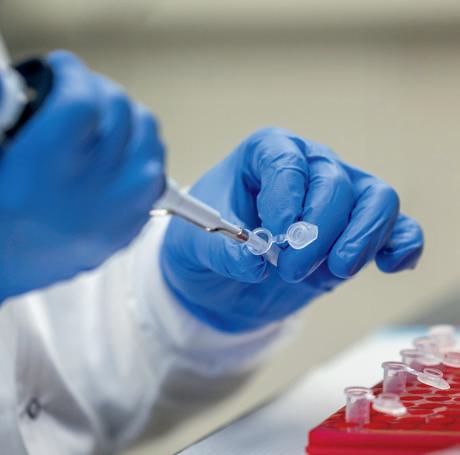
After noticing inconsistencies between experiments in test tubes and petri dishes versus ones run in animal subjects, they realized they needed a way to get more reliable results. Running random experiments in animal models while they tried to figure it out would be inefficient.
They also realized that the way most experiments were run resulted in a loss of information. The norm had been to aggregate data and draw conclusions at a
population level, but since a population is made up of individuals who each have their own genetic variations, not everyone reacts to a virus in the same way. There was a lot more information buried in the population-level experiments — like how the virus was spreading.
His lab wasn’t the only group to notice this problem. In 2014, researchers at University of California used polio to study the viral replication and subsequent infection in single, isolated cells. Cameron was a contributing author of a 2017 study that went further by introducing only one infected cell to one uninfected cell, allowing them to focus in on how the virus spreads on a cell-to-cell level. Now, his lab is continuing that work to discover new approaches for more accurate antiviral drugs.
“Every cell is not expressing exactly the same repertoire of genes or at the same level,” Cameron said. “Our realization here was that the population experiment was not really giving us the true accurate information on when viral infections start, and even if you have virus in cells, it’s not synchronous in every cell. So, we’re losing information that way.”
To better mimic the outcomes of viral infection in a mammalian host, the team realized they could use individual cells. Their approach would have a single virus infecting a single cell, allowing them to track how the virus enters, infects and leaves a cell.
Once the cell is isolated, they use fluorescent markers to track their infection under a special microscope. The baseline color is red. When a green-colored cell infected with a virus — usually polio — is introduced, Cameron and his team can track how the infection spreads from one cell to the other by tracking the fluorescent, emerald dot. The microscope takes an image of the cells every 30 minutes for anywhere between 24 to 36 hours.
Some of the initial observations show that some cells have an innate immunity to the virus. In other instances,
the virus makes the cell permeable, allowing it to leave one cell and infect another. Most interestingly, though, is a phenomenon where the virus spreads to another cell that doesn’t become permeable at all. This last observation excites Cameron, showing there are still many more discoveries to be made about the way infections spread.
Cameron believes gaining more knowledge about how viruses replicate and spread on a single-cell level will contribute to pandemic preparedness, helping scientists create antiviral therapies and vaccines without specific information on the infection. If they can make a drug inhibit an enzyme conserved across many virus families and essential for viral replication, then they might not need to have extensive knowledge on every new virus the world faces.
Thanks to a grant from the National Institutes of Health, Cameron and his lab are studying an enzyme unique to coronaviruses that proofreads the RNA genome as it’s being replicated. Interfering with the proofreading process could make coronaviruses sensitive to drugs developed for RNA viruses that lack this enzyme. Antiviral therapeutics to treat coronaviruses may provide the most robust response to variants capable of evading vaccine-induced immunity.
On a more reflective note, Cameron said there’s an interesting parallel between what he saw and experienced during the AIDS epidemic and now. He remembers volunteering during the epidemic in the 1980s and how seeing the deadly impacts of the disease helped him decide he wanted to be part of the solution.
“I think a lot of people are actually going to be motivated to go into virology because of all this happening with COVID-19,” Cameron said.
Cameron aims to develop antiviral therapeutics and strategies for vaccine development — but with a twist. He doesn’t want to know which specific virus he’s targeting.



Before joining the faculty at the UNC Eshelman School of Pharmacy, Owen Fenton studied under one of the world’s leading mRNA delivery researchers: Robert Langer, cofounder of Moderna. Getting Fenton from Massachusetts to Chapel Hill was a big win for the University. Fenton sees coming to Carolina as a win for his research interests, as well.
“I view the future of medicine as being very interdisciplinary, which was one of the biggest attractions in coming to UNC, where we benefit from being able to partner with amazing faculty and collaborate through groups like the Lineberger Comprehensive Cancer Center,” Fenton shared.
The University’s more than 50 core facilities — which offer the latest technologies and expert staff — were also a draw.
“This idea of discovery enablement is so important to next-generation therapy development, which is what our team focuses on here at UNC. If you’re part of a group working to develop new types of medicine, there is no better place to be than within the UNC Eshelman School of Pharmacy.”
Another important tool in recruiting Fenton to the school was Dean Angela Kashuba’s ability to access flexible, unrestricted funds from an endowment to help cover startup costs for the Fenton Lab. The endowment is supported by philanthropic contributions, including a $2 million gift from UNC pharmacy alum Donna Gutterman ’79, ’98 (MBA).
“Due to the generosity of our donors, we have the ability to quickly access funds and capitalize on big opportunities, like supporting Owen,” said Kashuba. “It’s humbling to see our alums and partners eager to help us in this way. I’m so grateful to be able to invest
their gifts in enriching our community and creating opportunities for significant impact.”
“That flexible support was critical to rapidly build up our team,” said Fenton. “To me, the most important foundation for success is a team-based environment that promotes creativity.”
Fenton describes himself as a “very people-centered person.” He attributes his team spirit to his father, a former professional hockey player. His academic interests he ascribes to his mother, a former educational professional and one of 10 children. Fenton, the younger of two brothers, grew up surrounded by family.
“I’m the only scientist in my family — but it fits,” Fenton said, laughing. “I love research and teaching, and a lot of that comes from my mom’s passion for education. I also developed my love of teamwork through my father, who helped inspire the collaborative research mentality in my lab.”
The Fenton Lab works broadly within the field of genetic medicine and its applications in treating diseases of the brain. Fenton’s research focuses on the delivery of mRNA therapeutics, which leverage the body’s own genetic code as medicine to treat

neurodegenerative diseases such as Alzheimer’s and Huntington’s, as well as cancers including glioblastomas.
“Treating these diseases is complex and requires an interdisciplinary approach that brings together experts from diverse backgrounds,” Fenton said. “Because of the critical support we received from Dean Kashuba and the University, we have already been able to bring together experts from key backgrounds. Working with this diverse team of exceptional researchers has really helped accelerate our work.”
Fenton said his transition to UNC Chapel-Hill, particularly amid the COVID-19 pandemic, was “outstanding.”
“We are ramping up to put out a pretty good amount of work shortly. We have been able to set up our whole pipeline for therapeutic development within a couple of months. At every level, there are so many great people. I strongly relate to this idea of creating better treatments for people, and I think that’s emphasized here in the ethos of the University and especially within the Eshelman School of Pharmacy.”
By Angela Harwood“In social work, there’s an interest in understanding what should be done about kids that are already in jail or in the foster care system,” said Melissa Lippold. “My work is more about understanding what happens before that. What can we understand about family processes that can help us develop programs that help nurture and strengthen family relationships? Because we know that strengthening family relationships is a really important lever for promoting child well-being.”
Prevention is both an important part of social work and an emerging field of practice within it, Lippold added. “More and more states are becoming interested in developing social workers and prevention scientists who can work on creating and implementing programs to help prevent some of the common problems that we know exist.”
Being named the UNC School of Social Work’s Prudence and Peter Meehan Early Career Distinguished Scholar was a meaningful recognition that provided Lippold with a salary stipend and research funding for this important work.

Lippold said the funds were critical in helping her team conduct pilot studies, which can help generate data supporting a new and exciting research direction, with those preliminary findings bolstering a grant application for a larger study.
As an example, she pointed to a revised version of an NIH grant that was “substantially stronger” thanks to progress made possible by a pilot study that confirmed some of the team’s initial ideas. “It allowed us to show support for our hypotheses about parenting strategies that might help youth manage and cope with stress during the transition to adulthood.”
By Claire Cusick ’21 (MA)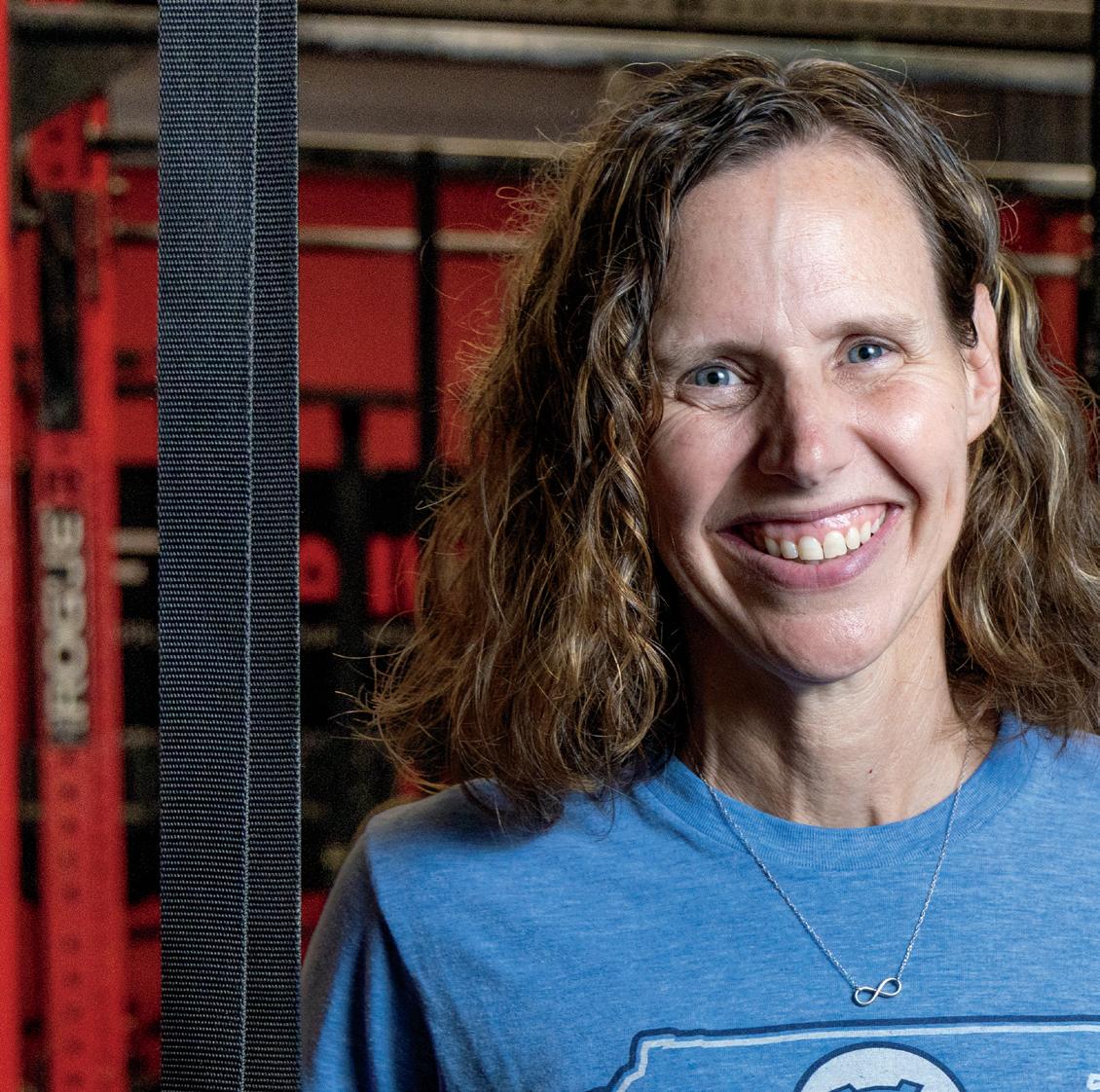

ASSOCIATE PROFESSOR KARA HUME COACHES
POWER HOUR, A FULLY INCLUSIVE ADAPTIVE FITNESS CLASS FOR YOUNG ADULTS WITH AUTISM AND OTHER DEVELOPMENTAL DISABILITIES.
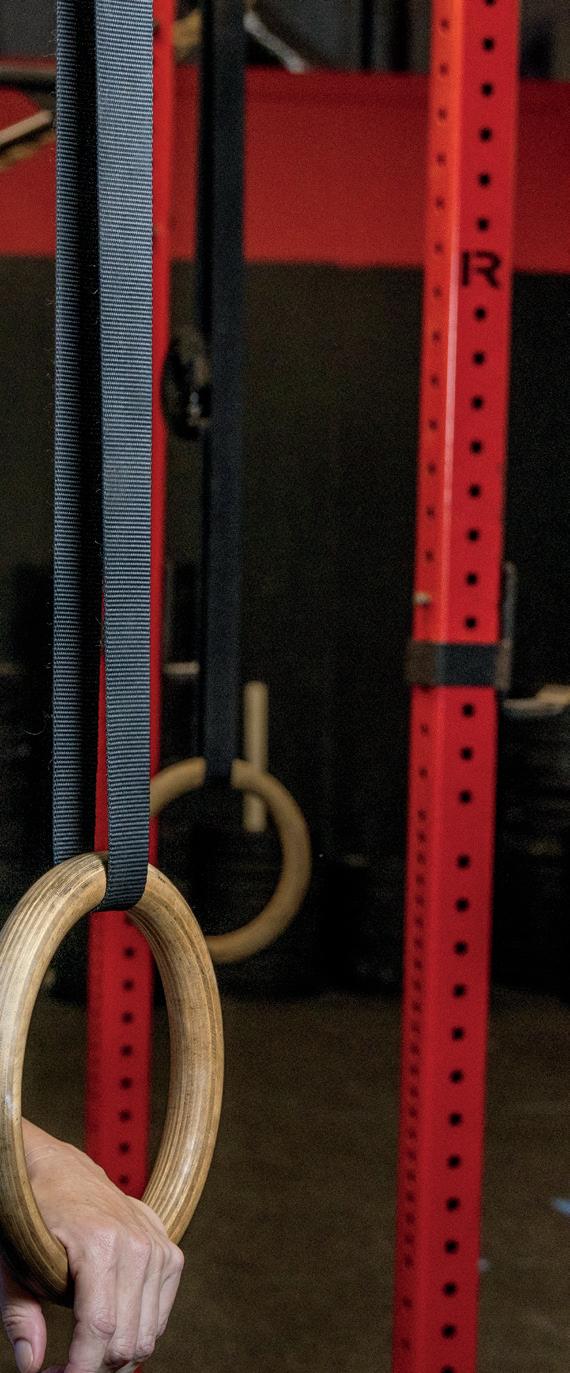
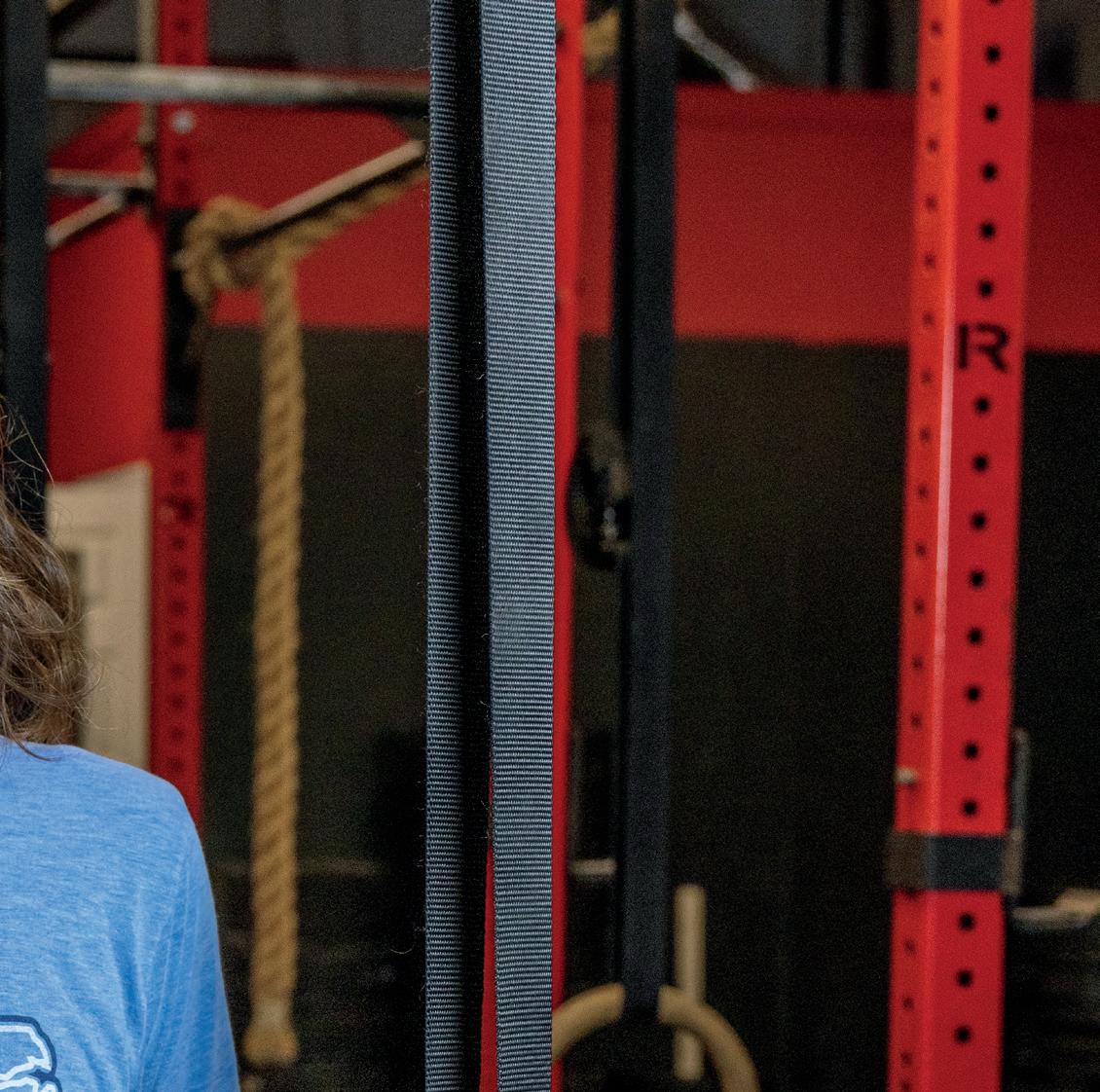 By Angela Harwood • Photos by Jen Hughey
By Angela Harwood • Photos by Jen Hughey
On Sunday afternoons, in a nondescript strip mall in Chapel Hill, muscles expand, hearts swell and a community thrives. It’s all happening at Power Hour, a fully inclusive, adaptive fitness class for young adults with autism and other developmental disabilities. At Power Hour, athletes of all ages, fitness levels and abilities get moving in a friendly, encouraging atmosphere.
“People here are so welcoming and patient with me at whatever level I’m at,” shared Hannah, an athlete in the class. “It’s not just an indifferent group of strangers; it’s a community.”
“I like meeting new people,” added Joey, “and it gets me off the couch!”
Hannah and Joey are among a number of athletes in the class who have autism. The class helps all attendees develop strength, balance, mobility and endurance —

but the primary focus is on building connections and community.
“At Power Hour, we’re trying to build inclusive communities outside of school or work settings,” said Kara Hume, who coaches the class. An associate professor at the UNC School of Education and a faculty fellow at the UNC Frank Porter Graham Child Development Institute, Hume has worked with children and young adults with autism for more than 30 years. In the past 10 years, her work has focused more on supporting autistic adolescents and young adults.
“We know that exercise has proven positive effects on a variety of outcome areas, from academics to adaptive behavior,” Hume shared. “But there is still a great deal to understand about how exercise can enhance mental health and self-determination — two areas in which I have great interest.”
The classes start with social interactive games that have a fitness component, like being on a team doing relays or assigning the class different exercises depending on whether they agree with a true or false statement, such as “I prefer UNC over Duke.” One side may be instructed to do sit-ups while the other side does push-ups. Just like any fitness class, there’s always a modification. Gunnar, a young man in the class who uses a wheelchair, is sometimes in his chair participating in group activities that tighten and loosen his muscles; other times he’s out of his chair doing physical therapy.
“I had some trouble keeping up at first,” shared Peter, an athlete who travels from Pittsboro, North Carolina, to attend the class. “But everyone is supportive, and I’ve made so many friends.” Another athlete, Rico, interjected: “I like the push-ups.” (He was on the side who liked UNC, though, so he did sit-ups.)
Hume is part of a truly exceptional group of faculty members and scholars at the UNC School of Education with expertise in special education who are focused on serving students with autism. These faculty seek to find solutions to improve health and well-being through applied research.
“We are in communities, in homes, in schools working with autistic individuals who are providing their input along the way,” Hume said. “I regularly hear from these youth, their families and teachers, that we need more opportunities to build connections, more places to foster a sense of belonging and more efforts to transform communities to better understand and support those who are neurodiverse. I believe sports and fitness — and in this case, Power Hour — can be a vehicle for all of this.”
As the coach of Power Hour, Hume said she can see the many benefits for all of the participants in each class.
“I can measure that in the amount of laughing we do and the amount of weight we move. But as a researcher,
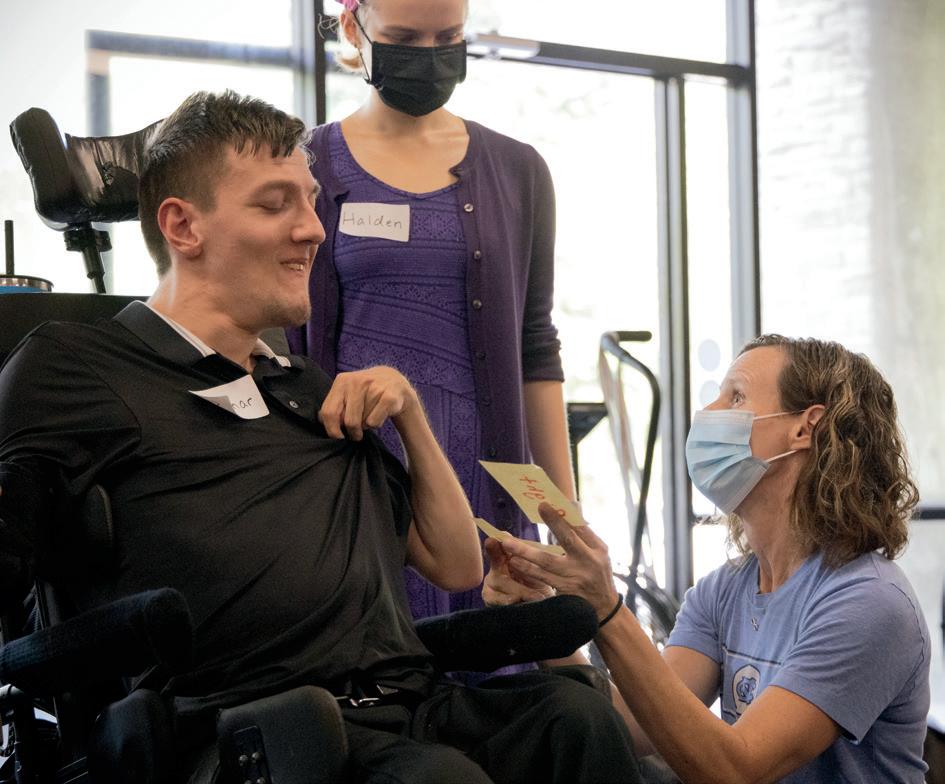 Gunnar, who uses a wheelchair, attends Power Hour with his physical therapist.
Gunnar, who uses a wheelchair, attends Power Hour with his physical therapist.
“ People here are so welcoming and patient with me at whatever level I’m at,” shared Hannah, an athlete in the class. “It’s not just an indifferent group of strangers; it’s a community.”
I have always wanted the opportunity to formally examine the social and health impacts of our program.”
As the newly appointed Richard “Dick” Coop Faculty Scholar in Education, Hume now has that opportunity. With the support of the award, she is designing and executing a small-scale pilot study on the effect of Power Hour — both on the athletes with disabilities and the other gym members who join in the class.

Hume’s hopes for this study are two-fold. One, she would like to see a reduction in feelings of isolation and loneliness for young adults with autism. She also wants to measure the benefits for participants who do not identify as having a disability.
“Everyone shares that they feel more engaged, happier and healthier at the end of our sessions,” she said.
“Special education research usually looks at the impact of activities on those with disabilities, but I think it is equally important to understand how we all benefit from working out and hanging out together. I want to know more about how the full community is thriving as the result of our participation in Power Hour — recognizing it’s a much more reciprocal process. I don’t think we know as much about that as we should.”
Hume plans to build on this work and has already submitted a grant request with a similar focus to the National Institutes of Health. The preliminary data from this pilot study will help her make a more compelling case to future funders.
The award is supported by a gift from Malbert Smith III ’77 (MEd), ’80 (PhD) and his wife, Alisa Edwards
Smith. The Smiths made the gift in honor of three former UNC School of Education professors — Richard “Dick” Coop, Gary Stuck and Kin White — to create opportunities and provide invaluable resources to help advance the research of faculty scholars.
“I appreciate that the school sees the value of this type of work and is investing in finding ways to keep making this important work happen,” commented Hume. “I am grateful and excited to have the opportunity to more formally study the effects of Power Hour with the support of these funds.”

As war raged in Ukraine, a psychologist with close ties to the country reached out for help to Ann Sam, an advanced research scientist at the UNC Frank Porter Graham Child Development Institute. Sam collaborated with colleagues from the schools of education (Kara Hume) and medicine (Jessica Steinbrenner) to develop simpleto-use, online resources for families and professionals helping children with autism deal with the effects of war and displacement. Their work is making a difference.
“At this challenging time for Ukrainians, a time of confusion, it is so important for professionals to have a reference point for working with their clients,” said a psychologist who works as a volunteer with school-age children in Ukraine. “The information is easy both to introduce and absorb [with] simple and understandable language to convey information to the children about the events that are taking place in our country. Thank you to the entire team involved in developing this material.”
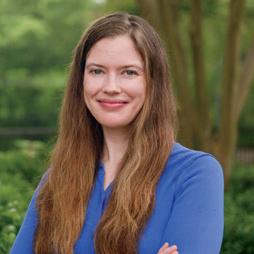
When Andrew Satterlee ’16 (PhD) was diagnosed with a rare brain cancer at age 20, he had to make the weightiest decision of his life. In the face of conflicting medical advice, the then-sophomore chemical engineering major at Kansas State University had to pick which cancer treatments to pursue.
Satterlee’s father, who worked in human resources at a local bank, threw himself into scientific research, learning all he could about the available drugs and reaching out to many experts in the field. Both men hoped that with enough research they would find definitive guidance on which treatment plan would be safest and most effective.
After undergoing surgery, chemotherapy and radiation, Satterlee made a full recovery. But the shock of having to pick a cancer treatment plan without medical consensus changed the course of his life and career.
Satterlee went on to earn a PhD in biomedical engineering from Carolina and then worked as a postdoctoral researcher studying glioblastoma in Associate Professor Shawn Hingtgen’s cancer research lab. He now serves as the brain slice technology program manager at the Eshelman Institute for Innovation, within the UNC Eshelman School of Pharmacy.
“I see our brain slice research as a form of patient advocacy,” he said. “It shouldn’t have been up to me as a 20-year old college student to figure out the best cancer treatment plan, nor should it be up to the many other cancer patients who have fewer resources and less support. Our research team wants to provide doctors with clear data on how each patient’s tumor will respond to cancer drugs, so that everyone can more easily make confident, informed decisions about their treatment.”
For over five years, Satterlee and his team have been treating human tumor cells with cancer drugs to determine the efficacy of those drugs for each specific tumor. This research is possible thanks to their use of brain slice technology, which places human tumors on a live section of brain taken from an animal model. This process allows tumors to stay alive outside of the body long enough for researchers to treat them with various cancer drugs and observe their reaction.
This research goes beyond the more common genetic testing of tumors, which indicates which treatments are likely to be effective based on a patient’s genetic predisposition. With brain slice research, the cancer drugs being considered for a patient’s treatment can be tested on their actual tumor to see how their cancer will respond before those drugs ever enter their body.
Satterlee’s team is designing a feasibility clinical trial and hopes that this technology will one day be a standard part of clinical care for brain cancer patients.
“I don’t want any other cancer patients to feel lost as they search for the treatment plan that has the best shot at saving their lives,” said Satterlee.
Satterlee is eager for this work to move beyond academic study and into the realm of clinical care. A grant from the Accelerate Brain Cancer Innovation Fund is helping the team move more quickly toward commercialization.
 By Audrey Smith ’10
By Audrey Smith ’10

“I don’t want any other cancer patients to feel lost as they search for the treatment plan that has the best shot at saving their lives.”
— Andrew Satterlee
Associate Professor David Drewry is optimistic that the challenge of chordoma treatment can be unlocked.
Drug treatments for a rare form of cancer called chordoma have eluded researchers for years. At the UNC Eshelman School of Pharmacy, Associate Professor David Drewry’s research has scientists and survivors optimistic that big breakthroughs in chordoma treatment are within reach.
A personal connection inspired Drewry to take on the challenge of chordoma when his daughter’s elementary school classmate was diagnosed with the disease at age 7. After a school fundraiser for the child, Drewry was introduced to a pathologist at University College London who was studying chordoma, and he sent her compounds for testing in chordoma cell lines.
“It was so important to my daughter,” Drewry said. “For me, buying a T-shirt was an easy thing I could do. It seemed more tangible to me as a scientist to put my training and expertise in play to make a longterm contribution.”
His collaborator’s discovery of a link between chordoma and a protein in the body called brachyury was a eureka moment. Active in the body during embryonic development, brachyury then shuts off in most people, but this new research showed that the protein remains active in chordoma patients.
That link presented a chink in the armor of chordoma, and Drewry began developing compounds to target
brachyury. Enlisting help from scientists at Oxford University with expertise in x-ray crystallography enabled Drewry to identify several compounds that bind with brachyury and appear to disrupt its function, a critical step in developing effective drug treatments.
The next step will be to show cause and effect. “That’s the next big thing we need to work on is understanding that the effect we see in a chordoma cell is due to this molecule binding to brachyury,” Drewry said. “That’s the next scientific challenge that’s going to push the field along.”
Private philanthropy, including foundation grants and a significant gift from a chordoma survivor who was treated at UNC Hospitals, has been critical to Drewry’s research and the renewed optimism that the challenge of chordoma treatment can be unlocked.
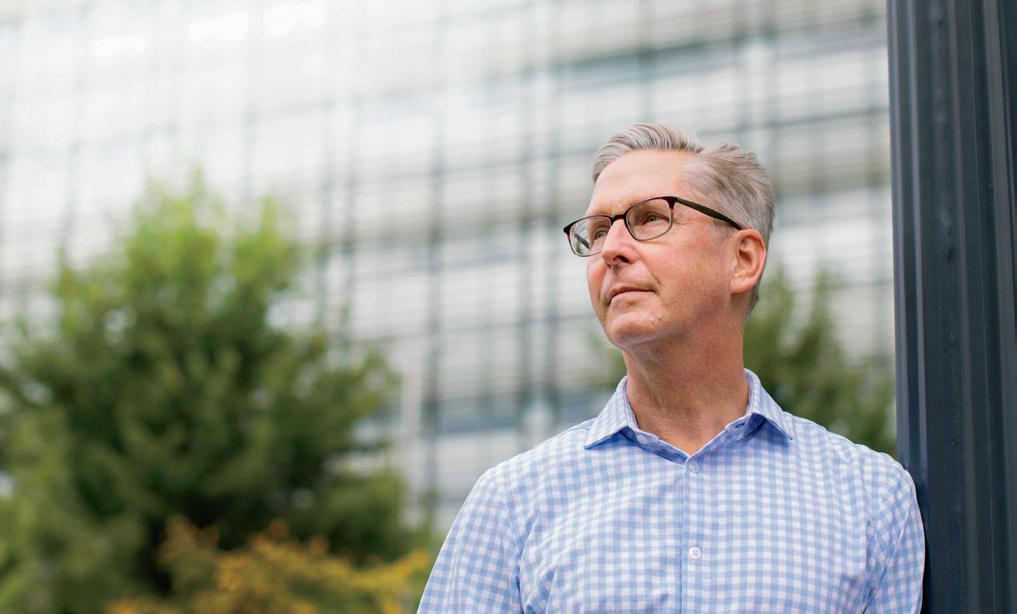
Josh Sommer, executive director of the Chordoma Foundation and also a chordoma survivor, uses a single word to describe the feeling Drewry’s work gives him: hope.
“It is truly justified hope that we can solve this problem now,” Sommer said. “It’s knowing that we are on the cusp of important discoveries. That’s why it’s important to support David’s work.”
By Drew Guiteras ’00Sometimes, the life-changing care patients receive inspires them or their family members to support advances in research. One such anonymous donor made a $25 million gift to UNC Lineberger Comprehensive Cancer Center in gratitude for the care a family member received while being treated for cancer at UNC-Chapel Hill — and to help expand and expedite UNC Lineberger’s cuttingedge, internationally recognized cancer research. The gift — the largest in UNC Lineberger’s history — established the UNC Lineberger Center for Triple Negative Breast Cancer, and it supports other key UNC Lineberger initiatives. The donor designated their gift to help women and men with all types of breast cancer, especially triple negative breast cancer because of its poor diagnosis. The highly aggressive breast cancer disproportionately affects Black, Latina and young women and historically has limited research funding.
Dr. Lisa A. Carey, the L. Richardson and Marilyn Jacobs Preyer Distinguished Professor in Breast Cancer Research, is the inaugural director of the new center. Carey, a medical oncologist who specializes in treating breast cancer patients, said it is hard to overestimate the gift’s potential impact on advancing triple negative breast cancer research and care.
“While research advances the past 30 years have led to new and more effective treatments for many types of breast cancer, this isn’t the case with triple negative breast cancer. The good news is this gift will be a game changer. It provides the cancer center with the resources to expand and speed the pace of our research focused on generating insights that lead to better treatments and outcomes for people with triple negative breast cancer.”

With a commitment totaling $13 million, Carolina scientists investigate the changing brains of teens in the age of technological wizardry and social media fixation.
Would you hand your 12-year-old a drug you knew was addictive, something that could disrupt sleep patterns and concentration, alter social behavior and decrease the desire to exercise? Would you give this drug if it could rewire their brain? A lot of parents are handing this drug to kids. It’s called a smartphone, neurology and psychology researchers at Carolina have concluded.
Maybe “phone addiction” isn’t news to those of us hopped up on Twitter or TikTok, scrolling mindlessly as we “relax.” Or maybe we think it’s a benign obsession, like when a child is hooked on a sport or books or learning a musical instrument. Not quite. Passion for a hobby or profession is not the same as addiction, and researchers worry that addiction is particularly dangerous when the brain is changing so dramatically during adolescence.
“Aside from the first year of life, the years around puberty are the most important time for brain development,” said Mitch Prinstein, the John Van Seters Distinguished Professor of psychology and neuroscience. He teaches a course at Carolina on teens and technology with Eva Telzer, an associate professor, and with Assistant Professor Rosa Li.
Teenage years are when we train our brains for adulthood. Many parents have decided it’s okay to hand kids electronic devices, essentially enrolling them in an uncontrolled experiment on the effects of technology and social media on brain development, said Jim Winston Jr. ’81, ’92 (PhD), a practicing psychologist and parent of two adolescent boys.
Winston said this experiment is having disastrous consequences. His initial response came in 2018, when the Winston Family Foundation, of which he is one of five family directors, donated $3 million to Carolina. The funding supports Prinstein and Telzer to research the effects of technology and social media on brain development, a college course on teens and tech, and a website, teensandtech.org, that provides the latest science on the effects of technology and social media on the brain.
In 2022, the foundation gave Carolina an additional $10 million for the creation of the Winston National Center on Technology Use, Brain and Psychological Development. Co-directed by Prinstein and Telzer, the center is expanding the three core initiatives: research, curriculum development for students of all ages and outreach to parents.
“I’m horrified and ticked off at what smartphones and social media are doing to kids,” said Winston, who has decades of experience helping people battle addiction. “I think tech and social media companies are weaponizing what they know to be addictive products. And they are doing this for profit.”
Smartphones were originally designed to add conveniences, efficiencies and capabilities to life. Then came social-media platforms, which allowed for people to connect and express themselves online like never before, to build communities and
audiences, to find and share news quickly and even to create successful businesses.
Emerging research, however, shows some not-sogood effects, such as cyberbullying, depression, anxiety, sleep disruption, unrealistic expectations and addiction.
“Social media is not pure evil,” Prinstein said. “The effects of social media will be different for every kid. But are social media apps designed to be addictive? Yes. Do they capitalize on vulnerabilities in the developing brain that should make us more scared for adolescents than any other age group? Yes.”
Now, with thousands of apps and games and ubiquitous social-media platforms, Winston said smartphones entice users to engage as much as possible, usurping attention from important aspects of life and increasing risk of attention-deficit disorders and addiction.
“I want parents to know, when they give a phone to their child, there is the distinct possibility the kid will be incapable of reading a 400-page book at age 30,” Winston said. “They won’t be lazy or unwilling or stupid. I mean, neurobiologically, they’ll be incapable. Their brains will have been so rewired for hyper distractibility that keeping their attention fixed long enough to read a book will be impossible.”
Prinstein and Telzer share Winston’s concern. No known research has followed children over the course of adolescence and through the teenage years to detail tech and social-media effects on the brain and behavior. The Winston national center is changing that. “We want to be the place people go to seek out the most state-of-the-art science in this area,” Telzer said.
The brain is an absurdly complex network of neurons working together to keep humans as sane and
Her lab has already shown that when it comes to children’s brains, social media is far from benign.
functional as possible. Even something as simple as keeping our attention focused on what we are doing right now involves a suite of brain regions called the salience network. The salience network keeps our attention focused on the most important thing in our environment at a particular time. For example, I’m focused on writing instead of the sun shining through the window or the dog barking or my phone staring at me, begging me to use it.
The salience network is activated, for instance, when we’re hungry because an empty stomach, at that given time, is the most salient experience. Then, the prefrontal cortex is engaged to respond at a higher level. Should I eat now? What should I eat? Where? How much? When is the next time I plan to eat? As we eat, the primitive areas of the brain fire in connection with dopamine and oxytocin brain cell receptors in response to pleasure. “Wow, this pizza tastes great!” And then our prefrontal cortex control center responds, “Yeah, but obviously do not eat the entire pizza.” Then, when we stop eating for several minutes, our GI tract communicates through neurons
to our brain, and our salience network allows us to focus on something else, like work — or Instagram.
“It’s a gas-pedal, brake-pedal situation in our brain,” Winston said. When it’s out of whack, the consequences can lead to attention disorders, addiction, eating disorders and behavior problems such as anxiety. Winston is so concerned about the dangers of addictive technology in the hands of youth because smartphones can hijack the delicate balance between gas pedal and brake pedal.
To parse the power of the smartphone and its applications, Telzer’s lab started a study in 2018, enrolling 178 pre-teens and documenting their technology use and brain development over three years. At the start, scientists asked each child how much they accessed social media and categorized their use as frequent, moderate or infrequent.
The researchers then used functional magnetic resonance imaging, or fMRI, to measure the brain activity of the participants while they performed simple tasks such as naming a shape like an oval
or a square. The child was shown a smiling face of a teenager, if he or she completed the assignment in the allotted time, or a frowning face, if the child was too slow. (The allotted time was arbitrary.) The researchers conducted fMRI tests again a year later and then a year after that.
Telzer found increased levels of activity in the salience networks of the frequent social-media users when they were shown faces of approval or disapproval. She also found increased activity in the prefrontal cortex, the region that would tell the kids “enough is enough.”
“This is only one study,” Telzer said, “but it implies these sorts of stimuli — the reward and punishment faces — are becoming more salient to the adolescent.”
As a result, Telzer said she believes the prefrontal cortex is becoming more engaged than usual as it responds to the increased salience activity. But, as Winston would say, the gas pedal is winning.
Other researchers conducted fMRI studies in which children were shown pictures of a bear and poison berries. As expected, a part of their primitive fight-orflight brain region lit up, signaling a healthy survival response to danger. But when researchers added a bunch of “likes” — an image of a heart or thumbs up typically used by social media platforms — in the corner of the same picture, the salience region became more active while the prefrontal cortex dimmed. The likes changed how the children’s brains processed the image, the scientists concluded. The participants focused on the likes instead of the fact that poison berries can make you sick and a bear can kill.
Winston is a psychologist who’s worked with people from all walks of life, including people addicted to drugs in a federal prison in Butner, North Carolina. He knows what addiction looks like, what it can do to individuals and families and how sneaky it can be.
“Over 30 years practicing, I’ve learned that the earlier people develop addictive patterns, the more difficult their life course is,” he said.
About six years ago, Winston walked his sons into a Miami school and saw before him a sea of kids, their faces buried in their smartphones. A few kids bounced off Winston, oblivious to his presence, captive to their screens. Winston said the scene astounded him. Soon after, he began poring over research on the effects of technology. He came across a book by Nicholas Carr, The Shallows: What the Internet Is Doing to Our Brains. Carr argues the internet is changing how our brains function, and not for the better.
Winston learned that children are relating to each other much more through technology than ever before. Empathy is down 40%, according to researchers at the University of Michigan. Kids are not learning how to read people’s expressions by simple eye contact, according to UCLA researchers.
“They send messages through apps and social media without understanding the impact of those messages,” Winston said. Kids are now highly distractible and often without fully comprehending it.
Winston’s research revealed an increase in adolescent anxiety, depression and suicidal ideation. “I can’t prove a causal effect between cellphone use and these things,” Winston said. “But when you see youth cellphone ownership pushing above 50 percent, and you see all these psychological variables, it’s not hard to intuitively and deductively see the use of phones as a main contributor.”
Some social media platforms experimented with decreasing their dependence on the system of likes, but users told the companies they wanted to keep the symbols. The companies backed down, an interesting response, considering that vocal critics might have been addicted to social media.
“No one will be shutting down social media,” Prinstein said. “That horse has left the barn. But I think we’re at a choice point: Do we want to use this brilliant tech to enhance child development and use science to teach kids really helpful life lessons? Or will we be driven by the desire to make a profit? Maybe there’s
“That’s how powerful social media is,” Winston said.
“It’s like the instinct for community acceptance is as powerful as hunger.”
a way to do both. But right now it feels very, very skewed toward the profit motive.”
As Big Tech makes money, Winston is spending his. And he’s doing so at Carolina because he said this place is in his blood, and Carolina has the expertise and desire to be a big part of the solution.
Six generations of Winstons have attended Carolina, including George Tayloe Winston, University president from 1891 to 1896. Jim’s father, James Horner Winston ’55, donated money in 2004 to establish the Winston House for the UNC European Study Center in London.
Jim’s father was a real estate investor, and when he died in 2018, he bequeathed nearly all of his fortune — about $100 million — to create the Winston Family Foundation.
“We were all shocked at the amount,” Winston said. “My father was old school, thought money corrupted people. He lived way, way below his means. We had no idea how much money he had.”
The foundation focuses on education and the arts. Winston already was obsessed with researching the effects of technology on kids’ brains by the time his father died. Shortly after, he contacted Carolina in 2018 to meet with Kevin Guskiewicz, dean of the College of Arts and Sciences at the time and now UNC-Chapel Hill chancellor. He also met with Prinstein and Telzer, whose research on mental health and adolescent brain development had established them as national experts.
After the meeting, the foundation donated $3 million to establish the Winston Family Initiative in Adolescent Brain Development and Technology, which allowed Telzer to start her three-year fMRI study and for the College of Arts and Sciences to create a new course, “Social Media, Technology and Adolescent Development,” which was first offered in the 2020 fall semester. Prinstein and Telzer taught the inaugural class of 240 students. Li, hired as an instructor through the initiative, taught a 60-student section.
Li breaks down her course into four sections: the science of the adolescent brain, tech and peer relationships, tech and the brain, and tech and mental health. She focuses early in the semester on the ways technology companies are capitalizing on the
reward system in the adolescent brain. Later, she asks students to invent ways to make apps more engaging so they hold users’ attention for as long as possible.
Li said this exercise is when students get it, if they hadn’t gotten it already: Why would technology companies make their apps free? The companies have answers. Facebook, for instance, says they charge companies to put ads on our Facebook pages, which keeps their app free and available to everyone. But 4,000 pages of documents from 2011 to 2015 leaked to NBC News show that Facebook used our data — including photos and information we post online — as leverage in negotiations with companies that advertise on the platform. What companies can and cannot do with our data is found in the “terms of service” we agree to, often without reading them.
Deep into the semester, with students realizing social media is something to take seriously, Li gets crafty with her own experiment.
In psychology, the Diagnostic and Statistical Manual of Mental Disorders, or DSM, is the authoritative source for what is considered a mental illness. It contains an 11-question diagnostic tool for substance use disorder and gambling addiction. If you answer two or three questions affirmatively, then you have a mild addiction. If you answer yes to four or five questions, then you are moderately addicted. Answer affirmatively to more than six, you have a severe addiction.
Without telling her students she’s using the DSM addiction criteria, Li swaps out “alcohol or drug use” with “social-media use” and has the students answer the 11 questions before reporting the number of questions to which they answered “yes.” Then she tells them they just took the official DSM test for addiction.
The DSM does not list a “technology addiction disorder.” But the manual includes a line about tech addiction being worthy of further study, a teaser that it might be included as a disorder in a future DSM edition, said Prinstein, who serves as the chief science officer for the American Psychological Association, which publishes the DSM.
Li said most of the students qualify for mild or moderate addiction and some for severe addiction. They also told Li they get irritable or anxious if they stop accessing social media for a while, which are signs of withdrawal in other addiction disorders.
This exercise, and others in the class, excite the students, Li said. Some set up chat groups to discuss the course work and to set up debates — a positive use of social media, according to Prinstein. Several UNC students formed an organization called Students for More Humane Technology — an oldschool method of social connectedness.
In his 23 years teaching at Yale and UNC, Prinstein said, “it’s the most engaged I’ve ever seen college students. I’ve never seen students form a club based on a class. Usually they take the final, and we’re done. But they want to keep the conversation going. They want to stay active.”
It’s also one of the most popular courses in a popular major at Carolina. The 300 seats in two sections fill in five minutes when the University opens classes for registration, Prinstein said. The class is an elective mostly reserved for first- and second-year students.
Carolina senior Ben Dameron took the course in spring 2021, and he said it’s the reason he joined
Telzer’s Developmental Social Neuroscience Lab as a research assistant. Dameron said he had a lovehate relationship with social media before coming to Carolina and wants to continue working in the field after graduation, which may include helping address mental health problems associated with social media use or joining a social media company’s ethics team.
“My main concern is the role technology plays in the polarization of society,” Dameron said. “People are living in different realities. And social media companies are trying to get us to stay on their sites as long as possible.”
As part of the first Winston initiative in 2018, Li co-created a course for middle school students with Kelley Brill, a STEM and technology instructor at the Miami Country Day School in Florida, which offers the course to seventh and eighth graders. Li said she brings the science piece, and Brill can reach kids of
this age. The students keep a journal about how they feel when they use social media or when they go a day without it. This exercise opens the students to the idea that technology is not benign, Li said.
At Country Day, the only seventh grader without a smartphone is Jim Winston’s child, who has an old-style flip phone, which doesn’t have internet access and can only send text messages. The kid is embarrassed by it and has asked his father why he can’t have a smartphone.
“I told him, ‘Because I’m steeped in this issue, and I care about your brain, not your image,’” Winston said. “I know enough to set a firewall in the face of him being the only one in seventh grade without a smartphone.”
But Winston is an outlier, at least in Miami. First, flip phones are becoming extinct. Second, smartphones are affordable super computing music libraries with three camera lenses and instant access to a wealth of human knowledge, plus streaming services, games and live sports. Brill and Li are now creating versions of their middle school curriculum for elementary and high school students.
Back in Chapel Hill, toward the end of each semester, Li, Telzer and Prinstein ask their students for feedback, how they view technology and social media and how they view their own experiences.
“Invariably, they say they wish their parents hadn’t given them a phone at age 12,” Prinstein said. “They tell us, ‘I can’t concentrate. I can’t sleep. I’m wasting my time. I can’t study. I’m anxious when I talk to people in person.’” Most students realize they’re hooked. And they don’t like it.
For all of Winston’s passion, he knows he, Brill and researchers at Carolina are swimming against the current. His family’s foundation has donated $13 million; social media companies are worth billions of dollars.
“We need to shift the national narrative away from ‘this is just a phone,’” Winston said. “That’s bull. You are handing your kid an overstimulating device they are incapable of regulating, something that alters their brain. The whole effort here is to generate enough awareness to create a critical mass. It took 30 years to break through on cigarettes, and those things cause cancer. Our project might take a while, but we have to start somewhere.”

This article was originally published in the July/August 2022 issue of Carolina Alumni Review. The illustrations, photographs and sidebars shared here were not part of the original publication.
It’s not just our teens we should be worrying about when it comes to the ill effects of social media. A new research center at Carolina is focused on evaluating the impact of the internet, social media and other forms of digital information sharing on society and politics. The Center for Information, Technology, and Public Life (CITAP) brings together faculty from journalism and media, information and library science, and communications to address the intersection of politics and digital technology. The center’s work is made possible by philanthropic support.
“CITAP capitalizes on the fact that Carolina is home to some of the nation’s leading communication, information, journalism and legal scholars, as well as highly regarded centers focused on media law and innovation and sustainability in local media,” said Gary Marchionini, dean of the UNC School of Information and Library Science.
“We envision the center as a crucible for ideas and a living laboratory for understanding the core information needs of American democracy and other socio-political systems.”
The emergence of COVID-19 in 2020 created international awareness of the risks posed by novel viruses, but many researchers had seen warning signs flashing for years. In fact, COVID-19 was not the first, but the eighth, epidemic or pandemic caused by zoonotic viruses — those that can spread between animals and humans — to occur in the 21st century.
This begs the question: What if we didn’t have to wait for the next virus to emerge before we started working on solutions? What if scientists could combat the next outbreak before anyone had been stricken with a deadly disease? What if pharmaceutical companies could build supply and distribution channels of life-saving therapeutics before patients even needed them?
Led by Carolina researchers and funded in part by private support, the Rapidly Emerging Antiviral Drug Development Initiative (READDI) is working to give humanity an early advantage against such future diseases. READDI is a new nonprofit organization created by UNC-Chapel Hill that brings together scientists from academia and industry at institutions across the world to efficiently share knowledge and develop antivirals that will help combat the next pandemic.
A collaboration between scientists at the UNC School of Medicine, the UNC Eshelman School of Pharmacy and the UNC Gillings School of Global Public Health, READDI’s goal is to give the world’s best scientific and business minds a head start on developing and delivering novel antiviral drugs before global catastrophe strikes.


Though targeting not-yet-discovered viruses presents obvious challenges, scientists believe that it is possible to develop broad-spectrum antivirals that are effective across virus families — like coronaviruses. A second strategy focuses on the host, rather than the virus. By blocking cellular changes within the host, scientists can begin creating drugs for viruses with sequences not yet known.
“There’s lots of evidence to support that across a virus family, all the members use a common strategy
Researchers at UNC-Chapel Hill are searching for new antiviral treatments for both existing and future viruses.
to do that,” said Ralph Baric, a READDI founder and professor of microbiology, immunology and epidemiology. “So if you can target those pathways, you can develop broad-based drugs that would work against all members of that virus family.”
READDI has already forged partnerships with collaborators, including universities, research centers and pharmaceutical companies around the world. Nat Moorman, a READDI founder and associate professor of microbiology and immunology, said these collaborations will pay dividends.

“Making a drug takes time,” Moorman said. “And it takes dedicated effort and resources, and as we’ve seen right now, if you don’t do that work ahead of time, you won’t be prepared when the next virus emerges.”
SARS-CoV-2 won’t be the last pandemic the world will face, and researchers at Carolina are determined to help humanity be ready for the next.
One of the perplexing questions about COVID-19 is why some patients experience ongoing, debilitating symptoms for months after their initial infection. Doctors at UNC Hospitals are working to understand and treat Long COVID symptoms, including brain fog, memory loss, extreme fatigue and other life-altering health problems.
Led by Dr. John M. Baratta and Dr. Louise King, the UNC COVID Recovery Clinic opened in March of 2021 and has treated more than 1,000 patients with Long COVID from across the country.

“I think there is a lot of fear associated with a COVID diagnosis and post-COVID symptoms,” said King. “If we can help reassure and treat people it would be a huge benefit to them.”
Though the underlying cause of the syndrome remains unknown, researchers estimate that 10-30% of COVID patients suffer from Long COVID. Data the clinic has shared show that it is treating more women than men, that 90% of patients were not vaccinated before they caught COVID and that many patients had mild initial cases.
The clinic also serves to disseminate knowledge about the syndrome. In May of 2022, the clinic hosted the UNC Long COVID Symposium to discuss and share best practices for treating Long COVID patients. More than 180 health care professionals and experts attended.


Innovation-minded Tar Heels are tackling the world’s most challenging problems. Carolina faculty, students and researchers lead the way in technology innovation; their ingenuity is driving the world forward, solving challenges from the operating room to the board room.
By Audrey Smith ’10 • Illustrations by Christina BerkowitzWhen a patient needs an organ transplant the process of matching the recipient with a compatible donor is complex — and must be completed in mere hours before the organ expires.
Eric Weimer, associate professor of pathology and laboratory medicine at the UNC School of Medicine, leads a team that assesses compatibility between recipients and deceased donors. He has long noticed a connection between how well recipients tolerate a new organ and whether or not they share certain biological factors with their donor. He believed that virtual crossmatching, or using technology to identify the best recipient-donor matches, could improve access to donated organs and allow organs to function longer in recipients’ bodies.
He knew that building this technology would require deep mathematical expertise, so he went to the UNC College of Arts and Sciences website and searched the mathematics department’s faculty page. After seeing that Associate Professor Katie Newhall had expertise in biological modeling, he sent her a cold email asking if she’d like to discuss a possible collaboration.
“I really believed that if we could get this right, we could build something that would improve patient outcomes and increase access to organs.”
— Eric Weimer
“I really believed that if we could get this right, we could build something that would improve patient outcomes and increase access to organs,” said Weimer.
It’s been more than six years since Newhall and Weimer connected, and in that time they have built a machinelearning process to predict immunologic compatibility, or the likelihood that a recipient’s immune system will accept or reject a donor organ. The work to date has analyzed historical matches, but the team expects it will be used for active cases — matching patients in need of a new organ with their most compatible donor — in the near future.
Weimer and Newhall’s technology was selected by the UNC Eshelman Institute for Innovation’s Venture Studio to receive a capital investment, be licensed and launch the new start-up Epulate. Weimer and Newhall serve as company advisors, but the addition of a CEO, chief technology officer and investor team are providing the business support needed to move the technology toward commercialization and use in the real world.
Both Weimer and Newhall agree that they never would have gotten where they are now without collaborating.
“I loved working on such an interdisciplinary project — it’s one of the big reasons why I became an applied mathematician,” said Newhall. “Each discipline has carved out as much as they can on their own, and now you have to come together with those from other disciplines to make real progress.”
Seven other transplant centers have signed up to pilot the technology, which will give the team access to much broader geographic and demographic data that can then be used to further train and improve the algorithm.
Artificial intelligence is everywhere — from the Alexa device on your kitchen countertop to the chatbots that provide automated customer support — but it’s difficult for businesses to adopt these technologies or use them to their full potential.
Saravanan Kesavan, professor of operations and Sarah Graham Kenan Scholar at UNC Kenan-Flagler Business School, is convinced that if Carolina students are going to be the leaders of tomorrow, they must know how to lead organizations in their use of the newest technologies.
This challenge led him to found the AI Management Lab in April 2022. The lab, housed within the Rethinc. Labs as part of UNC Kenan-Flagler’s Frank Hawkins Kenan Institute of Private Enterprise, will teach students how to implement machine learning technologies in business settings.
The lab’s founding partner, Advance Auto Parts, established it with a $150,000 gift and is collaborating on research and learning initiatives like the lab’s Datathon.
At the Datathon event, business students worked with Carolina students from data-science-focused fields, such as computer science and information and library science, to execute machine learning programs. These programs used real-world business data supplied by Advance Auto Parts to determine which merchandise should be offered in the company’s 3,000 stores.
“Technology and data are the biggest story in business,” said Kesavan. “Business students must learn how to partner with data scientists, and how to use their own expertise as change managers to lead organizations through the massive changes that AI is going to require.”
Kesavan describes the biggest problem that businesses face with AI and machine learning by sharing an example from his corporate experience. A retail client spent more than $1 million to purchase machine learning programs that could improve their merchandising decisions. But when the program was deployed, the client failed to improve profits because the managers who worked in merchandising overrode 70% of the program’s recommendations.
Kesavan and his team analyzed the problem and found that while these overrides reduced the business’ overall profitability, the managers were correct to override decisions about new products. In those cases, the managers correctly knew that an item would sell even though there wasn’t enough purchase data yet for the program to recommend it.
“It’s not always easy for humans and machines to work together, but when organizations find ways to combine human leadership and automation correctly, they achieve the best results and the highest profitability,” said Kesavan.
Many of the students working in the AI Management Lab with Kesavan didn’t have previous experience with machine learning, just a desire to learn. The AI Management Lab welcomes participation from interested students of all backgrounds and additional corporate partners.
Outside her home in Lusaka, Zambia, a mother proudly gazes at her two newborns. The woman and her twins were cared for at the Kamwala District Health Center, one of two sites where UNC faculty members conduct joint research with the University of Zambia School of Medicine.
“During her ultrasound, we discovered the young woman would be having twins, meaning she was at a higher risk,” shared Margaret Kasaro, research assistant professor with UNC Global Women’s Health (GWH) — a group of clinicians, researchers and public health professionals working to improve the health of women in some of the world’s poorest countries.
The mother received free obstetrical ultrasounds as part of the Fetal Age Machine Learning Initiative (FAMLI). The study, funded by the Bill and Melinda Gates Foundation, is an ongoing project that is developing technologies to expand obstetrical ultrasound access to low-income settings where cost and logistics have traditionally prevented its use. Investigators from the Institute for Global Health and Infectious Diseases, UNC School of Medicine
and UNC Gillings School of Global Public Health developed a deep-learning artificial intelligence model that can accurately estimate gestational age using a point-of-care ultrasound device.
Simply being a part of this study potentially saved this woman’s life. In contrast to the U.S., where the average person gets two to three ultrasound scans during pregnancy, most Zambians don’t have access to ultrasound at all, unless they live in urban areas. Even then, they might not receive a scan unless there is an obvious complication.
“Without the ultrasound, she would have found out she was having twins while giving birth, when it could have been more challenging to intervene,” Kasaro stressed. Although most Zambians deliver in a health facility, it is common for them to arrive already in advanced labor, increasing the risk of adverse events to mothers and infants.
The study, conducted from September 2018 through June 2021, recruited 4,695 pregnant volunteers in North Carolina and Zambia. The volunteers received blind ultrasound sweeps of the pregnant abdomen alongside standard fetal measurements, collected on both the commercial

ultrasound machine and a low-cost, batterypowered device (Butterfly iQ). Researchers trained a neural network to estimate gestational age from the sweeps.
In each of three test data sets, the AI model performed at least as well as a trained sonographer using a standard cart-based machine.
“Ultrasound is like a stethoscope to the modern obstetrician,” said Dr. Jeffrey Stringer, professor of obstetrics and gynecology and director of UNC’s division of GWH. “We use it all day, every day. These results foretell a future where all pregnant people — not just those who live in rich countries — can access the diagnostic benefits of obstetric ultrasound.”
Growing up with a chemist for a father and an educator for a mother, Isis Trujillo-Gonzalez was encouraged to explore and express creativity from a young age. Her parents also nurtured her passion for science alongside her grandmother, a local midwife whose home was always stocked with natural remedies, such as local plants, to treat ailments.
Now an assistant research professor at the UNC Nutrition Research Institute, TrujilloGonzalez is forging her own way as a prominent research scientist with funding support from Balchem Corporation. She aims to understand how choline, an essential nutrient, improves the way we think and behave before we are even born.

The critical role of choline in human health begins in the womb, attained through a mother’s diet of foods such as eggs, salmon, milk and liver. Low choline intake during pregnancy has lasting negative effects on a child’s attention, memory and ability to problem-solve. But how can a single nutrient create such long-lasting impacts in the relatively short amount of time it takes to form a brain?
As a postdoctoral researcher, Trujillo-Gonzalez found that mice with mothers fed a low choline diet during pregnancy had an abundance of a type of molecule that prevents certain genes from being expressed — in the case of low choline, the gene involved in neural progenitor growth and division. This resulted in a smaller brain with fewer neurons.
“What we eat actually modifies our genes and that, for me, is very interesting,” TrujilloGonzalez said. “That is my passion.”
Having established how choline affects normal brain growth, she is now exploring its benefits when brain development is impaired.


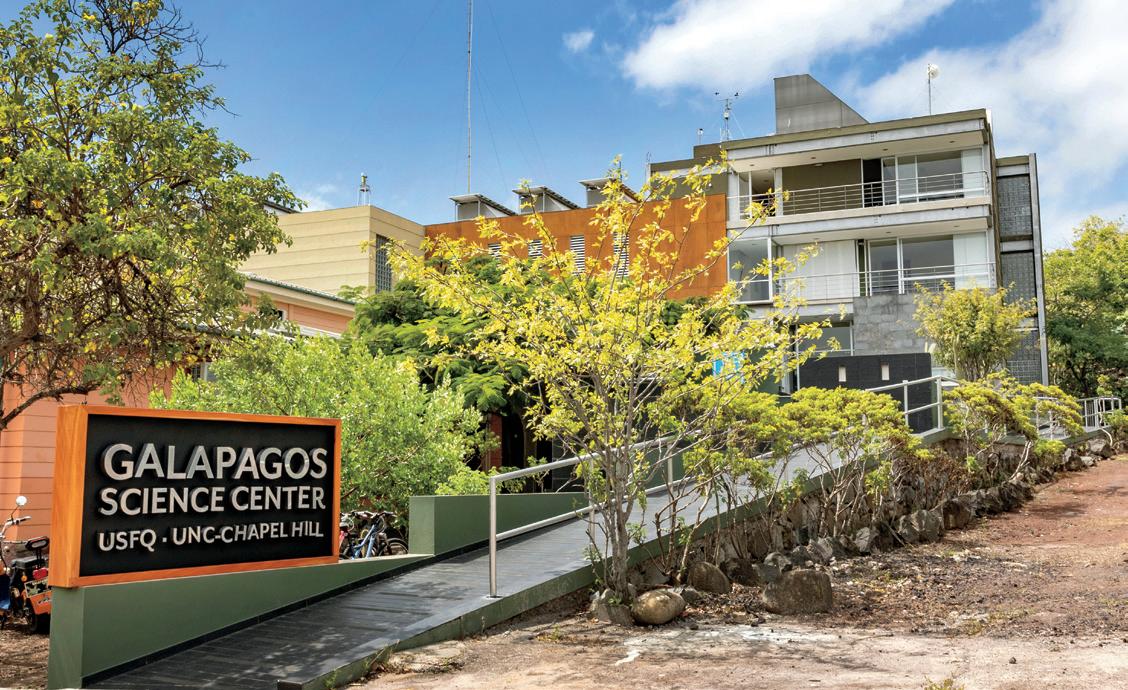
A partnership between Carolina and the Universidad San Francisco de Quito in Ecuador, the Galapagos Science Center is home to research on terrestrial ecology; marine ecology and oceanography; microbiology and genetics; and geospatial technologies — which can all be applied to similar islands around the world.

Since opening in 2011, the Galapagos Science Center has been the site of more than 100 interdisciplinary research projects led by hundreds of international scientists. Meet some of the Carolina researchers who are conducting their research more than 2,600 miles from Chapel Hill.

marine ecologist and professor in the biology department in the College of Arts and Sciences
The research in Bruno’s lab is focused on the biodiversity of the ocean, particularly the impacts climate change has on marine species and ecosystems. Bruno and his team study how human activities like fishing and energy production from fossil fuels alter the structure and functioning of marine food webs and what local conservation strategies are effective in mitigating these impacts.

“Once I got here, I realized there’s remarkably little known about most of the species that inhabit this unique system. There’s so much work to be done here, but that means endless opportunities for really impactful student research. It’s a perfect classroom for the undergraduate and graduate students that work with me to learn about natural systems, field methods and the challenges of doing field science.”
Right: Bruno holds a Galapagos brittle star — an “echinoderm” that is related to sea urchins and sea stars.
marine ecology PhD student in the biology department in the College of Arts and Sciences
Silva-Romero is studying how macroalgal availability in the Galapagos’ rocky reefs is impacted by temperature, grazing herbivores and rising seawater. Her work examines how algal biomasses — the base of the marine food web — respond to environmental changes, addressing a knowledge gap about ecological processes such as top-down and bottomup controls of this unique ecosystem.
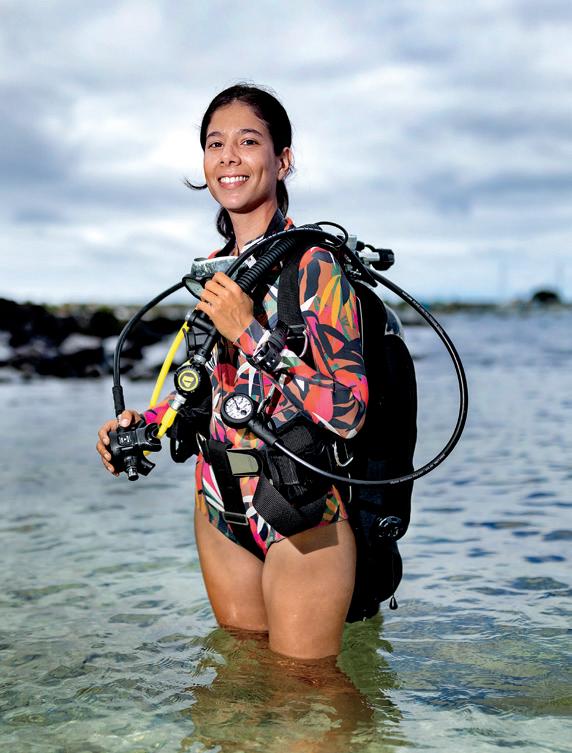
“The Galapagos Islands are important for this research because its marine ecosystems are complex, unique, enormously dynamic and certainly influenced by [human activity]. Using this place as a study model can help us understand how species interactions and ocean productivity will be directly and indirectly affected in the near future.”
Right: Silva-Romero holds wet macroalgae from the Ulva genus that is ready to be dried. With this process, she can calculate algal biomass in the sample.

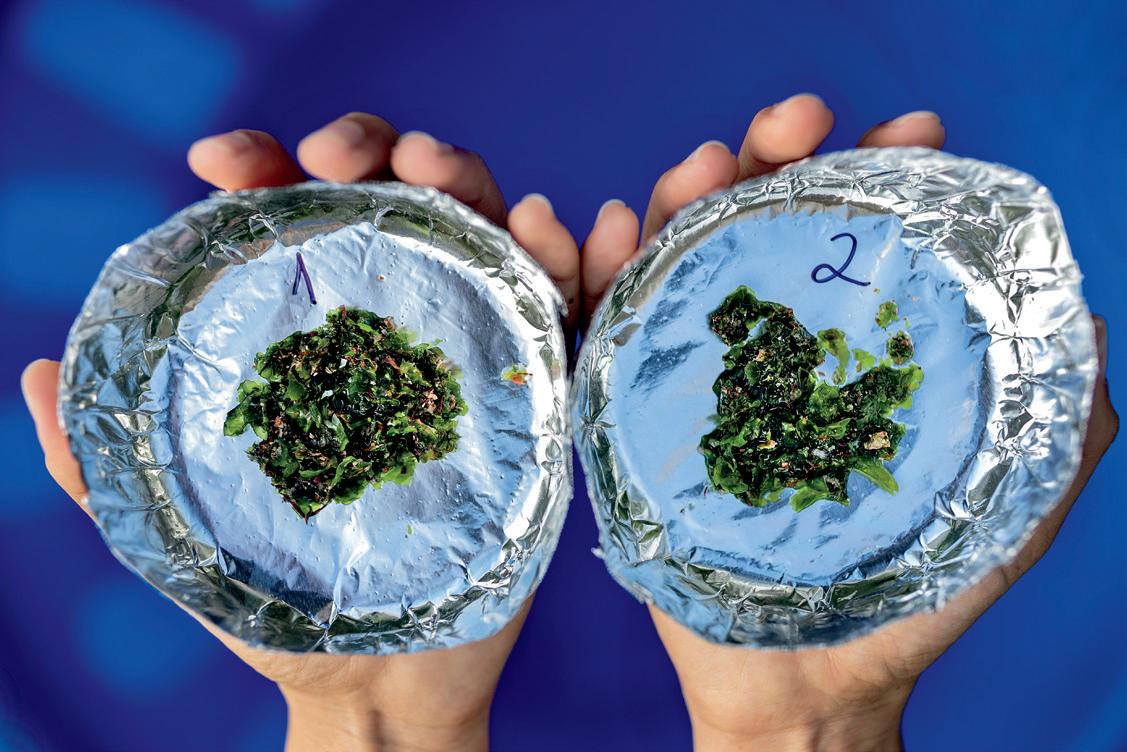

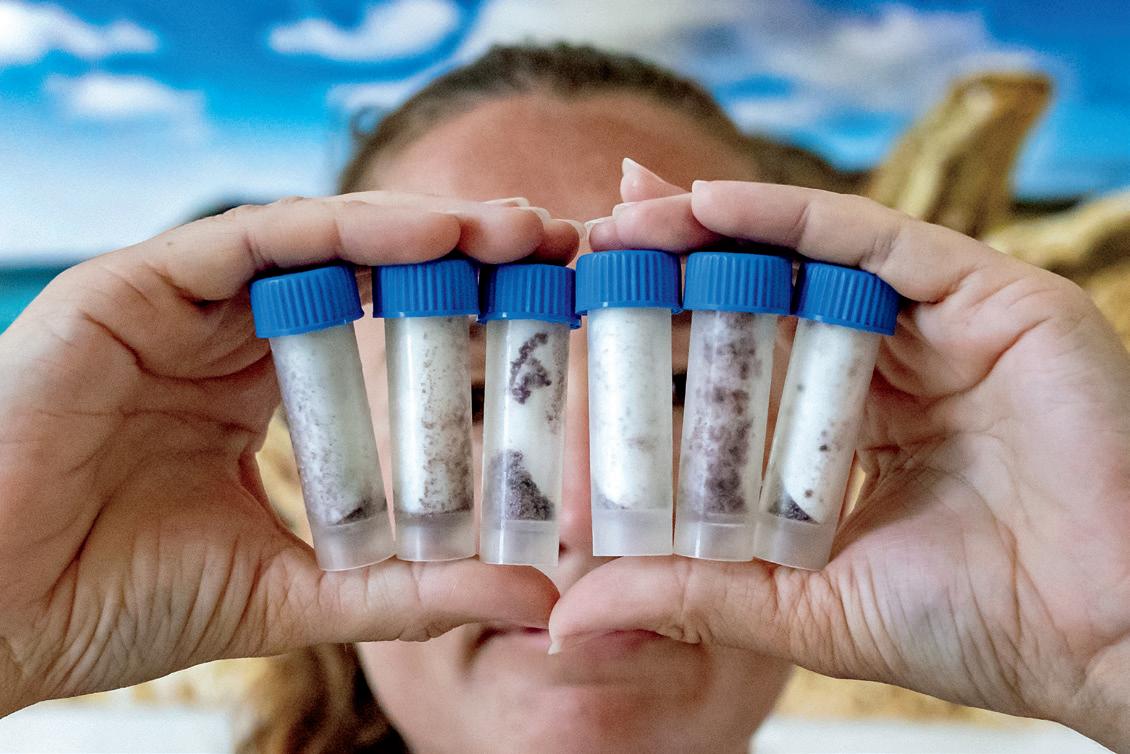
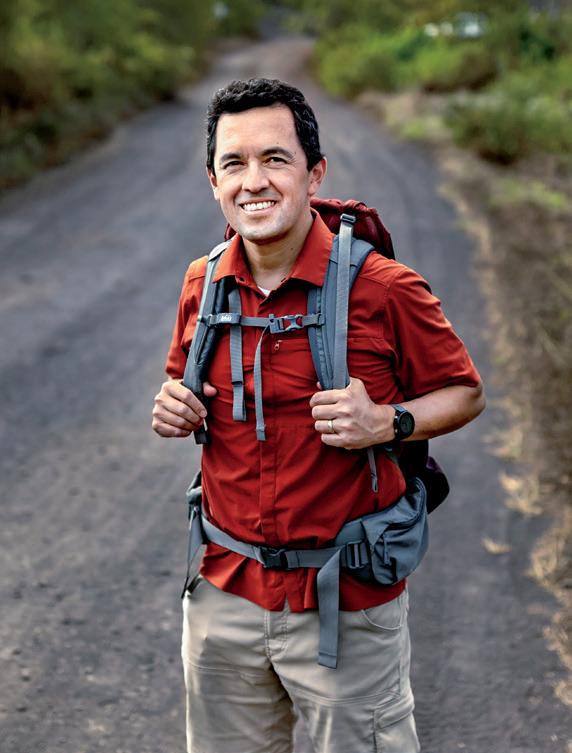
interim co-director of the UNC Center for Galapagos Studies and Bowman and Gordon Gray Professor in the geography department in the College of Arts and Sciences
Riveros-Iregui researches the interactions and feedbacks between water and ecosystems, including soils, plants, microbes and the atmosphere, with a focus on elements such as carbon and nitrogen.
“The Galapagos Islands offer a variety of environments as a result of sharp gradients in age, hydroclimate and human impacts. This includes very dry and very humid areas with drastically different vegetative covers that may occur very closely to one another. My group and I study this natural laboratory to evaluate current threats to freshwater security and resource sustainability, as well as the coupling of human activities with ecosystem dynamics and function.”
Left: Riveros-Iregui holds rock samples while on the Galapagos Islands.

PhD student in the College of Arts and Sciences’ Environment, Ecology and Energy Program
Ryburn is creating a comprehensive assessment of the ecology and habitat of juvenile scalloped hammerhead sharks in the Galapagos. Little is known about this species of shark at the juvenile stage, including how long they reside in the nursery habitats, movement among nurseries, diet and why certain bays are chosen as nurseries.
“The Galapagos are very important for my research because recently, a few scalloped hammerhead nursery grounds have been discovered throughout the archipelago. This species is iconic to the islands because they are known to school there in large numbers as adults. If we can increase their chance of survival as juveniles, we can hopefully aid in the recovery of their overall population.”
Left: Ryburn holds tubes that contain water filter papers that are used for extracting DNA samples from the water to study the habitat of juvenile scalloped hammerhead sharks.
WILL VIZUETE
professor in the UNC Gillings School of Global Public Health’s environmental sciences and engineering department
A leading cause of global premature deaths is exposure to ozone and aerosols. Aerosols alone are responsible for up to 8 million premature deaths worldwide and play a critical role in our understanding of the impacts of climate change. Tackling problems of premature deaths because of air pollution and climate change are the global public health issues that motivate Vizuete’s research.
“The Galapagos provides both a pristine natural location and a state-of-the-art science facility found at the Galapagos Science Center. The center fosters interdisciplinary teams where I can work with experts from both the oceanic and atmospheric sciences and generate new discoveries on how the oceans form aerosols.”
Below: Vizuete holds an instrument he uses to collect aerosols from the atmosphere in the Galapagos.

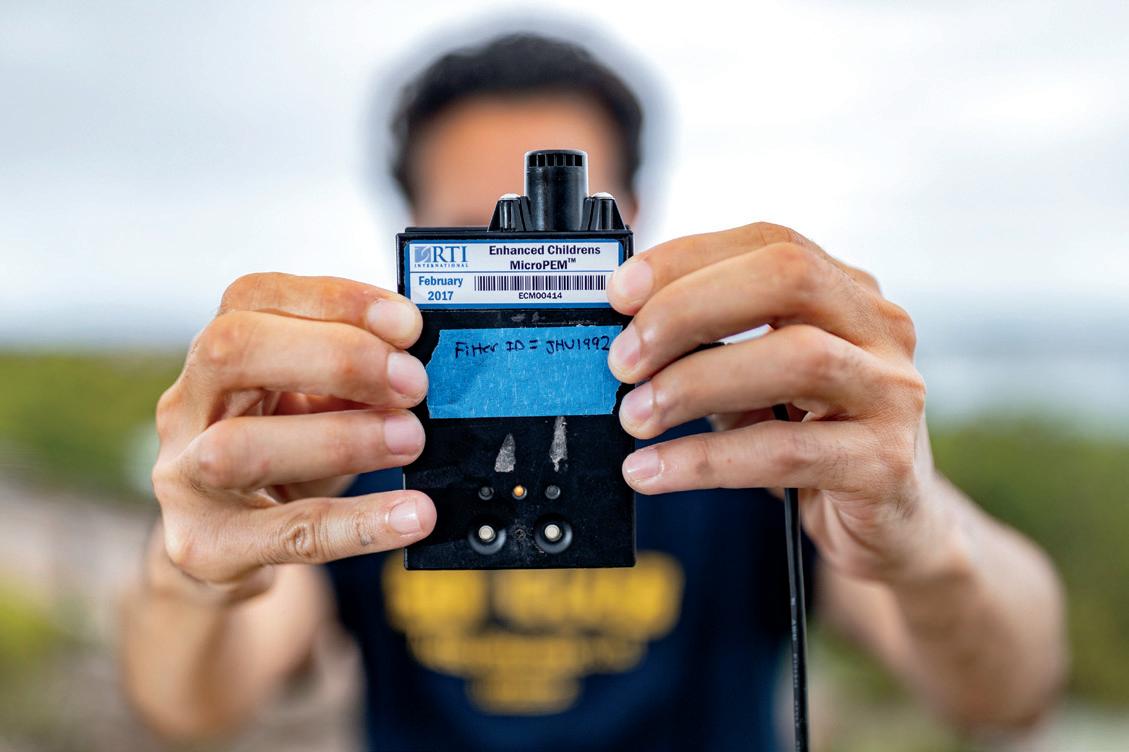
At the Ackerman Center for Excellence in Sustainability, UNC Kenan-Flagler Business School students tackle a curriculum that presents prosperity and corporate responsibility as intertwined objectives. The center provides education, research, outreach and best practices to accelerate progress in social and environmental sustainability using profitable business solutions.
For Olga Hawn, associate professor and director of the center, sustainability has never been an abstract idea. She grew up in Russia, and her parents grew fruits and vegetables, recycled and reused everything they could out of necessity. That need became a way of life, with their commitment to using resources efficiently deeply ingrained in Hawn.
She became engaged in efforts to help the planet after she studied in Denmark, where she learned about corporate social responsibility and realized it could help Russia by boosting the economy and improving life for its people.
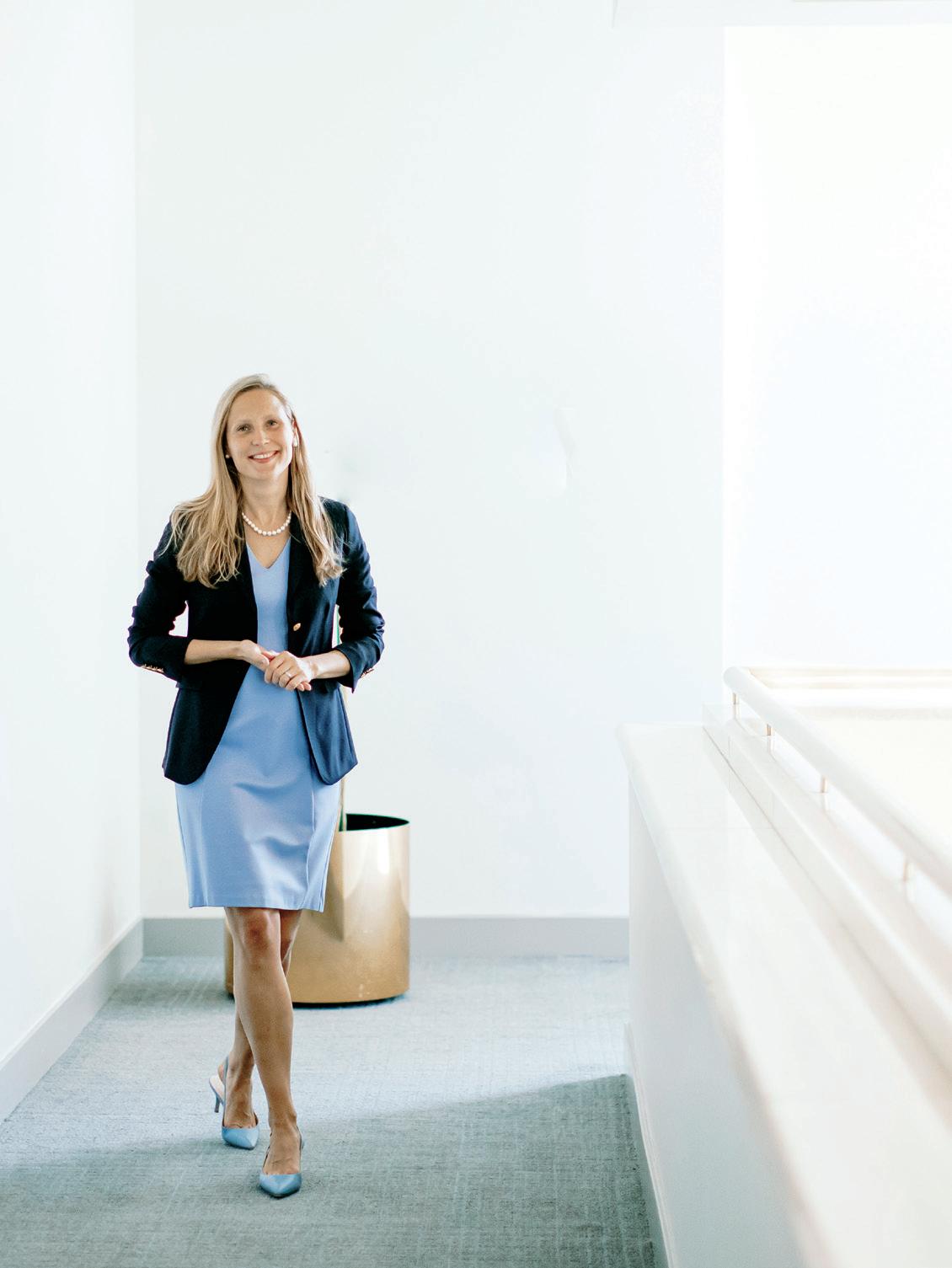
Hawn wants students to see under what circumstances it pays off for a company to be socially responsible and how to build these ideas into organizational culture. Her research shows that companies making sustainability promises must follow closely with their actions, or otherwise their market value suffers. Hawn emphasizes these points when mentoring students and counseling them on pursuing careers with impact. She teaches about the mental barriers that CEOs face regarding sustainability and how those can be overcome.
“I view our profession as one of the very few where we can change the world every day — in the classroom,” she said. “There is nothing more important than to be here for students, and to prepare the future leaders of our world with more ethical ways of thinking about and doing business.”
Back in his hometown of Wilson, North Carolina, Dante Pittman ’18 is giving back to the state in two ways: as an officer in the North Carolina National Guard and as human relations director for the City of Wilson.
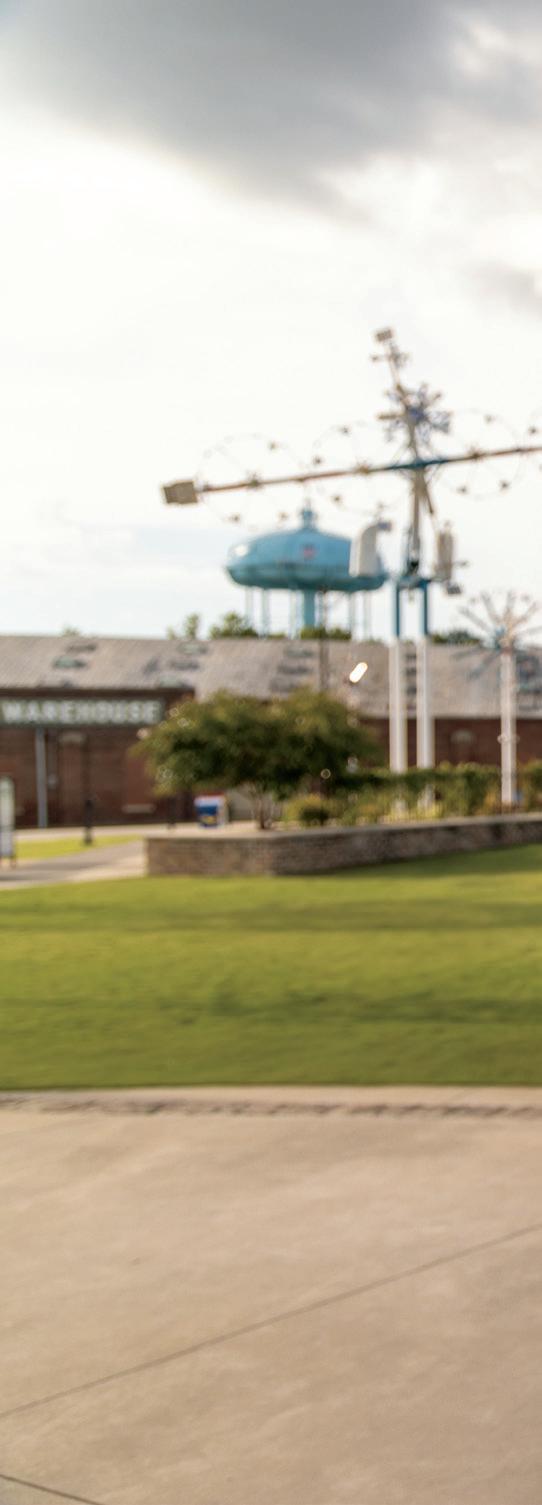
Pittman was a member of the first cohort of Lead for North Carolina (LFNC) Fellows. The UNC School of Government program recruits, trains and places the state’s most promising young leaders in paid local government fellowships to cultivate a new generation of public service leaders. LFNC Fellows have secured more than $67 million in grant funding to advance key initiatives in the communities where they work throughout the state.
“Our generation wants to have a tremendous impact in our communities,” Pittman told CBS This Morning in 2021, when it featured Lead for America, the national version of the North Carolina program. “In my opinion, the best way to do that is to go back where you started.”
Growing up in Wilson, Pittman always knew he wanted to go to Carolina. Once on campus, he followed his interests in law, government and politics, soaking up as much as he could. “Carolina provided me an opportunity to study and learn about government at the state and local level; I have been captivated by it ever since,” he said. “There is just something special about being so close to the work that has the most direct impact.”
After graduation, Pittman became an aide to the North Carolina attorney general. He was working there when he heard of the LFNC program. “LFNC provided a unique opportunity,” he said. “The opportunity to return home to work in local government was the only one that I would have taken. Getting the opportunity to go home and work to make things better is something that I have always been interested in. The thing about local government is that most of the positions do not get a lot of exposure to students, high school or college. What makes LFNC such a critical organization is that it shows students opportunities where they can be change-makers in their communities.”
The City of Wilson hired Pittman after he completed his fellowship. His position as human relations director
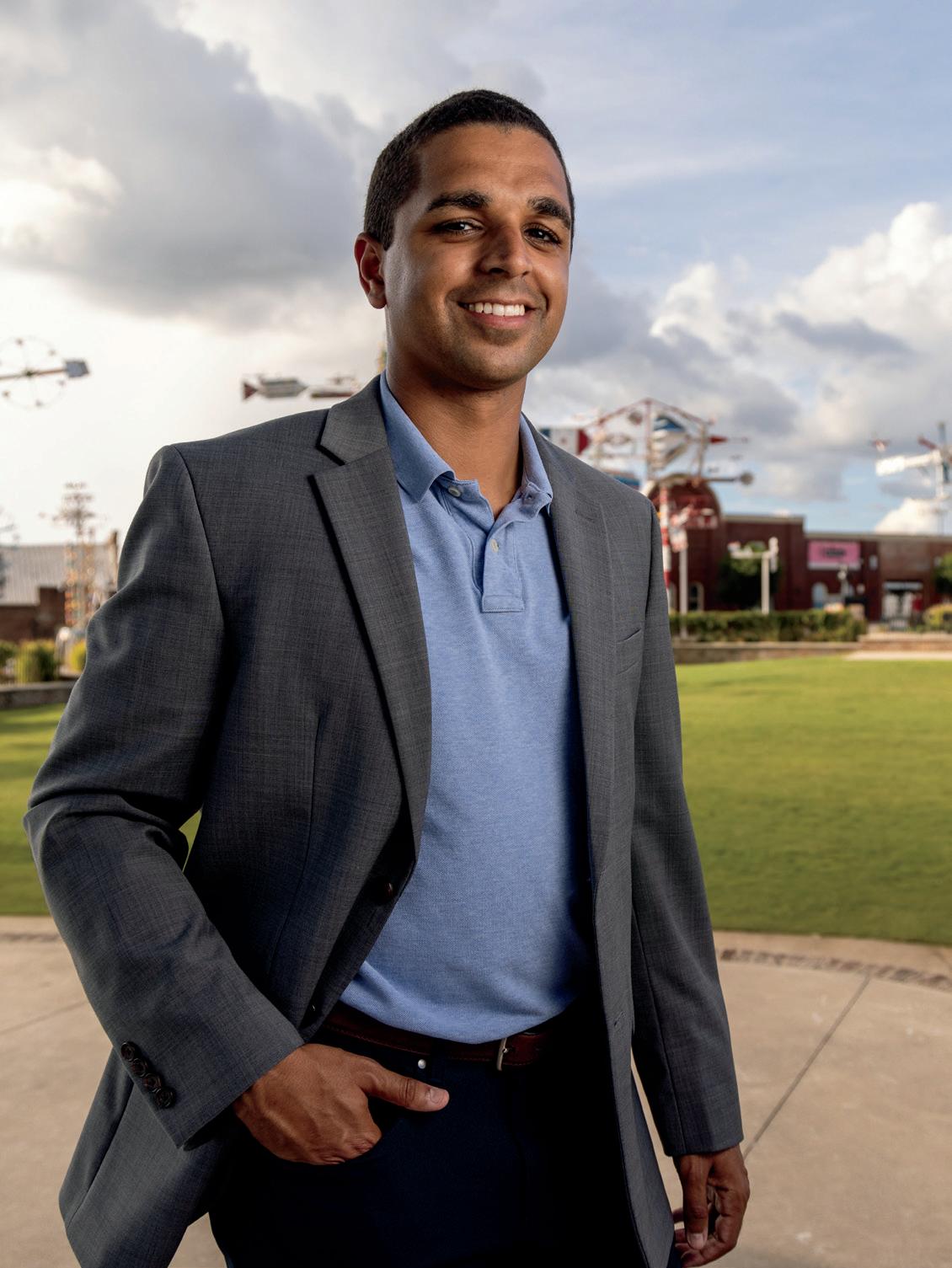
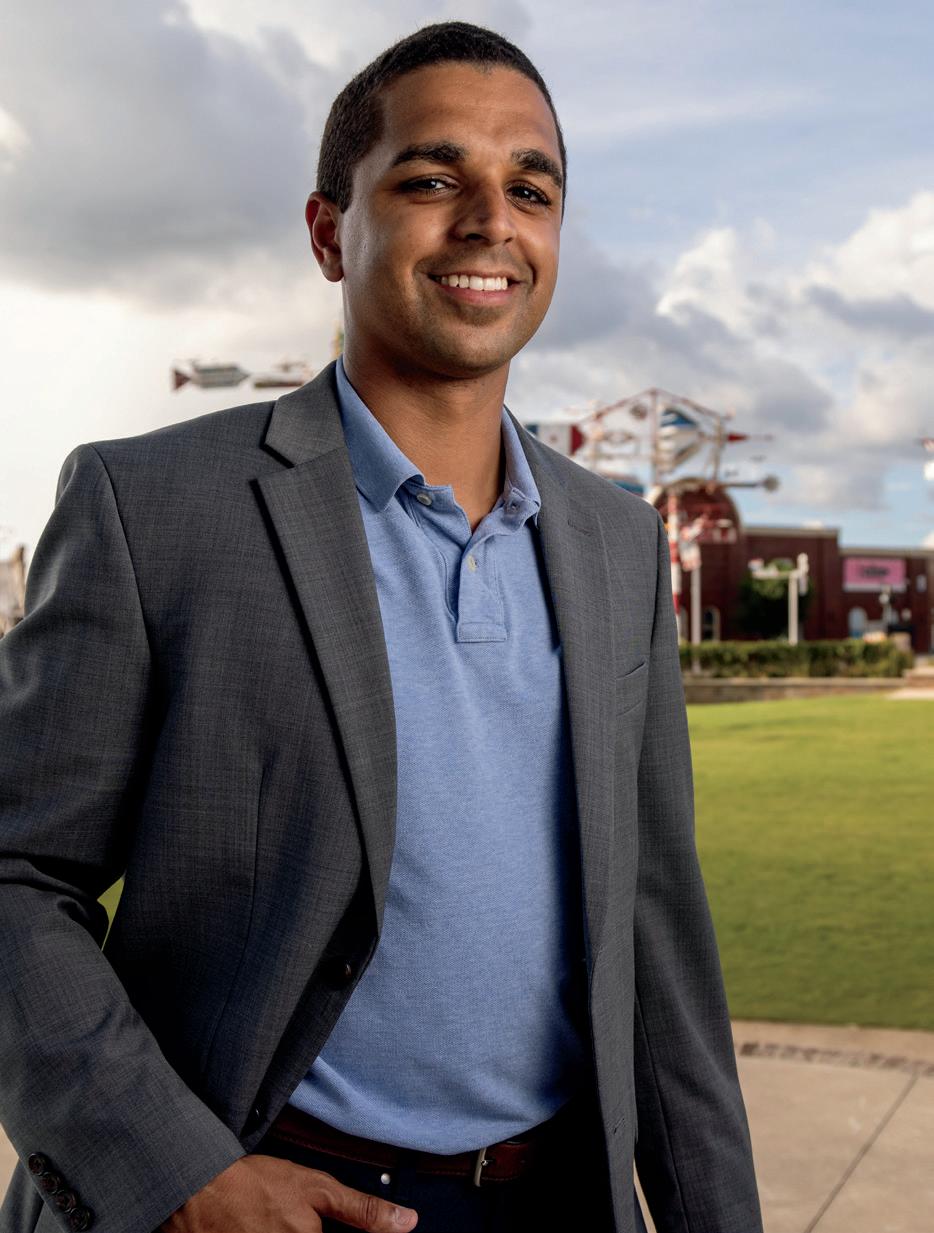
requires attention to details, such as compliance with the Americans with Disabilities Act, as well as diplomacy, such as bringing various groups in Wilson together. “Every day is different,” he told the Wilson Education Partnership in an interview.


On one late summer day in 2022, his schedule included final preparations for National Night Out; attending a meeting of the Board of Social Services of Wilson County (he is vice chair) to connect the city with the county’s efforts to combat predatory housing; planning for a meeting of the Wilson Police Department’s SummerFest, a community building event; and supervising a new LFNC Fellow.
Amid all that, Pittman said, without question the aspect of his job he enjoys most is serving the community that raised him.
“It’s impactful to be able to serve any community, but when it’s your neighbors, family and friends, and you get to serve them and they’re able to cheer you on the whole way, that’s just special,” he said.
By Claire Cusick ’21 (MA)“It’s impactful to be able to serve any community, but when it’s your neighbors, family and friends, and you get to serve them and they’re able to cheer you on the whole way, that’s just special.”
— DANTE PITTMAN
The City of Kannapolis, North Carolina, is now booming thanks, in part, to a collaboration with a UNC School of Government program.

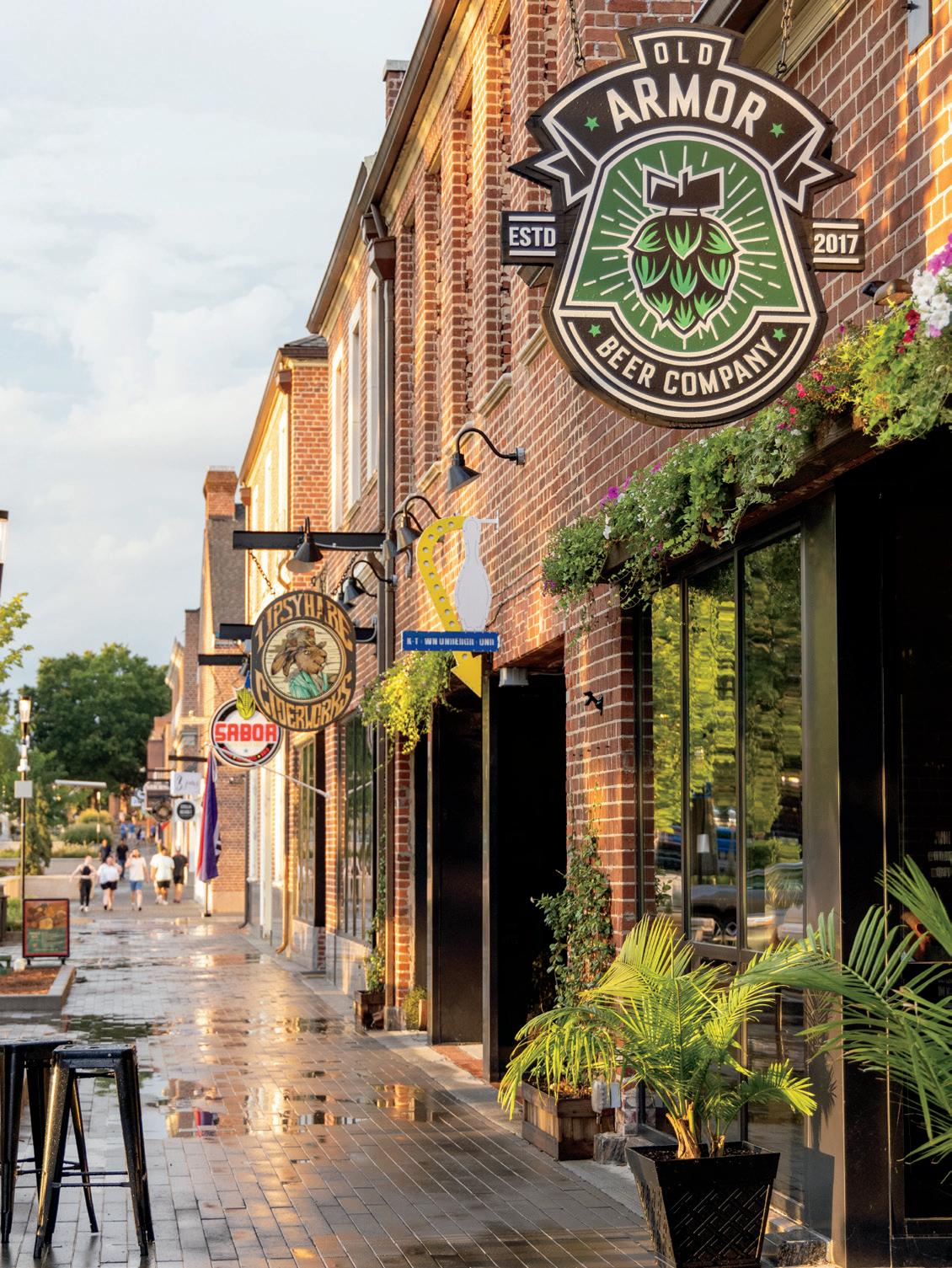
When the City of Kannapolis sought to revitalize its downtown, city leaders turned to experts at the UNC School of Government. The school’s Development Finance Initiative (DFI) team helped the town develop a plan and provided guidance in how to implement it. Today, a new park serves as a gathering space connecting Kannapolis’ many downtown attractions: a new ballpark for the Cannon Ballers, renovated storefronts, new apartments, a 1930s era movie theater, the North Carolina Research Campus — home to the UNC Nutrition Research Institute — and more.
“We have fulfilled dreams for people who worked in the mill for all their lives, who lived in this community and saw the mill disappear, who saw their downtown and everything else disappear,” said Milton Darrell Hinnant ’69, ’70 (MAT), mayor of Kannapolis, North Carolina. “This was for them, and they’re thrilled to death. I have citizens walk up to me all the time and say, ‘I can’t believe you all have been able to do this.’ That’s the sweetest thing about this whole thing. We are serving our community, and they are loving it.”
Mayor Hinnant and Irene Sacks, director of economic and community development for the City of Kannapolis, attend a Cannon Ballers baseball game.Veteran Matthew Colón participated in equine therapy with Peace Reins at ClearWind Farm as part of the multi-week outpatient phase of the THRIVE Program.
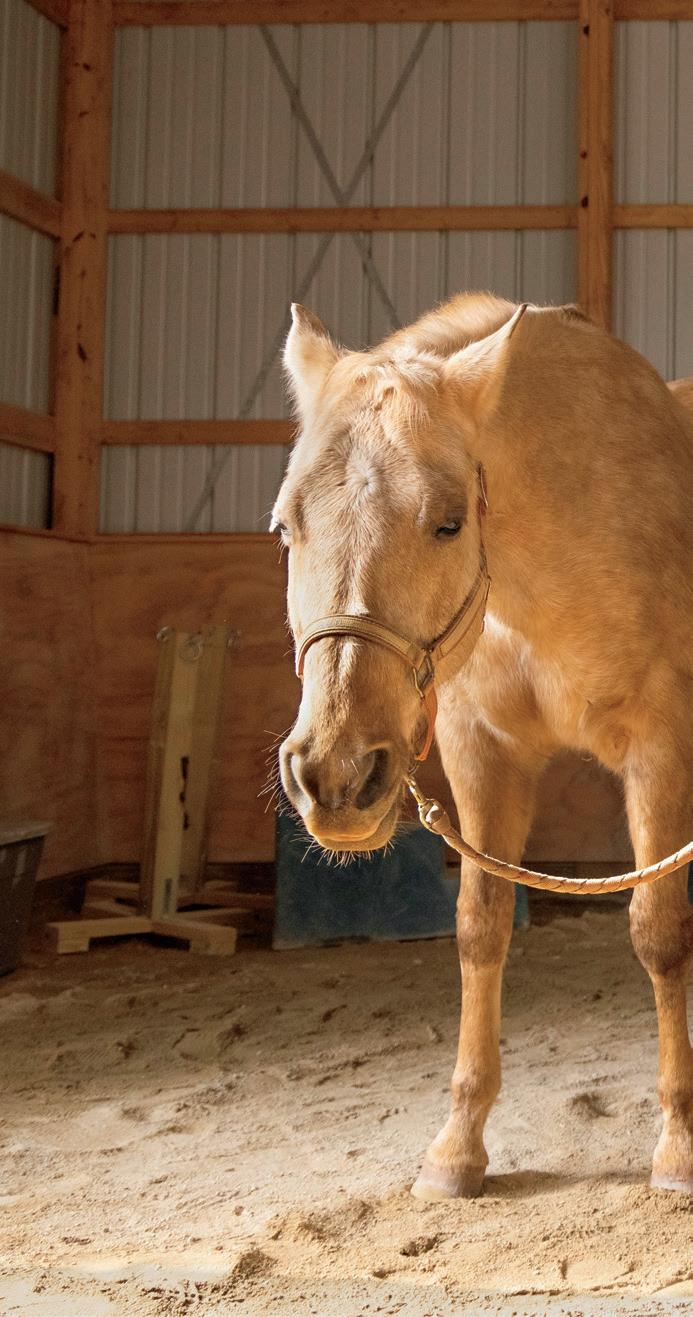


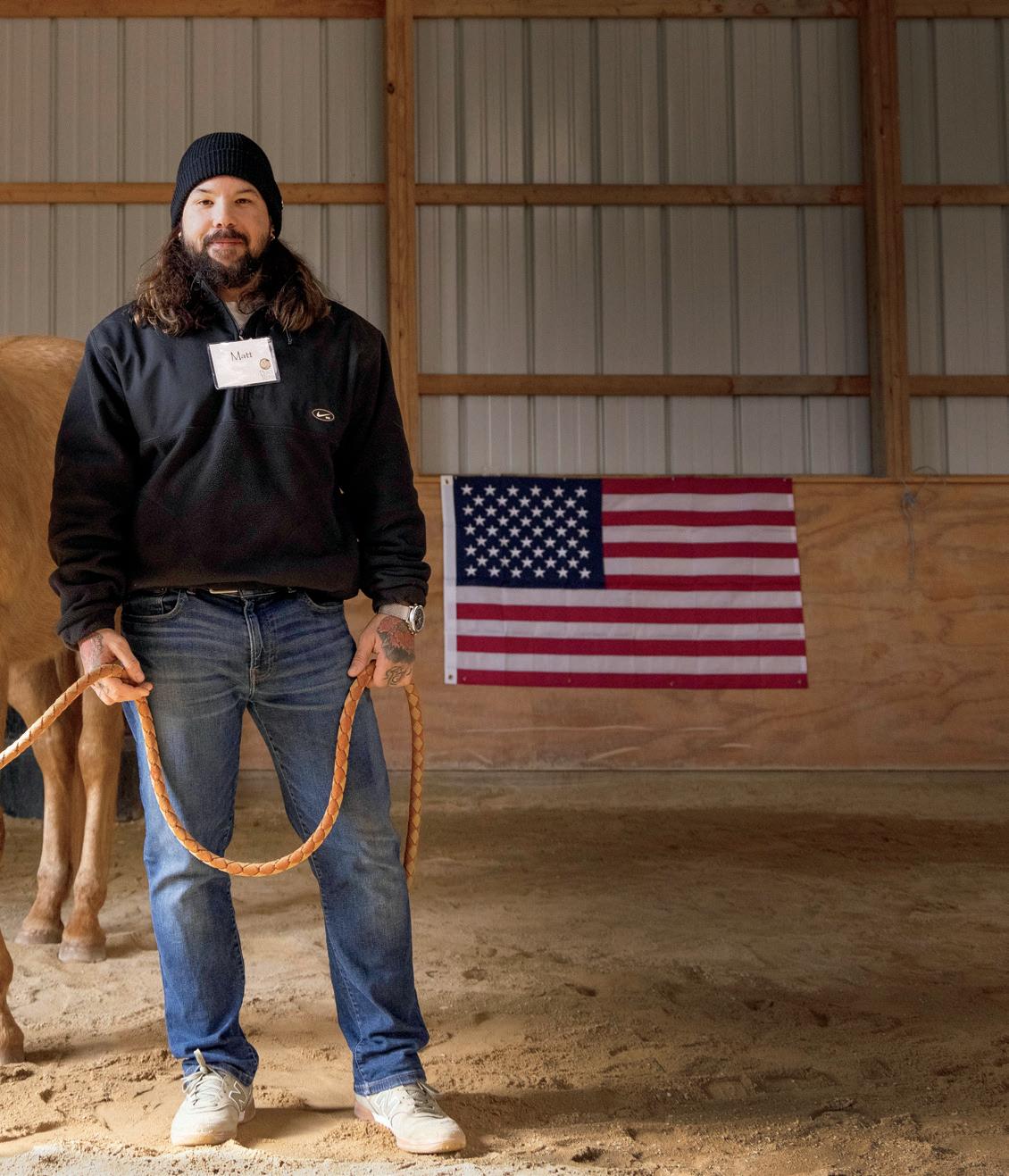
An empowering clinical outreach program at UNC-Chapel Hill offers veterans and first responders new hope through holistic health care.
by Anna Katherine ClemmonsPhotos by Jeyhoun Allebaugh and Jafar Fallahi
Illustrations by Chris Williams
“There’s this narrative that veterans have traumatic brain injury and they’re all screwed up, depressed, alcoholics, and even suicidal,” said Justin Ball, a 23-year veteran of the military Special Operations community. “And this narrative builds.”
Ball spent several years as a U.S. Special Operations Forces medic, where he was able to utilize some of the top medical services available throughout the Department of Defense. He embarked on many missions throughout his active duty, and while he didn’t sustain any life-threatening injuries, Ball said his body endured a lot of wear and tear — including multiple concussions.
When he officially retired from the military in 2021, Ball struggled. Part of his challenge was adjusting to the change of pace. But another major aspect was not knowing whether he had suffered undiagnosed injury or needed medical treatment, physically and mentally. He had been around explosions for years. He had

experienced headaches, sinus pressure and jaw pain. He wondered, did that impact his brain? Did he have a traumatic brain injury (TBI)? “You have all these unknowns,” he said.
He no longer had access to the top-notch medical care he’d been a part of and worked with in the military. Which is why, when he learned about the THRIVE Program, “there couldn’t have been better news,” Ball said.
The THRIVE (Transforming Health and Resilience in Veterans) Program was established at UNC-Chapel Hill as a community-based clinical outreach program to offer veterans and first responders holistic health care, particularly those who are experiencing the effects of post-traumatic stress disorder, traumatic brain injury and musculoskeletal related conditions.
Founded in June 2021 inside the Matthew Gfeller Center in the UNC College of Arts and Sciences and funded by a $12.5 million gift from the Avalon Action Alliance, the collaborative program is the brainchild of two Carolina researchers: Jason Mihalik and Shawn Kane. The duo began working together in 2010, when Chancellor Kevin Guskiewicz (then a professor in exercise and sport science) founded the Matthew Gfeller Center as a leading epicenter for traumatic brain injury research. Kane was an active-duty Special Operations Forces soldier and physician at the time, and he and Mihalik were researching active-duty service members and TBI-related case studies through the center. When Kane retired from the U.S. Army in 2018 and joined the UNC Department of Family Medicine, he and Mihalik wanted to expand their work to help veterans as well.
“The idea of setting up a veteran-related program was always part of the plan,” Kane, the THRIVE Program’s chief medical officer and primary care physician, said. “We knew we wanted to do something with veterans’ health, to study the impacts of TBIs over their careers and just overall veteran health.”
After several months of working to secure location space and program planning, the first THRIVE Program participant arrived in April 2022. As of March 2023, the program had seen close to 60 participants, ranging in age from 24 to early 70s, and primarily men, though several women have participated — a number the program coordinators hope to increase.
Each THRIVE Program participant completes an application before arriving and takes part in a twoand-a-half-day evaluation. All participants are treated regardless of insurance coverage or ability to pay. Currently, the THRIVE Program team sees an average of two new participants each week but is only limited by its physical space.
A holistic, interdisciplinary, collaborative approach is used, meaning the participant sees upwards of 12 providers from the following specialties: psychiatry, speech-language pathology, neuropsychology, clinical pharmacy, nutrition, physical medicine and rehabilitation, vestibular physical therapy, clinical psychology, athletic training, and family and sports medicine.
The THRIVE Program visit begins with “the fishbowl,” where the entire medical team and staff members sit with the veteran as he or she shares their entire story. The session, Mihalik said, while sometimes intimidating for the veteran, is empowering — both for the veteran to be fully heard and for the clinicians to better understand what success means to the individual.
For some, success means complete recovery. But for other participants, the goal is different. “We may have someone come in and say, ‘My goal is to have lunch at my kid’s school and not feel like I have to sit with my back against the wall,’” Mihalik said.
After the fishbowl, the program participant meets with each clinician individually for evaluation, for at least one hour. The culmination of the two-and-a-half-day visit is a comprehensive, detailed report of next steps and recommendations, which THRIVE Program case manager Sarah Marshburn, a social work practitioner, helps coordinate with the veteran’s individual medical providers in his or her hometown to allow for a continuum of care. “We are meant to be a support service, not a replacement for their long-term care,” Marshburn said. “They look at the recommendations as a roadmap.”
Jason Mihalik, THRIVE Program CEO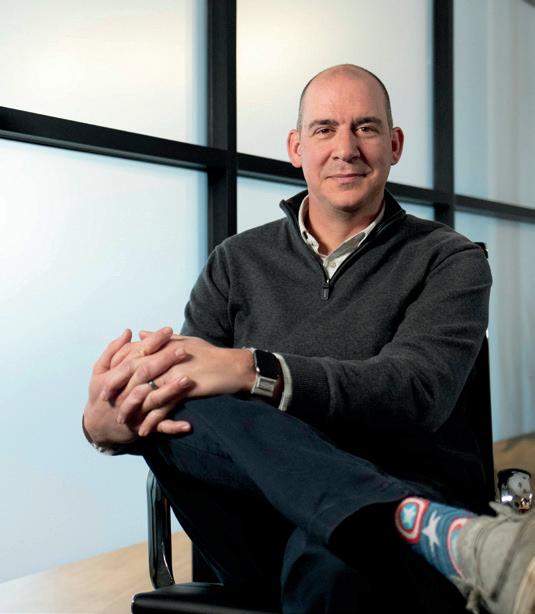
“We look at it more as the whole body,” Dr. Kane, who served as a physician in the U.S. Army for 27 years, said. “If you’ve had a TBI or a concussion or PTSD, and if you have bad back, hip, neck pain, then that’s probably going to impact your brain. So we want to help from an overall brain health standpoint: nutrition, exercise, looking at it from a whole person standpoint.

“If we just fix your brain, but you still have a bad back, you still won’t be happy and not optimized and you won’t be able to thrive. That’s our whole goal — to help the veterans and first responders get back to the maximum quality of life possible.”
After completing the program’s first phase, select participants may opt to attend a more intensive multi-week outpatient program. This second phase combines group therapy with individualized care based on the veterans and first responders’ needs.
Master Sergeant (retired) Sam Rodriguez, the THRIVE Program’s veteran outreach and program coordinator, is a U.S. Special Forces veteran who served in the military for 29 years. He is with the participants in the clinic Tuesday through Thursday and spends Mondays and Fridays on outreach, whether emailing, calling or meeting inperson with potential participants located within North Carolina.
Those veterans, Rodriguez said, often have a simple reason for expressing interest. “They just want to be themselves again. They don’t know why what’s happening to them is happening. So the biggest thing we can do is provide answers.”


“This program calms a lot of those questions that haunt every veteran,” Ball echoed.
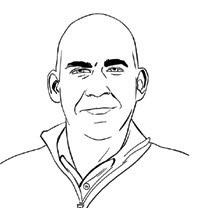
Thirty-nine-year-old Matthew Colón medically retired from the military in 2014 after 12 years of service. Initially, while trying to manage his traumatic brain injury symptoms, Colón was sent to a TBI clinic,
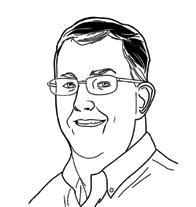 Jason Mihalik, PhD, professor of exercise and sport science, director of the Matthew Gfeller Center, UNC College of Arts and Sciences; chief executive officer at the THRIVE Program
Shawn Kane, MD, associate professor, Department of Family Medicine, UNC School of Medicine; chief medical officer at the THRIVE Program
Kevin M. Guskiewicz, PhD, chancellor of UNC-Chapel Hill; founding director of the Matthew Gfeller Center
Sarah Marshburn, MSW, LCSWA, social work practitioner and case manager at the THRIVE Program
Jason Mihalik, PhD, professor of exercise and sport science, director of the Matthew Gfeller Center, UNC College of Arts and Sciences; chief executive officer at the THRIVE Program
Shawn Kane, MD, associate professor, Department of Family Medicine, UNC School of Medicine; chief medical officer at the THRIVE Program
Kevin M. Guskiewicz, PhD, chancellor of UNC-Chapel Hill; founding director of the Matthew Gfeller Center
Sarah Marshburn, MSW, LCSWA, social work practitioner and case manager at the THRIVE Program
where he received medication to combat his migraines and other symptoms. Still, he said, it was difficult to try and manage multiple diagnoses. “Do I have TBI today or PTSD, or anger management?” Colón said. “What am I trying to tackle? It gets very confusing.”
His first day at the THRIVE Program was intense. He had a splitting headache and was exhausted. But as the meetings continued into day two, the holistic, all-encompassing approach felt like a “discovery,” he shared. During one session with a physical therapist, the therapist moved Colón through a simple neck exercise. That physical release, he said, led to a mental release as well. Each appointment built on the previous one, with clinicians that Colón described as loving, motivated and collaborative. By the time he left, he said “it felt like, ‘we are going to tackle this together, we won’t just send you to a bunch of appointments and hope it works.’”
Now back home in Burlington, North Carolina, his health doesn’t feel as overwhelming. “It’s not like I’m trying to put the pieces of the puzzle together alone. I have so much assistance through this program, and it feels like they are shuffling the pieces right along with me.”
The THRIVE Program also accomplishes this through the gift of time. In today’s health care environment, doctors typically do not have more than 30 minutes to see a patient. Often, an appointment is capped at 15 minutes, whether at the VA or through a primary care provider. As such, Ball said, that often means deciding on two of your 10 worrying symptoms to discuss with a physician on a particular visit. That can be frustrating not only to the patient, but to the physician as well.

Ball came to the THRIVE Program in July 2022. “It was the first time I could go through a program where I didn’t feel rushed or triaged,” he said. Sitting down with the experts in the room for the introductory fishbowl storytelling session, he thought to himself, “This is like a $20,000 appointment. All these experts, listening to me.” He said the gratitude of that was overwhelming.
Since returning home, Ball has started meditating, a practice he tried, unsuccessfully, to adopt for
Veteran George Bell said that at the THRIVE Program, he could finally ask the questions he’d had for a long time but often felt too rushed at the VA to explore. His THRIVE Program visit helped him understand how to work through tougher mental situations while also teaching him how to be more organized and efficient. Best of all, his experience in the program didn’t end once he was back at home in Fayetteville, North Carolina. His VA has utilized the THRIVE Program report in everything from scheduling speech pathology appointments to chiropractor visits.
“The program just gives you more knowledge and education on why I feel this way, why this hurts here,” said Bell, who served in the Army for 20-plus years. “I got it all laid out in a report, so I can reference it if I have an issue.”
more than seven years. He’d utilized apps, retreats and various programs, but nothing had worked. With the clinicians at the THRIVE Program, “The light bulb finally came on,” Ball said.
He also returned home with a new confidence in his own health. He felt assured that he didn’t have significant TBI and that his diet, nutrition and overall wellness approach were on track. He works as a clinical social worker and has sent several of his clients to the THRIVE Program.
The THRIVE Program staff and clinicians feel the magnitude of those success stories, as well. When asked what it has meant to him to work with this program, Rodriguez paused, overcome with emotion. “It’s everything.” He recalled a conversation with the spouse of a veteran who had died from a brain injury. She talked about how her husband had brought a piece of the war home with him that he couldn’t get rid of.
“What does a soldier, a service member, a first responder do?” Rodriguez asked. “They learn to fight back and pick up whatever weapon they can find, whether that is alcohol, prescription drugs or different things that aren’t healthy for them. They have to find a way of getting through that — and one way is through our program.”
In talking to other THRIVE Program participants, Ball said several confessed that the program sounded too good to be true. They were skeptical and reticent upon arriving. But after returning home, treatment plan and coordination in-hand, they were rejuvenated and hopeful.

“I love how the team up there doesn’t care how many years you did, or whether you were a Green Beret,” Ball said. “They are just there to help people.”
Hear from veterans and first responders who have completed the multi-week outpatient phase of the program.
Members of the THRIVE Program team meet with veteran Matthew Colón.Researchers at Carolina have been working to improve the prevention, management and rehabilitation of sport- and military-related traumatic brain injuries for decades. The THRIVE Program builds on the University’s expertise in research, education and clinical practice to fill a critical gap in clinical service for veterans in and around North Carolina.
The UNC-Chapel Hill concussion program begins.
UNC sports medicine researchers create the Balance Error Scoring System to assist clinicians in making return to play decisions following mild head injuries.
The Center for the Study of Retired Athletes is founded at UNC-Chapel Hill.
UNC researchers begin studying head impact biomechanics in college football players.
The Matthew Gfeller Center opens.
Data from UNC researchers inform an NFL kickoff rule change.
Kevin Guskiewicz is named a MacArthur “Genius Grant” Fellow for his concussion research.
Jason Mihalik launches the Concussion Recognition and Response smartphone app.
The Matthew Gfeller Center partners with United States Army Special Operations Command. Guskiewicz is named a Time Magazine “Game Changer.”
UNC partners with the Atlanta Falcons to begin the first NFL head impact biomechanics study.
UNC’s Brain & Body retired NFL athlete program begins.
The NFL funds a $2.6 million grant to conduct the first multinational randomized clinical trial for “Active Rehab” concussion treatment.
UNC’s Milestone Wellness program for retired NFL athletes begins.
The Department of Defense funds a $3.1 million grant to implement “Active Rehab” in military treatment facilities.
The Matthew Gfeller Center eclipses $20 million in extramural grants.
The Matthew Gfeller Center establishes the THRIVE Program through a $12.5 million gift from the Avalon Action Alliance.
U.S. Congress grants $4 million for researchers to continue studying the neurological health of active duty warfighters.
Students at the UNC School of Law’s Military Veterans Law Clinic help veterans fight for upgrades or corrections in military discharges to make life-saving resources available to former service members. For one North Carolina veteran, they restored all the honors he was owed — including his Purple Heart.

John Spencer was working the graveyard shift at the Quality Mills textile plant in Mount Airy, North Carolina, when his draft number came up.
After training at Fort Bragg and Fort Knox, the 20year-old was sent to South Vietnam in 1969, where he served for one year and 16 days as an Army armored reconnaissance specialist in the infantry. During that deployment, he was hit in the neck by shrapnel.
But it wasn’t just the enemy that presented challenges for Spencer abroad. Being a Black man in the Army provided its own struggles, including enduring racism and discrimination from a leader who called him lazy, conniving and much worse, he recalled.
His unit would ultimately unilaterally discharge Spencer with an other-than-honorable discharge for minor infractions. Spencer was told by this unit that the discharge would be upgraded once he was stateside again.
That review never happened.
“When I landed in Washington, the atmosphere and function changed,” he recalled. “I was stripped of my uniform. My dog tags were taken away from me. I was given civilian clothes and sent to the airport and waited for a standby flight. When I had gotten to Washington, I began to feel like I was some kind of criminal.”
He was sent home to North Carolina, disqualified for veterans benefits. He was eligible for the Purple Heart but never received it. He had earned a coveted combat infantryman badge and a Vietnam War Cross that he was never awarded.
Ashamed, he kept the details of his discharge a secret from his friends and family for nearly 50 years. Then, in 2019, Spencer met with Tar Heels from the UNC School of Law’s Military and Veterans Law Clinic and told his story. That group of Carolina Law students at the clinic advocated for Spencer and worked to restore his federal veteran status.
Spencer’s case is just one of dozens that the UNC School of Law’s Military and Veterans Law Clinic has taken on since John Brooker ’03 (JD) became director of the program in 2018.
Supported in part by the William R. Kenan, Jr. Charitable Trust, the program provides pro bono legal support for low-income former service members who are fighting for an upgrade or correction to their military discharge status. Veterans with an other-than-honorable discharge are left without access to benefits and health care, even when health issues stem from their service.
Brooker, a clinical associate professor of law with more than 20 years of active-duty service in the Army, said it wasn’t uncommon for service members to face discrimination and receive other-than-honorable discharges for minor offenses during the Vietnam War.
“We try to get those former service members veteran status,” he said. “That opens the door to life-saving veteran benefits that many should have had all along. But, as important as that, it restores the honor that they felt was taken from them. They were separated with a type of discharge that literally says they don’t have honor.”
Isabelle Stevens ’21 (JD) started working at the clinic following her first year at Carolina Law. One of her first cases was Spencer’s.
“Lawyers — in public interest especially — really help people who would not get that help otherwise because they couldn’t afford it,” said Stevens, who was commissioned as an officer in the Army’s Judge Advocate General’s Corps. “Having the opportunity to help somebody and help right some of the inequities that have occurred in their life was the highlight of my law school career.”
Vietnam War veteran John Spencer on the day he received his Purple Heart at the UNC School of Law in November 2021

Army Brig. Gen. Alison C. Martin ’00 (JD) presents veteran John Spencer with his Purple Heart.
Along the way, she was also getting real experience on everything from researching the law to representing clients.
“We’re training law students to be better lawyers,” Brooker said. “We’re training law students on how to combine theory with practice and then giving them the opportunity to actually practice under the supervision of trained faculty.”
By the time he made his way to Carolina Law’s clinic in his early 70s, Spencer was looking for one thing: the right to a military funeral.
“I wanted to have that flag draped across my casket,” he said.
With that goal, Stevens and three other law students combed through military and health records to create an application more than a thousand pages long that appealed Spencer’s discharge on the grounds
of discrimination and that the discharge was not conducted to protocol. Within those records and meetings with Spencer, the students also learned he had been hit in the neck by shrapnel during the war, making him eligible for the Purple Heart.
In early 2021, the clinic team received the good news that Spencer’s discharge had been upgraded and his honors would be restored. After five decades, he was finally granted full federal veteran status with full health care benefits and received his Purple Heart, combat infantryman badge and a Vietnam Gallantry Cross.

The clinic celebrated those results when Spencer visited the UNC School of Law to have the Purple Heart pinned to his chest by Carolina Law alumna and Army Brig. Gen. Alison C. Martin ’00 (JD).
“We poured our heart and soul into his case,” Stevens said. “I know that him getting these awards is not going to change his life in the way it would have if he got them when he should have, but it represents an inequality
has been fixed. Being able to be part of that was the most inspiring part for me.”
The students, Brooker said, are the ones who made it happen. Seeing budding lawyers fighting for a deserving client is what he considers the greatest reward of the job.
“They’ve learned how to use their talents and education to help their fellow North Carolinians,” he said. “And the folks they are helping have their faith in humanity restored because, often for the first time in decades, somebody has listened to their side of the story, believes in them and fought for them.”
After spending 50 years keeping the details of his discharge quiet, Spencer is proudly displaying his awards in a shadow box his daughter prepared for him. He will also receive his military funeral when the time comes.
“It’s like a burden was lifted,” Spencer said. “I’ve been carrying it around all my life — the idea that this is negative, that this is bad or that I’m not a complete person. It’s a good feeling not to have that there.”
By Brandon Bieltz
As an intern at the Carolina Veterans Resource Center, Ilana Shtivelman ’23 (MSW) is working to understand how to support veterans and military-affiliated populations, particularly through a mental health lens. She is researching a condition called moral injury, a response to engaging in situations that contradict an individual’s values and moral beliefs.
Shtivelman, a recipient of the Vera Tayeh Innovations and Impact Award, is designing, implementing and evaluating her work in collaboration with the UNC School of Social Work’s Social Innovation and Entrepreneurship Lab. She hopes her work will bring more awareness and support to the field of social work as it relates to serving veterans and military affiliated populations.
“This is essential work that often does not get the attention it so desperately needs, resulting in many people being left behind, after giving their all,” Shtivelman said. “I hope to engage in research and practice that can shine more light on this population, the challenges faced and their enduring strength.”
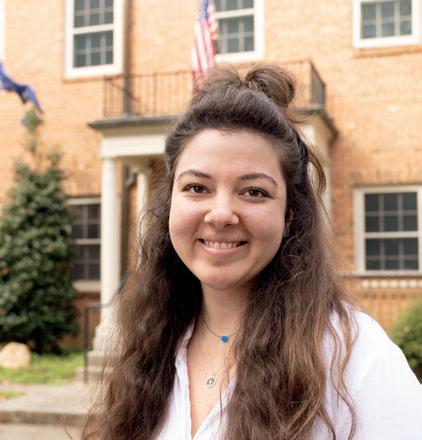
Dr. Samantha Meltzer-Brody is one of the researchers establishing a new program to study what causes anxiety and mood disorders in young people.
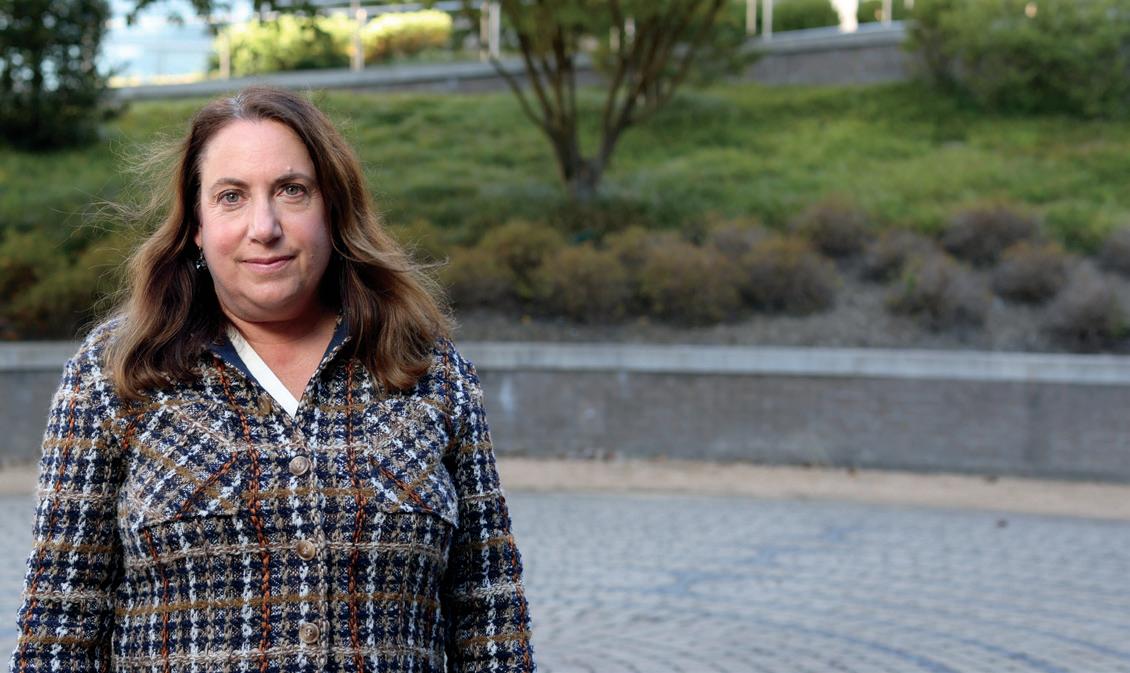
Recent statistics paint a troubling picture of mental health.
• The rates of child and adolescent anxiety and depression have doubled since the start of the pandemic.
• Anxiety and mood disorders are becoming more acute, posing a higher level of distress or severity, for affected children and adolescents.
• Suicide is now the second leading cause of death for 10- to 14-year-olds.
• The challenge is even greater in North Carolina, where 62%, or nearly two out of every three, youth (12-17 year olds) who are diagnosed with depression don’t receive treatment.
The COVID-19 pandemic has shone a spotlight on the mental health challenges facing American children and adolescents. While the rates of anxiety and mood disorders have been high for years, the pandemic magnified the problem, leading to higher numbers of young people in distress, as mental health services have become harder to access.
Carolina’s mental health professionals are passionate about helping at-risk children and adolescents and quickly delivering help that can have the maximum impact.
Researchers from the UNC School of Medicine Department of Psychiatry are establishing the Child and Adolescent Anxiety and Mood Disorders Program (CHAAMP) to study what causes anxiety and mood disorders in young people, and the consequences of these disorders. Their findings will then be used to develop intervention programs that can be implemented in surrounding North Carolina communities.
“The prevalence of anxiety and mood disorders is so high that it’s hard to find a household untouched by the issue,” said Dr. Samantha Meltzer-Brody, the Assad Meymandi Distinguished Professor and chair of the Department of Psychiatry. “Almost everyone has a child, friend or neighbor struggling with an anxiety or mood disorder and caregivers have never been more hungry for support.”
One of the biggest hurdles to a child or adolescent receiving care is lack of access. In many rural North Carolina communities there simply aren’t any mental health professionals. Families in these areas have to drive hours away from home for their child to receive care from a provider outside of their community.
Given the critical shortage of mental health professionals, CHAAMP will evaluate novel, research-backed treatment approaches that leverage all of the important caregivers in a child’s life, including parents, teachers, school counselors and church professionals, in addition to formal treatment delivered by licensed clinical social workers, psychiatrists or psychologists.
CHAAMP is one of the first research programs focused exclusively on addressing the gap in child and adolescent mental health services. The team hopes to create a model of clinical and translational research that can be used to help families throughout the country.
Danielle Roubinov, clinical psychologist and associate professor, serves as director of CHAAMP.
“This work is so important because the early years of development are among the most formative to a child’s lifelong health and well-being,” said Roubinov. “If we can find better ways to prevent these issues or intervene quickly when symptoms first begin, we can create healthier lifelong trajectories for children, adolescents and their families.”
The program was created through a $1 million gift from Foundation of Hope, a long-time supporter of the Department of Psychiatry. CHAAMP will also collaborate with the new UNC Suicide Prevention Institute, as appropriate, sharing information and partnering in their efforts to improve outcomes for young people struggling with their mental health.
By Audrey Smith ’10The new UNC Suicide Prevention Institute will empower Carolina experts to offer cuttingedge care to patients while also supporting research to better understand the neurobiology of suicide and how it can be prevented.
Dr. Patrick Sullivan serves as director of the UNC Suicide Prevention Institute. The Yeargan Distinguished Professor of Psychiatry and Genetics, Sullivan is a world-renowned expert in psychiatric genetics and will lead a team committed to improving outcomes for patients dealing with mental illness.

“This is a critical situation,” Sullivan said. “Many measures of mental health are worse over the past five years. The bottom line is that at every level many people are struggling — rates of anxiety and depression have gone through the roof, and the impact on teens and their development has been especially massive. And one of the main red flags is attempted suicide and people who die by suicide.”
The institute, which was created from a gift made by William ’75 and Dana Starling, focuses on three components: causation and neurobiology; implementation of clinical prevention; and outreach, community engagement and dissemination.
The University plays an important role in broadening horizons and disseminating knowledge. Thought-provoking arts programming strengthens creativity among students, faculty and the community, and exhibitions and interactive experiences engage communities near and far. Carolina’s students also play a pivotal role through community outreach projects. These examples are just a few of the ways Carolina enriches communities thanks in part to private support.
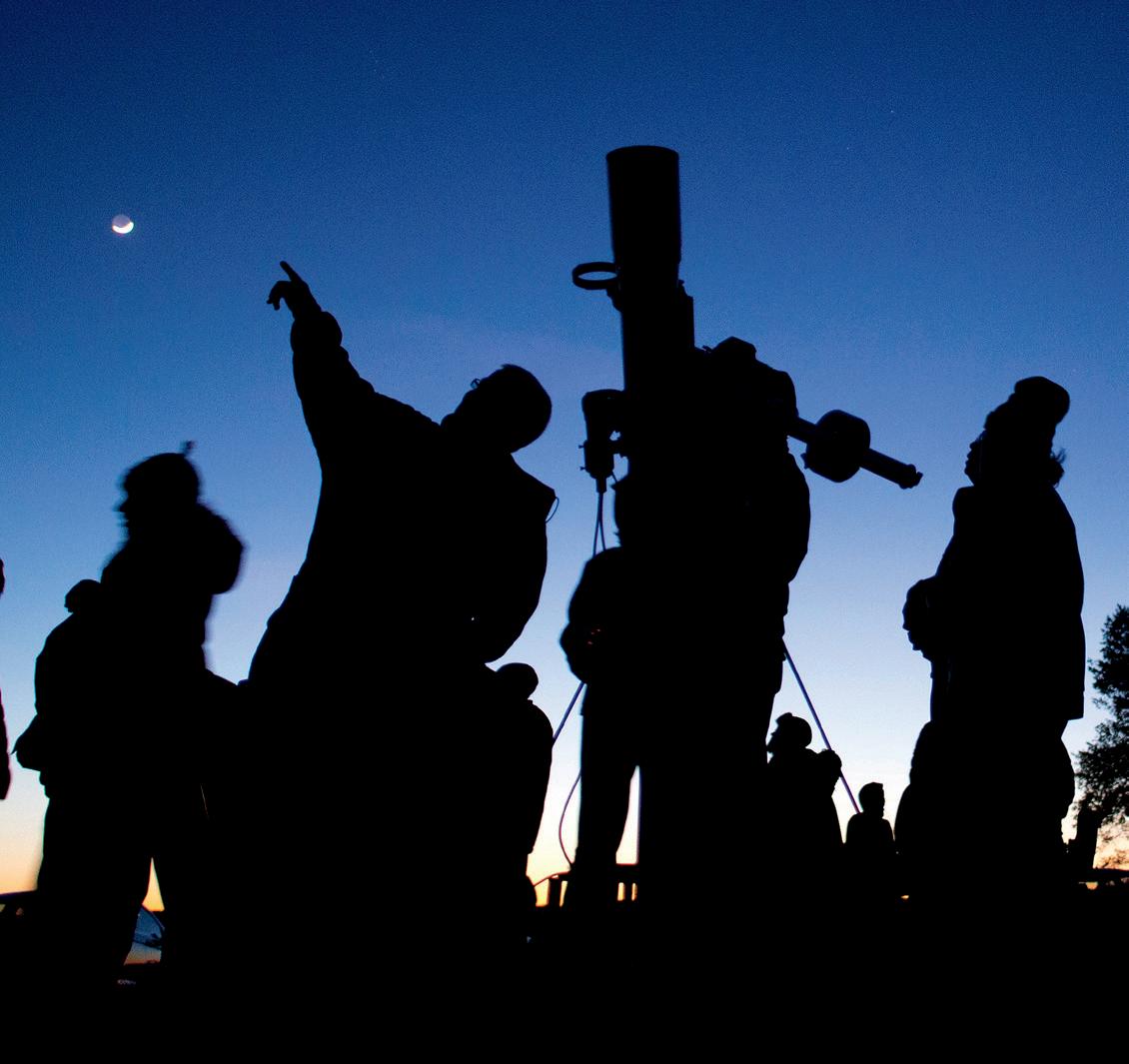
The Campaign for Carolina generated support that enabled the UNC Morehead Planetarium and Science Center to fulfill its mission to increase accessibility and expand its programming reach across the state.
• The North Carolina Science Festival — the annual statewide, month-long celebration of science — reached all 100 counties and increased the number of public events.
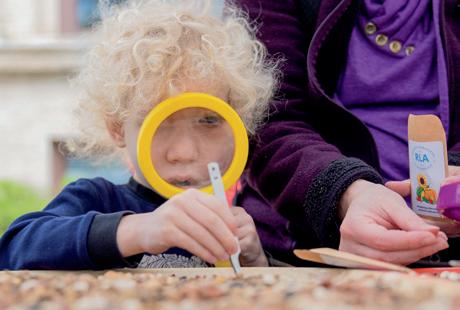
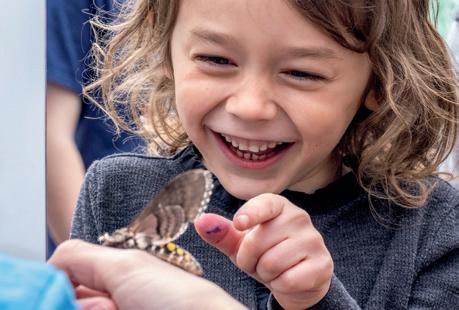
• Morehead’s educational programming at K–12 school sites continued to increase via the Duke Energy Science Night program.
• The North Carolina GlaxoSmithKline Foundation allowed Morehead to expand its community outreach goals through the IMPACTS Program, which provides community colleges with facilitated workshops, professional development opportunities and resources to produce community STEM events.
• GSK Science in the Summer programming continues to serve historically excluded and underserved communities, delivering free summer science camps in 11 counties.
• The planetarium’s free community skywatching sessions brought together people of all ages to learn about the night sky. Telescopes and guides from local astronomy organizations enhanced events, reaching almost 10,000 participants a year.

The UNC Morehead Planetarium and Science Center reaches all 100 North Carolina counties during its annual, month-long science festival.
Community members flock to the North Carolina Botanical Garden to enjoy sunny days, purchase native plants and enjoy the garden’s system of forested walking trails.
Muriel Easterling made a gift to the garden’s Piedmont Nature Trails endowment for the maintenance, care, restoration and improvement of the trails. Her gift will allow the garden to hire an annual Muriel Easterling Piedmont Nature Trails student intern to continue forest restoration efforts — including the eradication of invasive exotic plants along the trails. Easterling, whose volunteer efforts at the garden included maintaining the biodiversity of the forest, said, “I am thrilled to think of someone taking my place to do the work I can no longer complete.”
Exhibitions at the Ackland Art Museum bring the world to Carolina — and the people of North Carolina. A local museum with a global outlook, its location and programs bridge campus and community.
In 2016, the Smithsonian National Portrait Gallery Outwin Boochever Portrait Competition was sent on tour, and the Ackland was honored to host The Outwin: American Portraiture Today in 2018. The exhibition brought first-prize winner Amy Sherald, renowned for her official portrait of First Lady Michelle Obama, back to UNC-Chapel Hill. She had her first solo exhibition in 2011 at the UNC Sonja Haynes Stone Center for Black Culture and History.
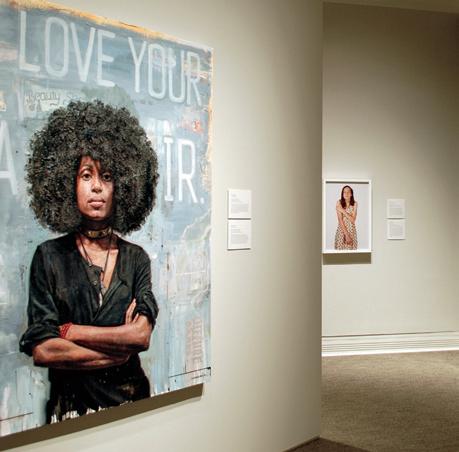
From January to April 2019, The Beautiful Brain exhibition bridged the realms of art and science, bringing thousands of first-time visitors to the Ackland to enjoy Santiago Ramón y Cajal’s iconic drawings alongside images made by UNC-Chapel Hill neuroscientists. “The Beautiful Brain was able to draw on rich University and local resources in presenting an exhibition of international importance,” said Peter Nisbet, Ackland deputy director for curatorial affairs.
From October 2021 to February 2022, more than 8,000 visitors experienced the unparalleled quality of the exhibit Buddha and Shiva, Lotus and Dragon:
Masterworks from the Mr. and Mrs. John D. Rockefeller 3rd Collection at Asia Society. “Buddha and Shiva gave UNC and the people of North Carolina the opportunity to see some of the finest ancient Asian art today in America. Thousands can now appreciate these pieces’ significance in the development of world culture,” said D. Smith Freeman ’68, ’72 (JD), Ackland National Advisory Board treasurer.
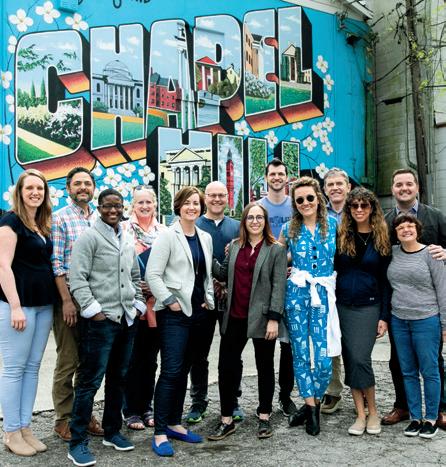
The Carolina Pride Alum Network’s first project was a big one: documenting queer history at UNC-Chapel Hill. “The Story of Us” — a collaboration among Wilson Library, the Southern Oral History Program and the UNC College of Arts and Sciences’ Department of Communication — is creating a permanent collection on queer Carolina history with manuscripts, archives, photographs and oral histories from LGBTQIA Tar Heels. An online exhibit called Queerolina connects locations on campus to individual stories from the project.
“We could never capture the entirety of LGBTQ+ experiences, but we’re hoping to give people a sense of the way that some of these community members understood space on UNC campus,” said Hooper Schultz ’14, a PhD student in the College’s Department of History and co-organizer of the Queerolina exhibit.
The Outwin exhibition at the AcklandThe engagement team at Carolina Performing Arts (CPA) creates connections among campus, community and artists locally and across the world. One of the ways CPA engages students and faculty is through music and dance.

CPA celebrated hip hop culture in collaboration with the surrounding community as part of the Southern Futures Initiative, which features arts experiences cocreated with local communities and focuses on racial equity and the American South. The Hip Hop South Festival featured headlining performances by hip hop heavyweights, including Big Boi, and local artists as well as academic gatherings, late-night beat and dance battles, visual arts, and more.
At a dance masterclass in 2022, attendees learned how to shake with the Queen of New Orleans Bounce, Big Freedia. The free and open to the public dance class with the nationally renowned hip-hop artist, TV personality and cultural influencer took place in Carolina Square Courtyard at CURRENT ArtSpace + Studio.


Breakdancers compete at CURRENT ArtSpace in Chapel Hill during the Hip Hop South Festival.
Students and community members learn to shake with the Queen of New Orleans Bounce.
As the premiere professional theater company of North Carolina, the UNC College of Arts and Sciences’ PlayMakers Repertory Company strives to produce entertaining, relevant and courageous work that tells stories from and for a multiplicity of perspectives and creates transformational impact in immediate and extended communities.
Youth engagement programs include the awardwinning Summer Youth Conservatory — the only professionally supported training program of its kind in the region. Middle schoolers can choose from a variety of classes while high school students work side by side with professionals — on stage and behind the scenes — culminating in a professional-quality production on PlayMakers mainstage. Support for this program ensures that all who are accepted can participate, regardless of financial need.
PlayMakers Mobile is an initiative that seeks to positively contribute to the civic and social life of the region by taking world-class theater into the community free of charge. Since 2017, it has grown from visiting four locations each year to as many as 17, including under-resourced schools, transitional housing and long-term treatment facilities.
Housed within the UNC Institute for the Environment, Sustainable Carolina advances the University’s sustainability goals through collaborative partnerships across operations, academics and research. Across the state, students at the institute’s field sites immerse themselves in research that extends outside the confines of Chapel Hill, although there’s one important field site right in town.

At the Sustainable Triangle Field Site, students gather data that inform Carolina and Chapel Hill’s shared sustainability efforts. The field site provides an ideal setting to pair academic studies about the environment, urban planning and urban design with practical experience delivered through internships, capstone research projects and field trips.

Actors with PlayMakers’ Summer Youth Conservatory perform Bright Star in 2019.
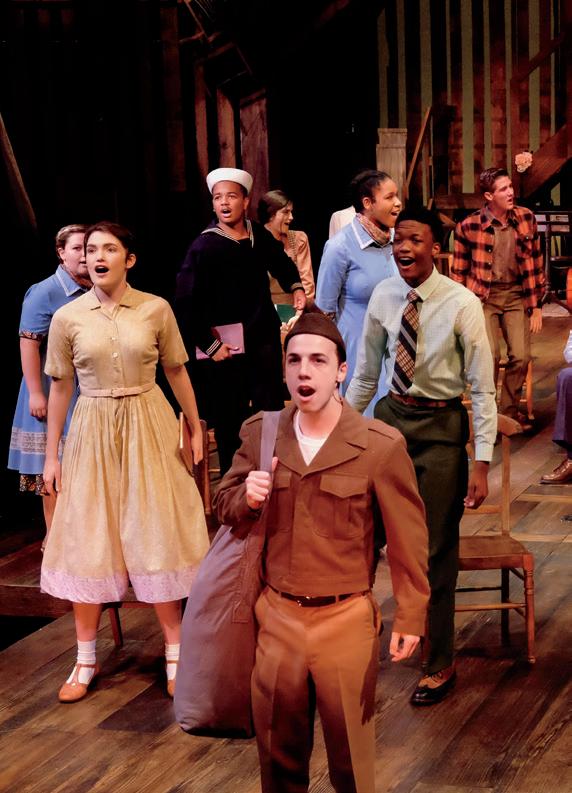

Carolina has a robust on-campus composting program in its dining halls, but for students who live off-campus, the options get expensive. “Our main aim is to expand access to composting for off-campus students,” said Sara Vandersip ’24, volunteer coordinator for CompostMates. Members receive food scrap buckets, and every other weekend CompostMates volunteers, like Vandersip, collect the scraps and drop them off to their garden partners: Carolina Community Garden, Edible Campus and the Giving Garden.

In 2021, the APPLES Robert E. Bryan Fellowship within the Carolina Center for Public Service provided program support and a financial award to the team of undergraduate students who created CompostMates.
In 2022, CompostMates received additional funding from the Carolina Parents Council to continue their work. A part of UNC Student Affairs, the council provides multiple grants every year to student organizations and University offices for innovative programs.

Supported as a Signature Initiative in the Campaign for Carolina, Arts Everywhere is a comprehensive drive to make the arts a fundamental part of Carolina culture and daily campus life. By collaborating with a variety of organizations and University departments, Arts Everywhere leverages the University’s collective strengths, embedding creative expression, live arts experiences and arts learning into students’ Carolina education. It’s hard to choose only 10 things we love about Arts Everywhere!
Each year, on a spring day in April, more than 30 performances, exhibits, hands-on activities and installations are sprinkled across campus and the surrounding community. On Arts Everywhere Day, the arts on campus truly shine!

My favorite part of Arts Everywhere Day is how it opens our eyes to all the creative things happening in and around campus that students aren’t aware of on a day-to-day basis. With Arts Everywhere Day, it’s as if the entire campus manifests this creative spirit and allows it to shine.
— Bri Charles ’20Walk up to a machine, press a button labeled “Carolina Stories,” and voilá! A short story emerges on a printed paper receipt. It could be a story written by a student, a faculty or community member, or a global author.
Nine of these short story dispensers are located throughout campus and the Chapel Hill community, including Epilogue Books on Franklin Street and the UNC Adams School of Dentistry. The initiative is part of a collaboration with UNC Press, the Department of English and Comparative Literature and the Creative Writing Program — both in the UNC College of Arts and Sciences — and Arts Everywhere.

“These machines manage to make the local global and situate UNC in a larger literary network,” said Kylan Rice, a PhD student in the Department of English and Comparative Literature in the UNC College of Arts and Sciences. “They act as portals to voices around the country and around the world, and I think that’s an exciting feature.”
Rice, the second Arts Everywhere Creative Writing Fellow, manages the short story dispensers and the team of undergraduate
student editors who curate the stories for the machines. “They’re the real stars,” Rice noted. “People might be surprised to learn that such a vibrant, evolving community supports the existence of this quirky local publishing network.”
SCAN — Students at Carolina Arts Network — was created with support from the UNC Student Affairs Parents Council grant program, which aids new and innovative initiatives that benefit undergraduate students. The student-focused arts hub
is a “one-stop arts info shop” that supports and promotes student connections, amplifies student arts at Carolina, and unifies the various student arts organizations to centralize resources.
Rice and a short story dispenser at Epilogue BooksMorehead City locals are more likely to notice Carolina’s presence at the coast, thanks to a new mural on the UNC Institute of Marine Sciences building.

Arts Everywhere murals can be found in a variety of locations across campus: on basketball courts and walls; in lobbies, basements and gyms — even all the way out at the coast! These splashes of colorful creative interruptions represent public art at its finest and, in some cases, celebrate advancements in research.
In spring 2021, Arts Everywhere assisted the UNC Institute of Marine Sciences in facilitating a mural design that was installed on the exterior of its building in Morehead City, North Carolina. The three-story mural created by Hillsborough, North Carolina, artist Max Dowdle celebrates the institute’s 75th anniversary, illustrating its wide range of work as well as the state’s coastal environment and people.
5
UNC Student Affairs hosts numerous events over the course of the first two weeks of the fall semester to welcome students to campus. Weeks of Welcome events range from receptions and
dinners to PlayMakers block parties and miniature golf in the undergraduate library. Arts Everywhere hosts a scavenger hunt to help students get to know the arts on campus through trivia questions and challenges.
To engage students in the arts, regardless of their background or skill level, Arts Everywhere partnered with the Department of Art and Art History and Carolina Housing to build an intramural arts studio in Morrison Residence Hall. The studio provides students, staff and faculty a space to create as well as access to no-cost supplies, workshops and programming. An MFA artist-in-residence supported by a year-long fellowship runs the studio, and undergraduate students help manage day-to-day operations.
Eden Teichman ’21, who majored in religious studies and minored in philosophy, politics and economics, shared her experience as an assistant studio manager during her
“People come to Morrison Art Studio for all different reasons: to work on a project with friends in an artistic way, to give themselves a break from the rigorous schedule of a UNC student or to paint an actual gallery-worthy piece of art. But every person who comes into the studio shares one thing in common — they all love and rave about what an amazing resource the Morrison Art Studio has become in their lives.”
Recognizing that students are often limited by monetary barriers in realizing artistic works, Arts Everywhere established grants to provide students with access to materials and resources. Gage Tarlton ’20, a dramatic art major, received the Arts Everywhere 2019–20 Student Arts Innovation Grant to produce his play, sons that wear dresses and mothers that love sweet potatoes. Despite the challenges of putting on a performance in 2020, he was able to present a virtual reading viewed by 300 people over three days.
“This play, at its core, is about hope,” said Tarlton. “It’s about losing everything and moving forward anyway. It’s about accepting the fact that life is never going to go as planned. It’s about finding the beauty in change.”
The show must go on — even during the pandemic. More than 300 people watched Tarlton perform a virtual reading of his play.

Arts Everywhere partnered with the UNC College of Arts and Sciences to offer a new class as part of the College’s IDEAs in Action curriculum that launched in fall 2022. “What is art? And where is it found?” explores why art matters; what roles artists play in their societies; and what changing conceptions of art tell us about people, cultures and values around the world. The course is open to all students, regardless of major.
The IDEAs in Action curriculum prepares graduates to become lifelong learners by providing students with a roadmap that allows them to choose their own path. Part of the curriculum includes courses designed to help undergraduate students make connections among different fields of study.
We’ve already mentioned the Arts Everywhere Creative Writing and Morrison Art Studio fellows. There’s also an Arts Everywhere Graduate Fellow in Music Technology! In 2022, Kelli Smith-Biwer, then a fourth-year doctoral student in the Department of Music in the College of Arts and Sciences, was named the inaugural fellow in music technology. As part of her fellowship, she worked in both the Beat Lab — a studio with specialized recording and mixing equipment in the music department’s Hill Hall — and the Video Presentation Studio.
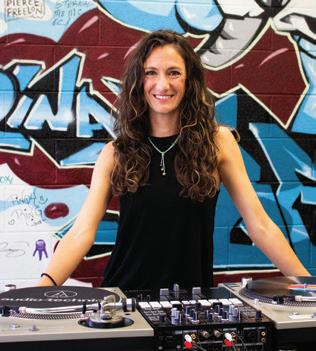
“At Carolina, my favorite experiences have been times like a recent night in the Beat Lab,” she said. “I held office hours and had a student at every single workstation in the room, asking me questions and doing something interesting and talking to each other. It’s amazing to see how the Beat Lab has grown. At the beginning of my fellowship, I would come in for office hours and it would just be empty. I would stand in
the hallway like a carnival barker trying to bring people in. Now I feel like all that work is paying off. It also makes me really excited for the next Arts Everywhere Fellow in Music Technology.”
Kelli Smith-Biwer at the Beat Lab, a studio where students can access recording and mixing equipmentArts Everywhere and the Department of Music teamed up to present First Fridays, a concert series that features pop-up performances by different student and chamber ensembles on the first Friday of each month. These informal concerts allow students, faculty, staff and community members to come and go as they listen to live music of all genres and configurations.
In 2021–22, the First Fridays season included performances by the UNC Harp Ensemble, Charanga Carolina — the only universitybased Cuban Charanga ensemble in North Carolina — the UNC Chamber Singers, the Carolina Ukulele Ensemble and the Carolina Bluegrass Band. The season closed at the Beat Lab, where Smith-Biwer led demonstrations of the mechanics behind the turntables and equipment used by DJs.
 A First Friday holiday choir performs at Hill Hall.
A First Friday holiday choir performs at Hill Hall.
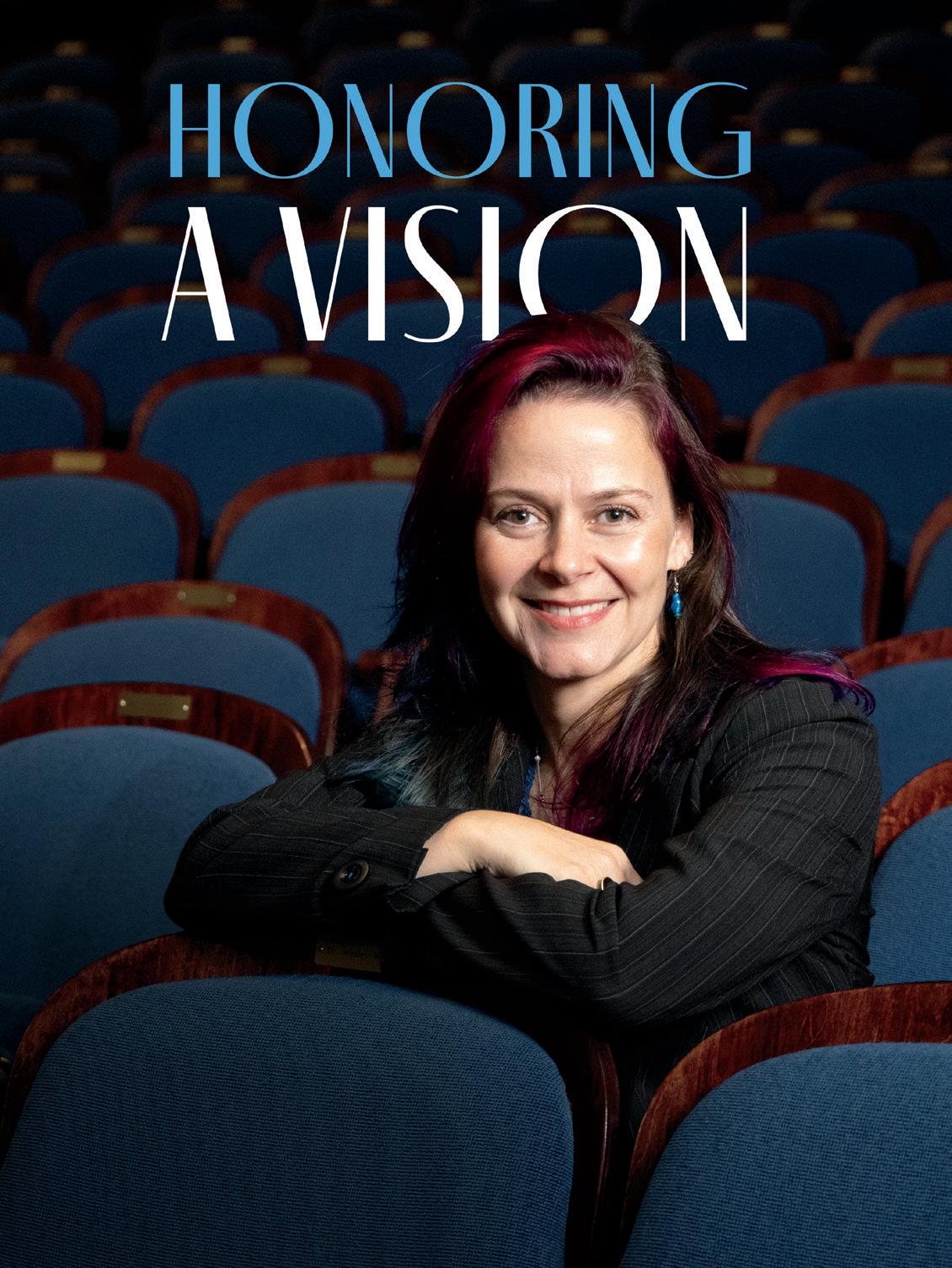 Alison Friedman
Alison Friedman
Before coming to Carolina, Alison Friedman spent two decades working in Asia. Most recently, she was artistic director for performing arts for the West Kowloon Cultural District Authority in Hong Kong, one of the world’s largest arts and cultural developments. Friedman was named the inaugural James and Susan Moeser Executive and Artistic Director at Carolina Performing Arts (CPA) in October 2021. Here she shares her thoughts on the position, its resources and the impact of CPA after serving more than a year at the helm.
On coming halfway across the world to work at Carolina:
“My career has been built around using the arts to build bridges between cultures, between people, to show us sides of each other that we don’t see through the press, through politics or through business. How do we see our shared humanity? The arts can do that like nothing else. In seeking a platform to continue this work, I realized there isn’t a more exciting place than America’s oldest public university — a major global public research university in the American South.
It’s thrilling to be here to partner across science and business and health and athletics and find ways for the arts to intersect with all of that and amplify and deepen research and student engagement.”
On the impact of anonymous donors establishing the James and Susan Moeser Endowed Fund for the Executive and Artistic Director at CPA:

“This transformative gift creates an element of freedom and stability. Gifts like this have major ripple effects that are empowering and freeing for a new leader coming in. I can’t express the gratitude and relief as a new leader to come into a position that has been set up before me and get neither credit nor blame. I just get to be the beneficiary. It is so rare and so visionary of these anonymous givers to have honored the transformative vision of the Moesers. I feel a great sense of responsibility inheriting this legacy but also excitement to take it forward.”
On the impact of CPA:
“UNC and its global reputation have been enhanced because of Carolina Performing Arts. CPA is not even 20 years old and already is one of the nation’s leading major performing arts presenters — not just at a university but in general. Organizations like the Bolshoi come to the U.S. and will go to New York, maybe one other city and Chapel Hill. And that’s because of this incredible institution, that James Moeser, when he was chancellor, had the vision to found and to set it up for success.
“Another impact is that we’re not just a presenting organization that buys a show, presents a show, sells tickets and moves on. We work over multiple years with artists in residence, with professors, with students, to produce new works. It’s the kind of research and development you’d have in science, and we have it here with the arts.”
“GIFTS LIKE THIS HAVE MAJOR RIPPLE EFFECTS THAT ARE EMPOWERING AND FREEING FOR A NEW LEADER COMING IN.”

citizens, civil rights leaders and environmental activists fought state plans to relocate 60,000 tons of carcinogen-laced soil to the majority Black community of Afton, North Carolina. The four-year effort culminated in seven weeks of protests and more than 500 arrests before the state dumped 7,000 truckloads of contaminated soil in the community. Today, the intersection of environmental and civil rights activism present in the Warren County fight is viewed as a watershed moment for the environmental justice movement. Despite this recognition, histories of the fight often leave out the
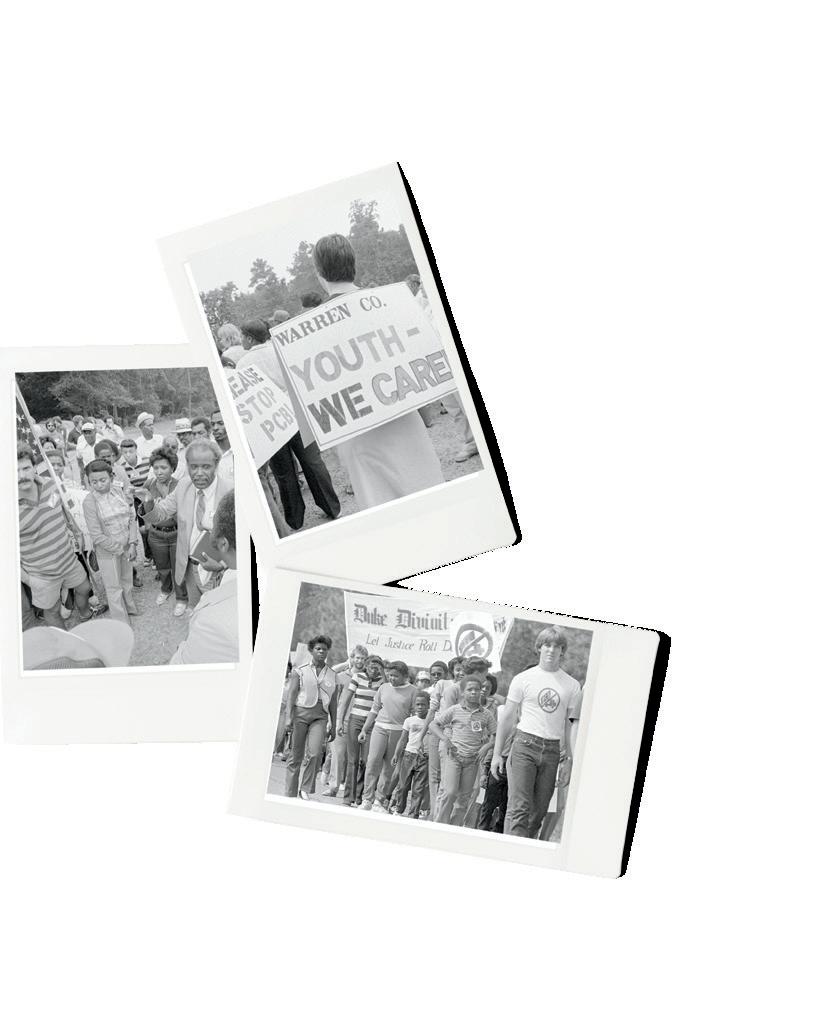
We Birthed the Movement: The Warren an exhibit at the Wilson Special Collections Library, told the story through the perspectives of those who lived it. Visitors could view photos from the protests and original documents, including correspondence, flyers
Community members, activists and reporters shared their memories, loaned materials, helped identify people in photos from the library’s archives and provided commentary included in the exhibit. “This exhibit brought up important questions about how stories are documented, who gets to tell these stories and how we engage people in meaningful ways,” said Chaitra Powell, the Sarah Graham Kenan Curator of the Southern Historical Collection. “The exhibit commemorated the birth of the environmental justice movement and also gave some folks who haven’t had the chance to tell their
Powell came to the University Libraries in 2014 as the African American collections and outreach archivist — where she worked extensively in community-driven archives. As the inaugural Sarah Graham Kenan Curator of the Southern Historical Collection, her role is different, but her passion for community-driven archives remains. “Is extracting materials from communities the only way to build collections or are there other ways we can think about it?” Powell continues to ask in her work. “Curating archives focused on a community’s memories, culture and experiences and making them accessible to everyone has the power to enrich communities.”
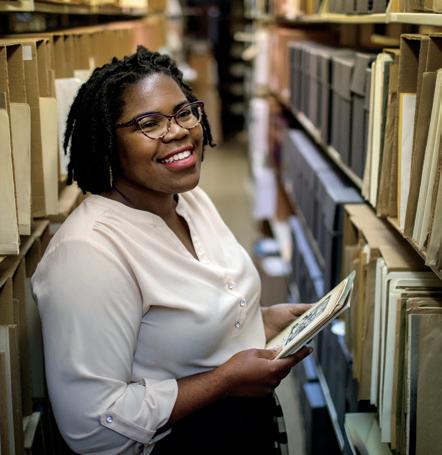
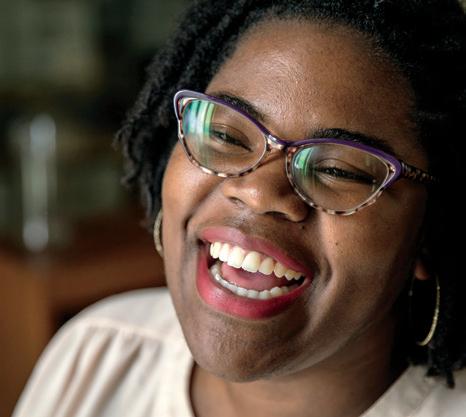
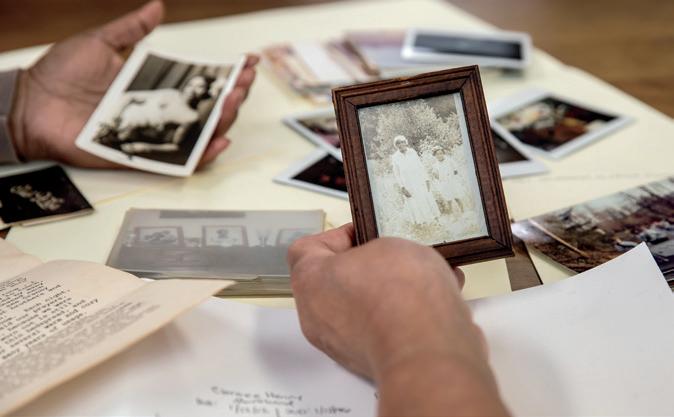
ARCHIVIST IN A BACKPACK
Through a grant from the Andrew W. Mellon Foundation, Southern Historical Collection archivists partner with individuals and communities to support grassroots efforts to record and preserve local history. The archivists provide training, technical know-how and bags and backpacks full of supplies and equipment — the tools a community-based historian needs to conduct and record oral history interviews and begin assembling photographs, letters, documents and meaningful artifacts.
Between March 2017 and March 2021, Wilson Library shared 68 backpacks across eight states.

Scott Edwards’ father served on a B-29 shot down over Tokyo in World War II. Six of the 11-man crew died. One of the five survivors, James Edwards was taken prisoner and endured two months alone confined in a hole.
Back home in North Carolina, James went to Carolina to get a pharmacy degree and because — as Scott described it — “He made a promise to himself that he wasn’t going to be in a place where he couldn’t see people.”
The GI Bill helped with finances, but it wasn’t enough to support a wife, Scott and a little sister who was on the way. To make ends meet, the family lived with Scott’s maternal grandparents in Scotland Neck, a small town in eastern North Carolina. James stayed in Chapel Hill to attend classes but on weekends drove 100 miles each way to be home with his family.
By the time James graduated in 1949, he’d thoroughly swayed his son to Carolina loyalty, reinforced with visual aids: photos of Tar Heel football legend Charlie “Choo Choo” Justice adorned the walls of the house in Scotland Neck. “I was born going to Carolina,” said Scott, a 1967 graduate. “It’s all I knew.”
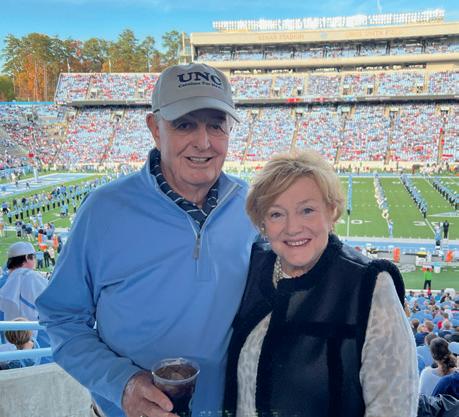
He did consider one other school, but only briefly. “I filled out the application to Duke but tore it up that night and threw it in the trash.”
He thought he’d be pre-med at Carolina but majored in business because the “business classes I got in were the ones I enjoyed.”
Along with finding his passion in Chapel Hill, Scott found the path to the love of his life.
One of his roommates dated a girl who went to what is now East Carolina University. He asked Scott if he’d like to go on a blind date in Greenville with another girl from ECU. Scott said yes, and the girl turned out to be Lyn Lovelace. A love-at-first-sight romance grew into a marriage of 54 years and counting.
“When I came around the corner to the parlor in my dormitory and saw Scott waiting, I said to myself, ‘That’s the guy I’m going to marry,’” Lyn said.
While Scott was at UNC, Central Carolina Bank held interviews on campus for the first time. One of three students interviewed to get a job, Scott started out as an assistant branch manager in Durham, when CCB was “a little bank with 15 branches.”
“The tellers knew more than I did,” Scott said.
But it didn’t take long for him to get the hang of things. He rose to the rank of chief administrative officer of National Commerce Financial, CCB’s parent company. NCF would later merge with SunTrust Banks and by then was among the largest banks in the world with $25 billion in assets. Scott retired in 2007, ending his career as SunTrust’s head of credit for North and South Carolina.
In the intervening years, Scott and Lyn had a daughter and a son. Lyn, who’d taught second grade, became a full-time homemaker. Although she graduated from ECU, she’d
gone to Peace College in Raleigh the two previous years and didn’t feel a particular affinity for the Pirates.
“For our third date, Scott brought me to Chapel Hill for the Duke football game,” she said. “We lost, unfortunately, but there was no looking back. I was a Tar Heel.”
With so much Carolina Blue in their blood, the Edwardses decided to honor what Carolina meant to them by making a tangible difference through their philanthropy. In 2005, they established a charitable remainder unitrust (CRUT), a charitable strategy that provides the donor a steady stream of income and significant tax benefits.
Typically, charitable beneficiaries don’t receive CRUT disbursements until after income beneficiaries die or a specified term of years passes. The Edwardses’ CRUT was set up to provide income to them for their joint lives — that is until 2021, when they realized they could forgo their income stream and allow the value of the trust to vest with Carolina and the areas of the University they cared about greatly. Their reasoning was simple.
“It just made sense to give it to them now because they need it now,” Scott said.
The Edwardses designated three areas to benefit: the Carolina Covenant, UNC Kenan-Flagler Business School, and scholarships for UNC student-athletes.
The Carolina Covenant was an easy choice. The program, which supports exemplary students from low-income families, was in its first year when Scott and Lyn established their CRUT. For Scott, the gift served to honor his father and maternal grandfather, a 1918 graduate who also earned a pharmacy degree. Both were
the first in their families to attend college, and both would have qualified for the Covenant had it existed. Scott could also relate to the financial challenges faced by students from modest means. He worked to help put himself through Carolina, doing jobs that included detasseling corn and unloading sheet tobacco.
Now, the Edwardses also see their gift as answering the call of Roy and Wanda Williams, early champions of the Covenant who continue to support it both as donors and advocates.
More than anything, the Covenant appealed to Scott and Lyn as a way to share their good fortune and help sustain Carolina’s long tradition of excellence and access.
“I do feel like we get an Ivy League education at a public school price,” Scott said.
At UNC Kenan-Flagler, the income provides unrestricted funds to meet the school’s top priorities, such as student fellowships and faculty support. Supporting the business school was another easy choice.
“They made me who I am,” Scott said.
And creating scholarships for Carolina’s student-athletes fit perfectly, too, given Scott’s life-long love for the Tar Heels.
Scott’s sister, younger brother and his son graduated from Carolina, and while the Edwardses’ two children went elsewhere, they’re both diehard fans. To cover all the bases, Scott and Lyn buy 12 season football tickets each year and make a Saturday in Chapel Hill an extended family affair.
“There’s no place like Kenan Stadium in the fall,” Scott said.
By Scott Ragland ’87What is a planned gift?
Planned gifts are thoughtfully structured charitable gifts that enable donors to fulfill their personal, financial and philanthropic goals. Planned gifts, which include current gifts of cash or complex assets, such as business interests and real estate, as well as deferred commitments, play an important role in securing the resources Carolina needs to carry out its mission by allowing donors to make contributions larger than they thought possible. The Office of Gift Planning works with donors and their personal advisors to develop comprehensive strategies for current and deferred giving and to ensure Carolina remains a truly public, truly preeminent global institution.
While many gifts are already at work supporting Carolina’s key strategic priorities, contributions totaling more than $1.2 billion were made through deferred gifts, such as estate gifts, meaning the full impact of the Campaign for Carolina will be measured in the generations to come as well as in the present. The generosity and forward focus of donors who have made endowment gifts and bequests ensure that Carolina is better equipped to meet the needs of students, faculty and staff in the future. Here are just a few examples of gifts made by these forward-focused individuals.
With a focused resolve and profound intention, Jim ’69 (MPH) and Delight Allen chose to leave a conservation legacy to benefit the North Carolina Botanical Garden through their estate. Their bequest will build the garden’s general operating endowment, which supports the daily activities that keep the garden open and available for the community. The garden’s main visitor facility was named the James & Delight Allen Education Center in their honor and is a testament to the conservation values the couple shares.
“Jimmy and I are pleased to have our names associated with the garden, and it is very satisfying to be able to help in this way,” Delight Allen said. “The North Carolina Botanical Garden is a special place and an important part of the University. The staff is very dedicated and provides a great service to our state and community. We want to be sure they have the resources they need to continue their good work.”

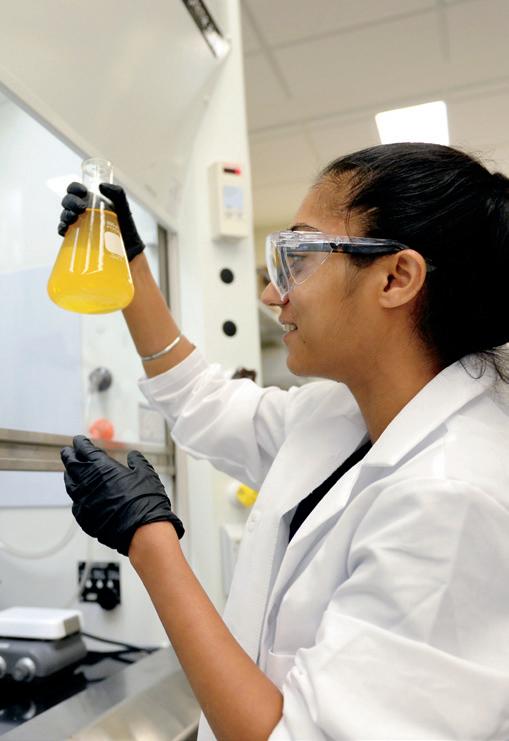
A $1.75 million estate gift from an anonymous donor will help further diversify The Graduate School’s student body across STEM fields. When realized, the gift will ultimately support hundreds of graduate students at Carolina.
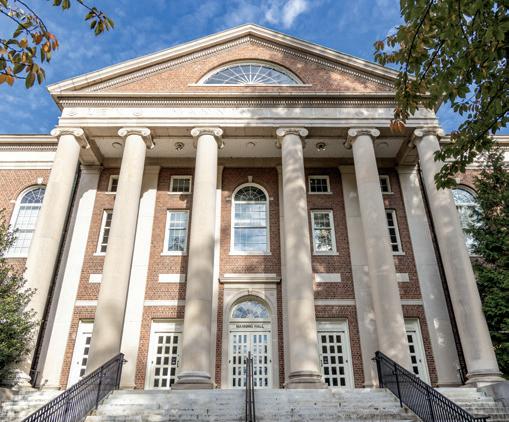
By minimizing debt, the gift will enable the University’s graduate programs to attract top students and alleviate the financial pressure that comes with publishing a thesis or a dissertation. This research directly impacts societal issues, including wellness and health outcomes, and helps Carolina remain at the forefront of graduate education.
“The donor’s gift will do more than just support individual students — it will support an educational and research culture that promotes innovation, creativity and success,” said Suzanne Barbour, former dean of The Graduate School.
Adding another entry to Carolina’s long list of “firsts,” Charles B. Lowry ’74 (MSLS) and Marcia Duncan Lowry made the first commitment to endow a University deanship. Their bequest will establish the Duncan-Lowry Deanship at the UNC School of Information and Library Science (SILS), providing future deans with flexible funding to meet the school’s strategic priorities. The commitment also honored Edward Holley, a former SILS dean and Charles’ friend and mentor, who stressed doing things “for the good of the order.”
“I am so happy that Ed and others that came before us were able to lay down the foundation for that culture, and inspire people like Charles to believe in that and remember it, because it continues to pay dividends,” said Gary Marchionini, SILS dean and Cary C. Boshamer Distinguished Professor.
Sharon Johnson Rothwell ’77, ’78 (MPA), originally from Dunn, North Carolina, and Doug Rothwell ’80 (MPA), originally from Philadelphia, Pennsylvania, met on the first day of orientation for the UNC Master of Public Administration program in 1978. The couple made a bequest to Carolina Performing Arts, cementing their support of live performances, world-class artist residencies and educational programs for students, such as masterclasses. “We believe that universities play a major role in exposing both communities and students to the arts,” said Doug. “It is important to us to be in a community where you can have world-class opportunities in the performing arts. I don’t think Chapel Hill would be anything near what it is today without Carolina Performing Arts.”
“We both feel strongly that one of the most significant ways you can help the future is by supporting higher education,” Sharon said. “We’ve endowed scholarships, are annual givers and are contributing as part of our estate planning. We think you need to give now, and you need to plan for the future in terms of giving back. With public funding for higher education decreasing across the country, both annual support and planned giving are essential for the future of our University.”
A love of theater and appreciation for the world-class productions by the PlayMakers Repertory Company inspired the late Joan H. Gillings to establish an endowment to significantly increase the University’s performing arts programming. In honor of her generosity, the Center for Dramatic Art, home to the Department of Dramatic Art and PlayMakers in the UNC College of Arts and Sciences, was named the Joan H. Gillings Center for Dramatic Art. The gift’s impact has been felt throughout PlayMakers and beyond, with funds supporting:

• graduate scholarships in acting, costume and technical production;
• PlayMakers’ Mobile Shakespeare initiative;

• K-12 educational matinees; and
• teaching artist residency programs.
A $25 million bequest from an anonymous donor will enable the UNC College of Arts and Sciences to compete for the most promising graduate students for generations to come, an advantage that also benefits the faculty who teach and mentor as well as the undergraduates who are taught by these superlative scholars.

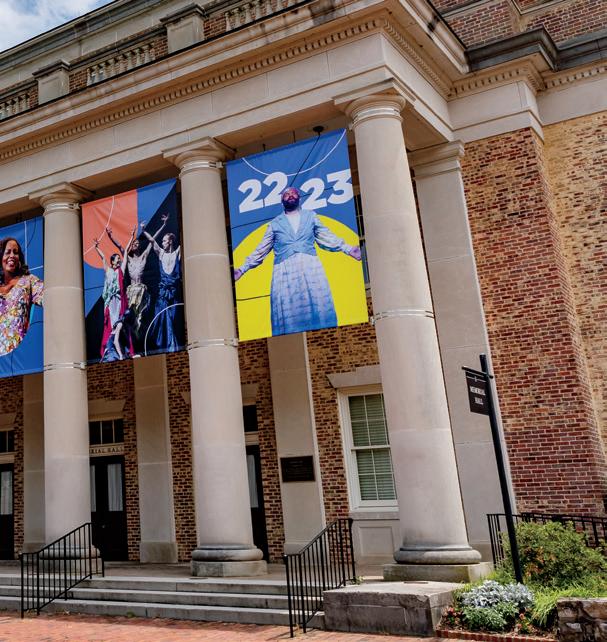
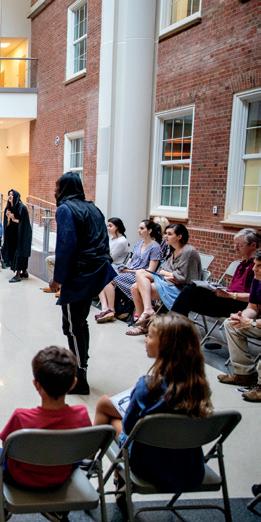
Once realized, the gift will fund fellowships that could support more than 200 students annually. Recipients will teach or mentor undergraduate students in the classroom or in a research setting. They will receive a stipend during the academic year and will be eligible for a summer stipend and funding to use for travel or to participate in academic conferences.
“This generous gift helps us meet a critical need,” said Terry Rhodes, the College’s interim dean when the gift was committed. “Our department chairs cite increased graduate student support as one of their most urgent priorities.”
Angela Kashuba, dean of the UNC Eshelman School of Pharmacy, is passionate about student financial aid. As a first-generation college student who commuted 1.5 hours each way as an undergraduate student, she knows the potential impact of scholarships.
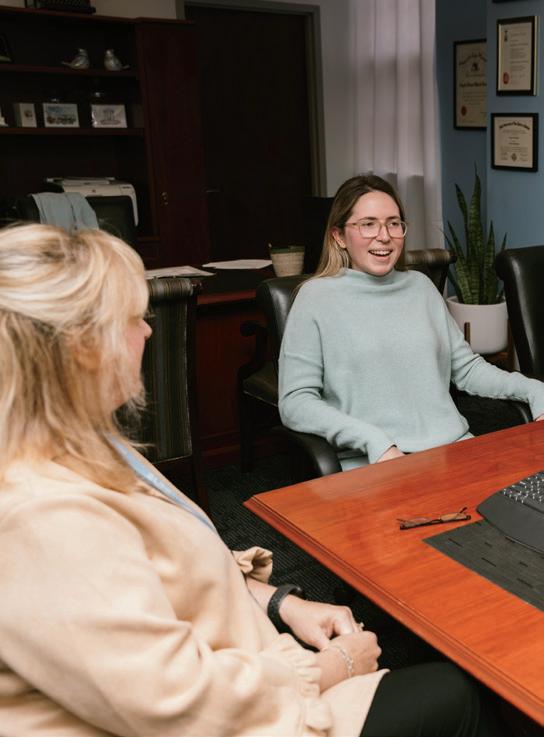
“Scholarships relieve stress and give students the financial freedom to explore their options and be fully immersed in what’s going on around them — on campus, within our school and within the profession,” said Kashuba. “When a student doesn’t have as much financial freedom, they are working all the time to support themselves, or feel the need to lock in on a career path as quickly as possible, and they miss out on the enriching experiences that can help them grow as people and professionals.”
Historically, the pharmacy school has prioritized giving financial awards to as many students as possible, even if the awards were relatively small. But school leadership became concerned that the awards weren’t making enough of an impact, especially for students from the state’s rural and underserved areas.
The school’s scholarship program is being revamped to offer a greater number of half-to-full scholarships. Each year eight full four-year scholarships will be awarded to in-state students, and another 25–30 half-to-full fouryear scholarships will be awarded.
In addition to the financial awards, scholarship recipients will benefit from a full scholarship program, modeled after the Morehead-Cain, that includes a global experience, a dedicated alumni mentor and time with school leadership, including the dean.
This new scholarship program is possible thanks to the pharmacy school’s many generous and engaged donors.
One such donor was alumna Linda Griffin. Griffin earned a pharmacy degree in 1973, and remained a committed supporter of the school throughout her career in retail pharmacy and then in the pharmaceutical industry. She passed away in April 2020, only nine weeks after receiving an advanced cancer diagnosis, and left an estate gift that included scholarship and unrestricted funds that have been vitally important in getting the Signature Scholarship off the ground.
“We are the only public pharmacy school in North Carolina, and we’re committed to having a student population that reflects the state’s demographics,”
A realized estate gift goes toward a new scholarship program for pharmacy students.said Kashuba. “Many students from rural and underserved areas would struggle financially without these scholarships, but with this assistance, they will become the best pharmacists for their communities.”
Studies show that health care providers who share lived experiences with their patients provide better care and are more trusted by the community. And many students from rural communities have a strong desire to return home after completing pharmacy school and provide care in their own community. With this in mind, the school’s leadership team believes that improving accessibility for a wider group of in-state students can improve the health of countless North Carolinians in underserved areas.
The financial aid portion of the Signature Scholarship program has already launched, with scholarships awarded to 26 students in fall 2022. The corresponding enrichment program is still being designed and will roll out in fall 2023.
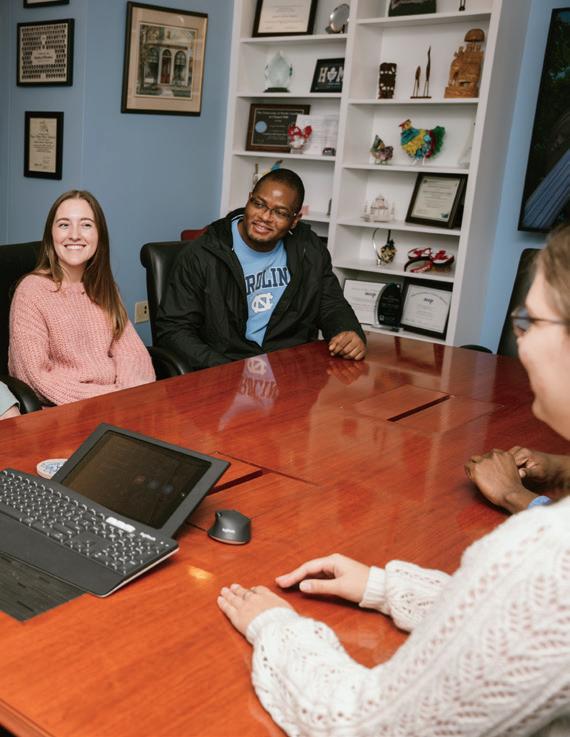 By Audrey Smith ’10
By Audrey Smith ’10
After graduating with a degree in chemical engineering and working at a manufacturing plant, Julian Garcia ’23 (PharmD) felt like he wasn’t reaching his full potential. He wanted to make an impact on his community. “After researching other career paths, I found that pharmacy interested me, specifically industry pharmacy, as I would be able to combine what I learned as an engineer with the clinical knowledge of a pharmacist,” said Garcia.
Garcia is part of the inaugural class of Signature Scholarship recipients at the UNC Eshelman School of Pharmacy. “Private funding has made my experience at Carolina much easier and has allowed me to focus on what matters most: learning from the brilliant professors and exercising the skills necessary to become a successful graduate,” said Garcia.
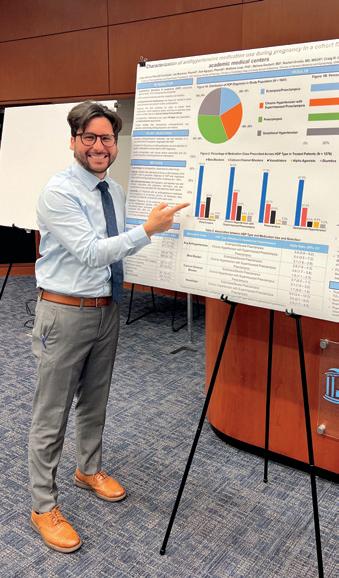
GiveUNC was launched in 2018 as Carolina’s University-wide annual day of giving — a day when alumni, friends, students, faculty and staff come together to support the causes they care about most.

It’s a day when the University’s biggest fans collectively contribute millions of dollars in support of the people, programs, experiences and groundbreaking work being done by Tar Heels here in Chapel Hill and across the world.
Most importantly, “GiveUNC is a day to rally together behind all the wonderful things that Carolina is doing for the community,
the state, the world,” said Darlene Gooch, executive director of Carolina Annual Giving, the University Development Office department that spearheads GiveUNC. “There’s truly no other day like it.”
On any day of the year, gifts of all sizes make a difference at Carolina. But on GiveUNC, the power is in the collective impact Tar Heels across the world can make in just one day. And those days add up over time. From 2018 to 2022, donors — including 3,780 first-time donors to Carolina — contributed more than $44.8 million on GiveUNC!

On October 6, 2017, Carolina launched its most ambitious fundraising campaign ever — For All Kind: the Campaign for Carolina. We asked ourselves: What will it take to fulfill our potential so we can make the biggest difference in the world? That, in turn, drove our three campaign priorities:
• STUDENTS AND THE EDUCATIONAL EXPERIENCE — Provide access and global experiences; innovative teaching and experiential learning; and buildings and spaces that optimize success in academics and athletics.
• FACULTY AND SCHOLARSHIP — Recruit and retain world-class faculty; foster an environment of collaboration, creativity and service; and support high-potential, high-reward research.
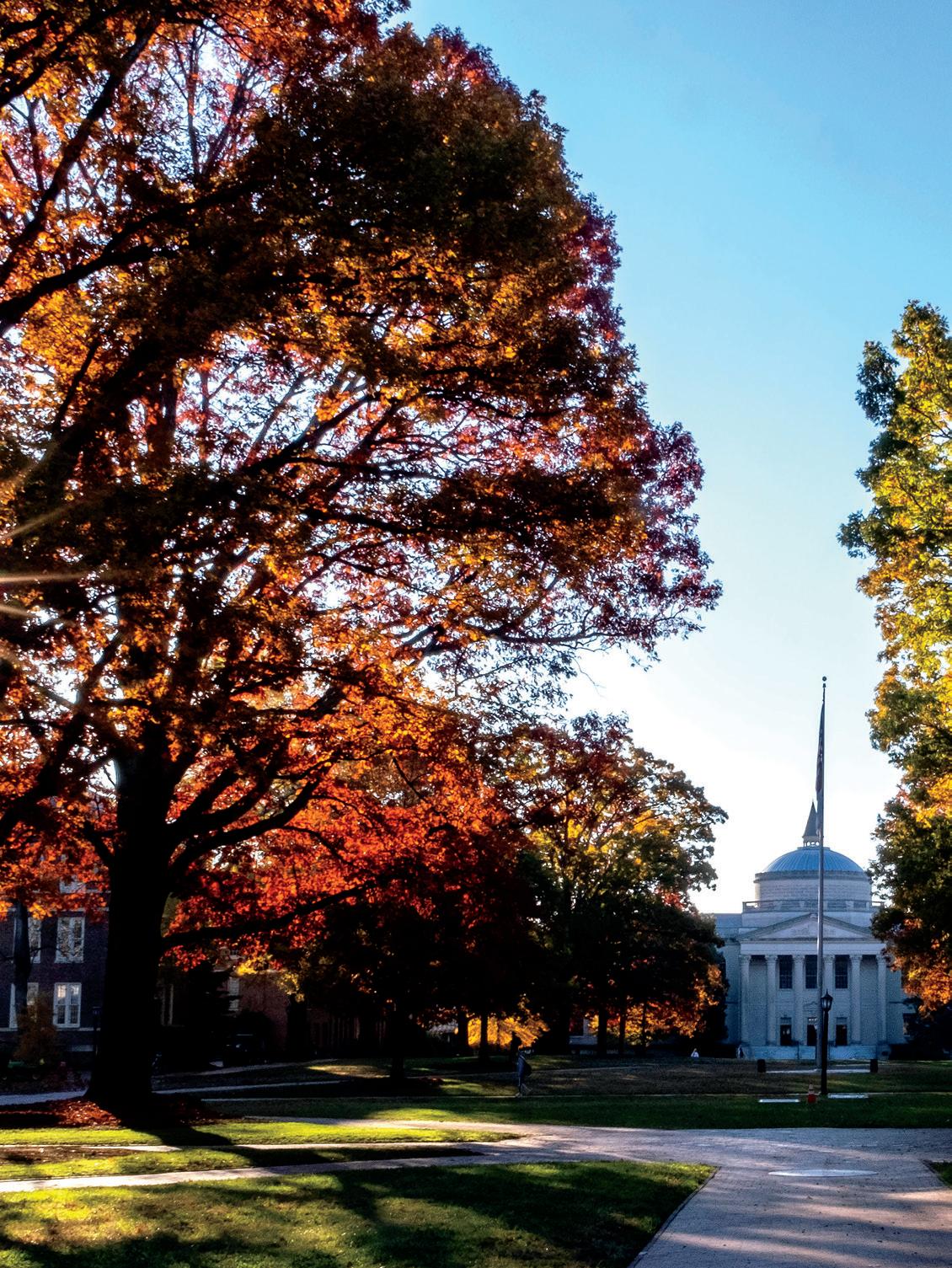
• INNOVATION AND IMPACT — Strengthen our impact in North Carolina and around the world; accelerate entrepreneurial ideas; and support and expand thought-provoking arts programming.
The numbers ahead reflect the success of the Campaign for Carolina thanks to the astounding generosity of donors like you.

Total amounts raised by each of the 26 schools and units that announced campaign goals at launch
We also identified four Signature Initiatives to address issues and opportunities that emerged over the course of the campaign:
Raise $1 billion in support of scholarships and fellowships.

CONVERGENT
Work across disciplines to solve the world’s greatest problems.
Make the arts central to our campus ethos.
Ensure a global education is available to every student.
FIRST IN THE SOUTH
1 OF 6 PUBLIC UNIVERSITIES IN THE U.S.
1 OF 16 UNIVERSITIES IN THE NATION
…to raise more than $5 billion in a completed campaign
11,319 FACULTY & STAFF GAVE A TOTAL OF $279.21M
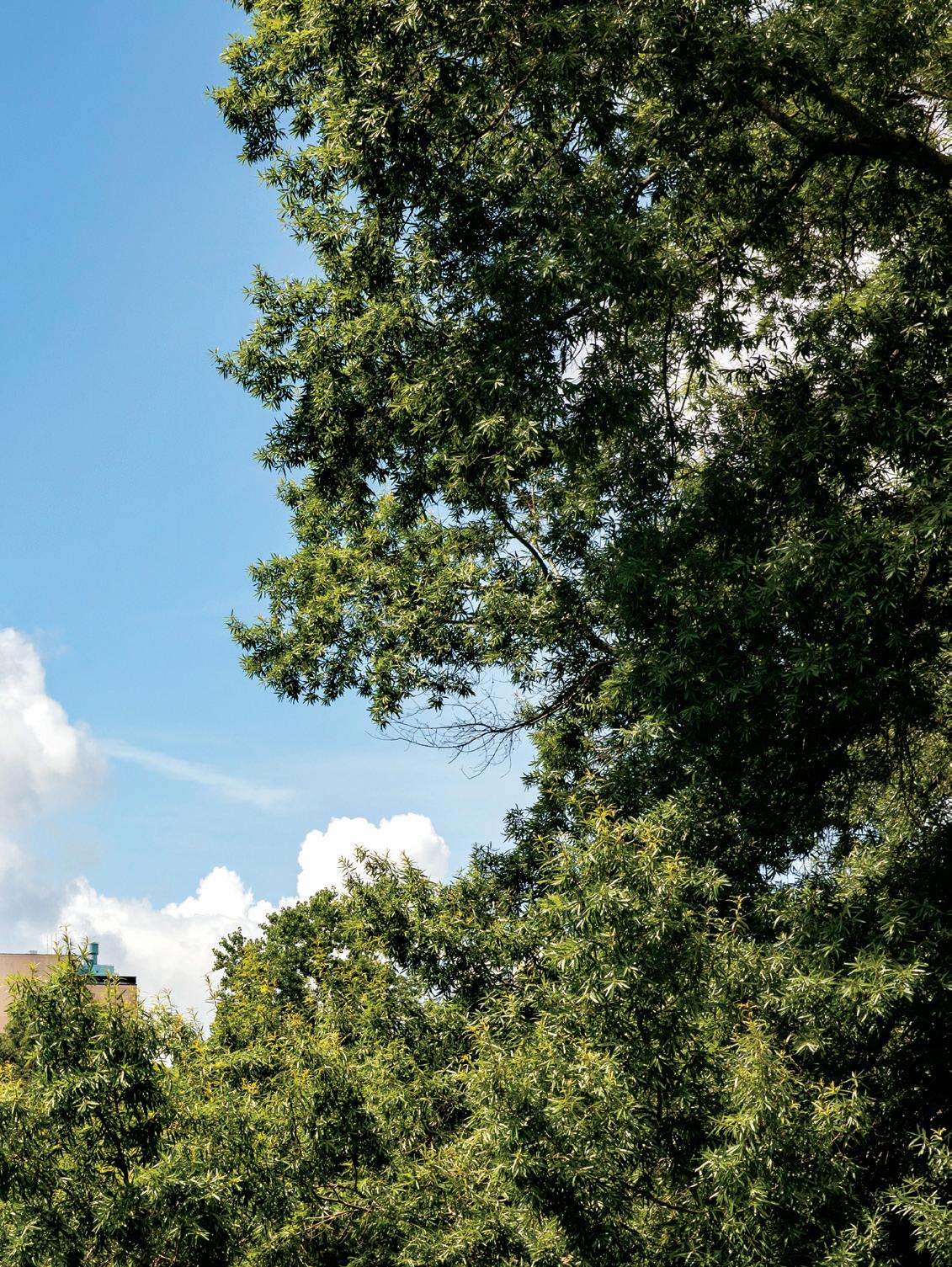
16+ MAJOR BUILDING and renovation PROJECTS
SIGNATURE INITIATIVES
CAROLINA EDGE $1+ billion
AND 980+ NEW FUNDS
FOR SCHOLARSHIPS AND FELLOWSHIPS
CONVERGENT SCIENCE $452M
14,678 PARENTS GAVE A TOTAL OF $400.61 M
ARTS EVERYWHERE $226 million $517 MILLION
A GLOBAL MINDSET
3,300+ VOLUNTEERS HELPED MAKE THE CAMPAIGN A SUCCESS
“Every gift at Carolina is an act of hope. It’s a belief in our students, faculty and staff, and their aspirations for our future. Your generosity means Carolina will continue to prepare generations of students and scholars to solve the grand challenges of our time, and we can’t thank you enough.”
 — Chancellor Kevin M. Guskiewicz
— Chancellor Kevin M. Guskiewicz
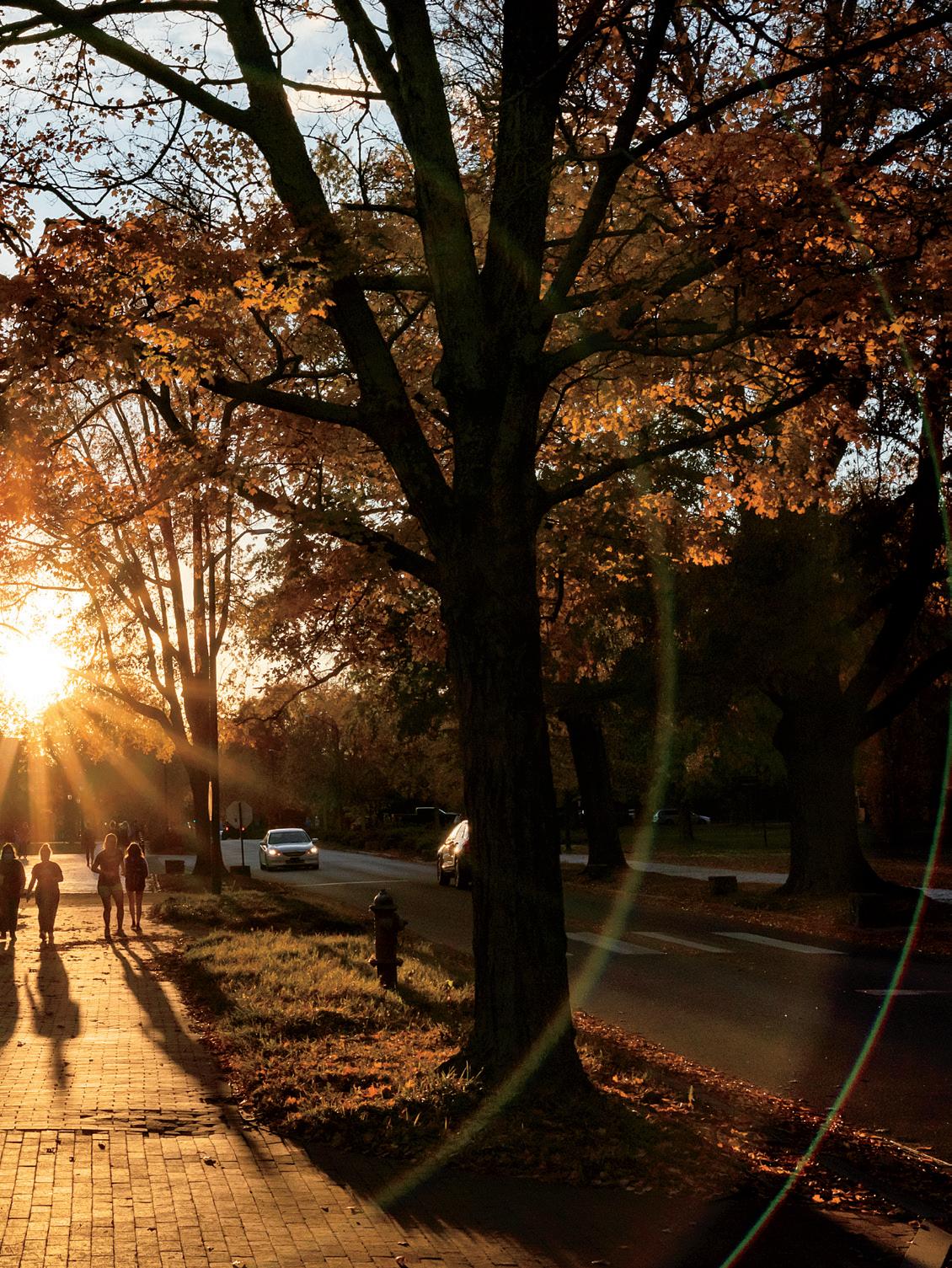
Carolina Stories Magazine is published by the University Development Office Department of Marketing and Communications at the University of North Carolina at Chapel Hill. You are receiving this magazine because you support UNC-Chapel Hill. Read more Carolina Stories at stories.unc.edu.
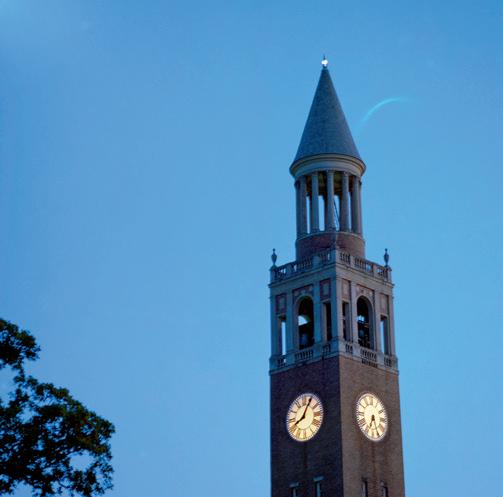
Executive Director Holly Graham Boney
Creative Director Christina Berkowitz
Managing Editor Angela Harwood
Lead Designer Maggie Lowe
Writers
Brandon Bieltz
Felicia Carey
Anna Katherine Clemmons
Claire Cusick ’21 (MA)
Mark Derewicz
Drew Guiteras ’00
Angela Harwood
Kay Langley ’22, ’24 (MA)
Elise Mahon
Scott Ragland ’87
Audrey Smith ’10

Contributors
Jeyhoun Allebaugh
Lucy Dunderdale Cate

Mary Charles Hale
Jeff Hill ’92, ’02 (MBA)
Keith Hines ’02
Jen Hughey
LaShonda Lewis
Caroline Norton ’20
David Swan
Kaitlyn Vogt ’13
Cynthia Whitted ’87
Chris Williams
Jess Abel 146, Jeyhoun Allebaugh cover, 1, 3 (top left and bottom left), 4, 16, 18 (right), 23 (top left), 30, 34, 36 (bottom), 43–44, 46 (left and right), 48, 49, 56 (middle), 58 (right), 61–62, 80–81, 90–92, 108–09, 122–23, 125, 128, 138 (bottom), 160, Johnny Andrews 3 (bottom right), 19 (right), 35, 39, 45 (right), 51, 63, 65 (top right), 110–16, 139 (top), 140 (top left), 142, 151, 156, 164–67, Melanie Busbee 89 (right), 155 (top), Jeffrey A. Camarati 45 (middle), 58 (left), Nash Consing 26, Jafar Fallahi 124, 127, 161, Jon Gardiner 18 (left), 50, 60, 65 (top left, bottom right), 130–32, 136, 137 (bottom), 157 (bottom), 162–63, Alice Hudson 7, Jen Hughey 2 (top), 3 (middle right), 9–12, 20, 27 (top), 31, 36 (top), 38, 52–53, 59 (right), 74, 84–88, 119–21, 133–34, 143–44, 148–49, 154, 155 (bottom), Ken Huth 140–41, Mackenzie Kern 117, Alyssa LaFaro 22 (bottom), 23 (right), Darryl Lewis 158–59, Elise Mahon 3 (middle left), 77–79, Megan May 2 (middle), 66–73, 101–03, 135, SP Murray 138 (top), Teresa Porter / My Friend Teresa Studios 27 (bottom), Jane Rudenko 13, Andrew Russell 22 (top), 75 (bottom), 137 (top), Brian Strickland 93, Calli Westra 6, 37, 59 (left), 139 (bottom), 141 (right), York Wilson 83
Photos courtesy of
Arts Everywhere 147, Joshua Dickens 40, Scott Edwards 152, Theresa Flores 65 (bottom left), Julian Garcia 159, Martin Groff 23 (bottom left), Sam Hackett 21, Sweta Karlekar 19 (left), Gage Tarlton 145, Anderson Tran 25, University Libraries, UNC-Chapel Hill 150, Wilson White 24, UNC Athletics Communications 46 (middle), 47 (right), UNC Department of Religious Studies 75 (top), UNC Gillings School of Global Public Health 32–33
Illustrations and Renderings


Adobe Stock Image 151, Christina Berkowitz 2, 29, 94–100, 104–07, DeCarlos Hickson 14–15, Little + Ayers Saint Gross 56 (right), Maggie Lowe 3, 54–55, LS3P & LMN Architects 57 (right), Caroline Norton 142–47, SLAM / UNC School of Medicine 57 (left), Chris Williams 7, 41, 126

